



Part of Furtherfield Open Spots programme.
Please join us for a drop-in ‘clipsourcing’ workshop led by Swedish artist Josefina Posch in collaboration with artist and new media developer Mike Blackman (UK).
Using online tools specifically created for the project, participants will identify who the speakers are, contribute keywords, and rate short movie clips from the online public domain Film Noir Archive. The contribution will help shape the final interactive piece that will be streamed live at Futherfield Gallery in December 2012.
See images of the workshop on Flickr.
{crowdsourced} Noir / Love Beyond Recognition is a process-based artwork encompassing a sculptural installation and an interactive stream across the World Wide Web. The origin of both parts of the project is based upon the notion of ‘crowdsourcing’. The principle being that more heads are better than one. By canvassing a large crowd of people for ideas, skills, or participation, the quality of content and idea generation will be superior. In this instance, crowdsourcing will be applied through the use of clipsourcing tools which have been developed to aid in project-related tasks that can only be achieved through human interaction/intervention. This way, the crowd will help the artist achieve these tasks whilst adding a democratic element to the final outcome of the project.
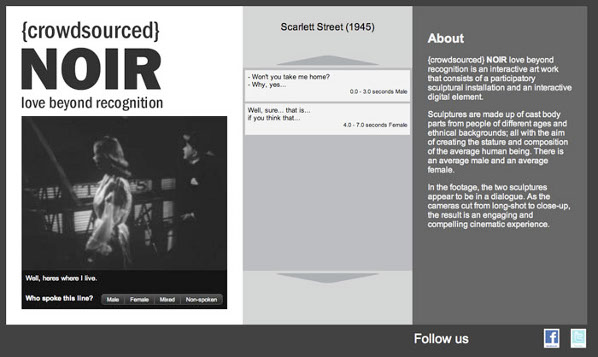
During Spring and Summer 2012, an interested public will be able to both participate and contribute to the project’s creative process in two distinct ways: in Sweden as models, whereby a cast will be taken of a chosen body part (the body parts will later be assembled to full figure sculptures) and in the UK by taking part in a workshop at Furtherfield Gallery to help source short clips from the Online Public Domain Film Noir Archive through our online tool. The final iteration of the project will be exhibited in Gothenburg, Sweden in December 2012 with live interactive streams at Furtherfield Gallery, London.
Josefina Posch
Josefina Posch is a Swedish artist that has worked and exhibited extensively abroad, including at the 52nd Venice Biennale, Fondazione Pistoletto’s Cittadellarte, Sculpturespace NY and a residency at Duolun Museum of Modern Art Shanghai. During her 3 month residency at Art Space, Portsmouth, in Autumn 2010, she began her collaboration with artist and new media developer Mike Blackman in the development of her digital concepts.
The project is supported by Arts Council England/British Council and the Gothenburg City Arts Council.
We are collecting childhood rhymes from around the world spoken by many generations of local residents of the borough for a sound installation as part of the Cultural Olympiad Festival.
Please come to Furtherfield Gallery in Finsbury Park on Saturday 21 July, 11-3pm to take part!
See images of the launch on Flickr.
Artist and composer Michael Szpakowski has worked with local children and their families to create a generative sound sculpture that invokes the collective memory of childhood, drawing on the memories of Haringey residents from all over the world.
A collective memory of childhood will be launched on Saturday 28 July 2012, 2-5pm.
To add your voice to this sound installation come to the gallery on Saturday 21 July between 11am and 3pm. You will meet the artist Michael Szpakowski who will be recording with you and other local residents any childhood rhymes, skipping songs or lullabies.
+ For more information please contact Ale Scapin
Michael Szpakowski is an artist, composer and film-maker who devises and facilitates many of our Outreach projects with young people. Participants create films, games and performances that explore the tools and processes of co-co-creation in a digitally connected world. The work engages young people, meeting them where they are in a constructive, imaginative and inclusive way. With DVcam in hand he finds poetry in the everyday, music in a London pavement and if called upon could find a way to inspire the imaginations of curbstones with his enthusiasm, experience and skill-sharing abilities.
www.somedancersandmusicians.com
Featured image: “Born in 1987: The Animated GIF” from the site’s page.
Marc Garrett interviews Katrina Sluis, the new curator of the Digital Programme at The Photographers’ Gallery, London. We discuss about the gallery’s recent show Born in 1987: The Animated GIF and what kind of digital exhibitions and projects we can expect from the gallery in the Future.
An edited selection shown on the London Photographers’ Gallery’s new digital wall, during the final weeks of the show. http://thephotographersgallery.org.uk/the-wall-2
The exhibition microsite. An open conversation where anyone can join in and contribute their own GIFs. http://joyofgif.tumblr.com/
Marc garrett: You have joined The Photographers’ Gallery and as part of the new digital programme launched the exhibition “Born in 1987: The Animated GIF”. Could you tell us about this project?
Katrina Sluis: The digital programme presents projects both online and offline, which respond to recent dramatic shifts in the digital image as it becomes increasingly screen-based and networked. As part of this new programme we have launched ‘The Wall’ – a permanent exhibition space on the ground floor of the Gallery, visible both to visitors and passersby on Ramillies street. The Wall itself is a 2.7 x 3m Sharp video wall which we installed after considering a number of different technologies. We were conscious not to use digital projection as it would locate the project within traditions of cinema and video art, and we wanted the screens to respond to the reception and distribution of images within wider visual culture.
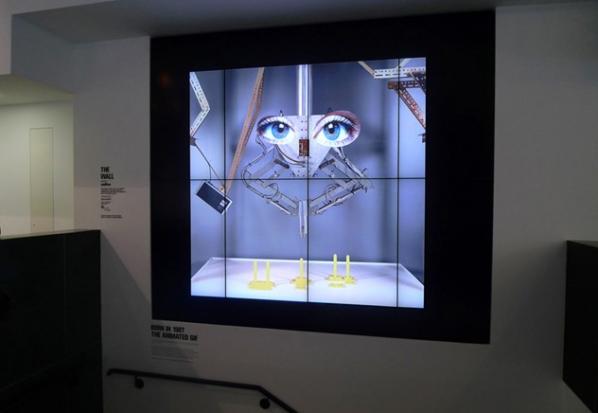
For the opening show, we decided to focus on the animated gif for a number of reasons. Firstly, the gif is a uniquely screen-based image format, in which the specific characteristics and limitations of the image file are inherent to the form, in contrast to the other kinds of images the gallery might show which might adopt digital techniques but result in traditional print-based photographic work destined for the gallery space.
I also wanted to disrupt certain expectations about the screens – the fetishisation of resolution and image quality, and what kinds of photographs The Wall’s programme might seek to address. The animated gif in this sense is very interesting – it is one of the first image file formats native to the web, and although it is 25 years old this year it has been undergoing a resurgence on platforms such as Tumblr. In a commissioned essay for the show, Daniel Rubinstein speculates that current resurgence of the gif “is not only part of the nostalgic turn towards the blurred, the unsharp and the faded but it is also a marker of a moment when the history of the network becomes the material from which the digital image draws its living energy.”[1] Frequently authorless and contextless, the gif image works on a different economy in which its value is based not on its uniqueness and scarcity (as in certain forms of art) but its circulation and proliferation. Although there have been significant practitioners of the gif form, it is a format which ultimately resists canonization. And, in the context of a photography gallery, it opens up other debates concerning medium specificity and the ‘post-photographic’.
In approaching the exhibition, I was keen to ask a diverse range of photographers, writers, organizations and other practitioners to contribute a gif for the show. In keeping with the unmonumental nature of the form, I asked contributors to respond within a short timeframe of 7 days. For many contributors, this was the first time they had made a gif; but other contributors already had large followings on Tumblr and some were established net artists. This opening show and associated Tumblr site (http://joyofgif.tumblr.com) became a starting proposition for the project in order to then open up The Wall to gif contributions from the wider public. We will continue to update The Wall with public responses on a daily basis until the final day of the show on 10th July.
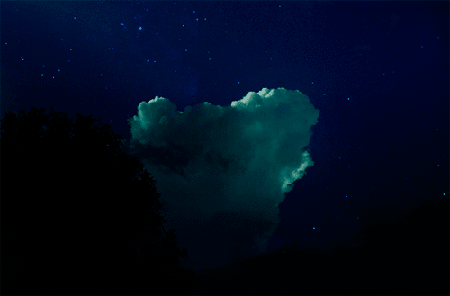
MG: At first, some may assume that the first part of the exhibition title ‘Born in 1987’, refers to the fact that today so many young people using computers these days were born in 1987. Yet, the GIF format, short for ‘Graphics Interchange Format’, was introduced to the world of computers by CompuServe in 1987. Was the title of the show deliberately playing with both notions?
KS: I like this idea! The title does self consciously play with the way in which the digital is valorised for its endless ‘newness’ and novelty but yet has this long and frequently overlooked history of creative experimentation. You can also see this reflected in the recent hype around the work of Kevin Burg and Jamie Beck who have (problematically and entrepreneurially) re-branded the gif as the ‘cinemagraph’.
MG: Do you consider this project to be net art, if so, how does it relate to other forms of net art?
KS: The project (and The Wall’s programming) does pose certain problems as it seeks to relocate certain forms of online practice(s) into the space of the art museum. At the same time, the project exists in an online context with its own very different life on Tumbr, where the work circulates in a very different context with a very different audience. I think there are many interesting opportunities which emerge from this intersection of the institutional frame of the museum (with its associated issues of cultural and curatorial authority and the legacy of aesthetic modernism) and the values and politics which inform certain kinds of networked arts practices.
But I also think the project also needs to be understood in the specific context of The Photographers’ Gallery, its history and audience. Whilst the project shares the concerns of net art by raising questions concerning authenticity, authorship and ‘the social’, it is also motivated by the need to rethink familiar notions of photography and temporality, indexicality and the economy of the image – concerns which presently haunt the field of photography theory.
![Kennard Phillipps. GIF image by Peter Kennard and Cat Phillipps. Born in 1987: The Animated GIF. The Photographers' Gallery 2012 [2]](http://www.furtherfield.org/wp-content/uploads/2012/07/fuck-the-markets-latest1.gif)
![Rad Racer glitch 3. GIF image by tracekaiser. Born in 1987: The Animated GIF. The Photographers' Gallery. 2012 [3]](http://www.furtherfield.org/wp-content/uploads/2012/07/tumblr_m5tqfl62wl1qew2moo1_400.gif)
MG: In what way do you see this form of creativity relating to others who may not be so well versed with net art culture, or digital networked practices?
KS: The Wall presents an opportunity for the Gallery to collaborate with diverse communities who can bring their distinct expertise and experiences to the programme, and the net art community has much to offer in this respect. For this reason, we aim to develop The Wall’s future programme through the framework of ‘collaborative research’, in which our audience, along with the organizations we partner with, are potential co-researchers. The co-researcher model developed as an approach to research democracy in the Social Sciences, particularly in the approach of Action Research in the NHS but in a more relevant cultural example was used extensively in the Tate Encounters: Britishness and Visual Culture research project. Co-research recognises both the collaborative and collective nature of meaning construction, through a process which attempts to trace and reveal the complex manufacture of meaning.
At the same time, there is still another related project to be done in highlighting and responding to digital projects whose life is online – this is of course something I admire Furtherfield for doing so brilliantly. On a smaller scale and with a more narrow focus, we hope to launch a blog which will draw attention to online work which relate to photography as it becomes polluted, valorized, hybridized and networked.
![GIF image by Paul Flannery. Born in 1987: The Animated GIF. The Photographers' Gallery. 2012 [4]](http://www.furtherfield.org/wp-content/uploads/2012/07/tumblr_m442xish4q1rvlji4o1_500b_0.gif)
MG: Some, may view this this exhibition as relating to Internet Folk Art. There is an interesting article by Kenneth Goldsmith[1] where he discusses the digital theorist Rick Prelinger’s claim “that archiving is the new folk art, something that is widely practiced and has unconsciously become integrated into a great many people’s lives, potentially transforming a necessity into a work of art.”
Now, this is not directly relating to the show itself, but it resonates something regarding the inclusiveness of the show. So, in respect of it ‘possibly’ possessing aspects of Folk Art, what connections do you see as relevant or not, and what does it mean to you?
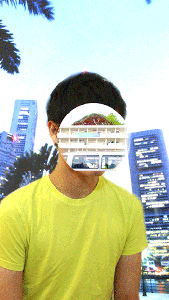
KS: By focusing on the gif the show does problematise the distinction between artist and audience, in which participation, openness and the ‘crafting’ of the image becomes key. However I have reservations about the use of the term Internet folk art, which could be construed as imposing a certain modernist logic on the discussion, burdening it with an analogue modeling of high and low culture. The research approach has been adopted precisely to avoid the trap of binary nominalism, and to problematise the tendency to shoe horn internet practices into the language of cultural studies and aesthetics.
MG: The Photographers’ Gallery was the first independent gallery in Britain devoted to photography and has been going since the 70s. It is the UK’s primary venue for photography and has been dedicated in establishing photography as an essential medium, representing its practice in culture and society. It seems that The Photographers’ Gallery is going through another transition. You have already mentioned how hybridized and networked the nature of future projects will be. So what kind of exhibitions and projects can we expect in the future?
KS: Because digital technology is not in itself a new photographic medium, but essentially a hybrid and converged set of technological practices, it raises many interesting problems, both theoretical and practical for a Gallery focused on photography. To the computer, the photograph is indistinguishable from the other binary blobs of data we used to call books, films and songs. The crisis of digitization and medium specificity now extends to the domain of the camera – Digital SLRs are coveted for their ability to shoot high quality digital video, and we turn to our mobile phones when we want to take snapshots. This is a very rich context for the programme to explore, and ideally the future projects will respond to the technical, creative and cultural languages of photography as produced by computer engineers, web developers, photographers, artists, networked communities, social scientists and other practitioners.
Our next show on The Wall (opening 13th July) features the practice based research of Susan Sloan into portraiture using motion capture and 3D animation techniques widely used in entertainment, medicine and the military. Her motion studies refer to the traditions and conventions of portraiture and the changing role of the camera as a recording device. At the same time, her work raises questions concerning the convergence of painting, animation, film and photography in the digital realm.
The future digital programme which will occupy different spaces and address various photographic practices including augmented reality, social media, electronic publishing, interactive media, mobile computing and synthetic imaging.
The Joy of GIF – the London Photographers’ Gallery’s new digital wall. Article by Wendy McMurdo.
http://www.foam.org/foam-blog/2012/may/photographers-gallery
Sign up: ale[at]furtherfield.org
See images of the walk on Flickr.
Public exploratory radiation walk around Finsbury Park, measuring mobile phone radiation levels and discovering what type of radiations we are exposed to on a daily basis. As we walk, we will unravel a parallel, hidden story of the local area along with technical data and possible medical effects of the radiation. Participants will measure radiation levels, GPS positions and marked levels on a large map of the area, creating a collaborative artwork (poster sized map of local radiation) to be made available for display as part of the exhibition after the event.
Participants are encouraged to listen to the sounds we will be hunting for (GSM, 3G, Tetra) here.
Dave Miller
Dave Miller is a South London based artist and currently a Research Fellow in Augmented Reality at the University of Bedfordshire. Through his art practice Dave draws out the invisible forces that make life difficult. His work is about caring and being angry, as an artist. His art enables him to express feelings about the world, to attempt to explain things in a meaningful, yet subjective way, and make complexed information accessible. Recurrent themes in his work are: human stories, injustices, contentious issues and campaigning. Recently he’s been very bothered by the financial crisis.
+ Finsbury Park Radiation Walk is part of Invisible Forces at Furtherfield Gallery.
+ More Invisible Forces events.
3 Keys – The River Oracle by the Hexists is the opening act of the Moving Forest 12 hour performance.
+ Listen to the sounds of Act 0 ‘Omen’ for the Moving Forest London 2012
1. Introduction ‘Output 1’
2. Omen Section 1 ‘Output 3 and 4’
3. Omen Section 1 ‘Output 5’
+ And download the score for the Hackney Brook.
Cybernetic systems and game theory are about anticipating and influencing human behaviour using algorithmic code, databases, social media etc – the industries of data-mining, data profiling and data protection can be said to be the new ‘magic’ by which biopolitical control of our bodies and identities is maintained.
3 Keys – The River Oracle with The Hexists is a game of chance and divination in association with The Moving Forest, Act 0. It attempts to invoke the relationship between the divinatory functions of our contemporary ‘influencing machines’ (cybernetic systems and game theory using data-mining, data profiling and data protection) and traditional magical ones, creating new machines in the process. Using tools such as cards, dowsing, stick throwing to interpret phenomena in the landscape, historical and current, ‘readings’ can be cast, allowing associative action, language and thought to determine what might happen in the future, to create a path, an artwork.
In 3 Keys (version 3), participants will follow the Hackney Brook, an old subterranean river that begins near Finsbury Park and ends up in the River Lea near the site of the Olympics, using different exercises to interpret the landscape and cast readings. We will ‘mark’ the route along the way with objects and stories and other inscriptions. The river is the oracle and we are the transmisson. The documentation and divination tools will be made available for display in the exhibition after the event.
IMAGES FROM THE WALK ON FLICKR
Rachel Baker
(The Hexists)
Rachel Baker is a network artist who collaborated on the influential irational.org. Her art practice explores techniques used in contemporary marketing to gather and distribute data for the purposes of manipulation and propaganda. Networks of all kinds are “sites” for Baker’s public and private distributed art practice, including radio combined with Internet (Net.radio), mobile phones and SMS messaging, and rail networks.
Kayle Brandon
(The Hexists)
Kayle Brandon is a inter-disciplinary Artist/researcher, whose work is sited within the public, social realm. She predominantly works in collaborative and collective fields; a working method which informs much of her ethos around the making of art. Her main areas of interest are in the relationships between the natural and urban worlds and Human/Non-human relations. She investigates this field via physical intelligence, provocative intervention, observation, self-guided exploration and collective experiences.
First presented at Transmediale.08. Berlin 2008, Moving Forest London maps an imaginary castle and a camouflaged forest revolt onto the hyper-playground of the London metropolis on the eve of Olympics 2012. Presented by a temporarily assembled troupe AKA the castle, Moving Forest brings together diverse visual/sonic/electronic/digital/ performance artists along with writers, walkers, coders, hackers, mobile agents, twitters, networkers and the general public to realize a contemporary version of a classic play.
http://www.movingforest.net/
DOWNLOAD A PRESS RELEASE HERE
+ 3 Keys – The River Oracle is part of Invisible Forces at Furtherfield Gallery.
+ More Invisible Forces events.
The insights of American anarchist ecologist Murray Bookchin, into environmental crisis, hinge on a social conception of ecology that problematises the role of domination in culture. His ideas become increasingly relevant to those working with digital technologies in the post-industrial information age, as big business daily develops new tools and techniques to exploit our sociality across high-speed networks (digital and physical). According to Bookchin our fragile ecological state is bound up with a social pathology. Hierarchical systems and class relationships so thoroughly permeate contemporary human society that the idea of dominating the environment (in order to extract natural resources or to minimise disruption to our daily schedules of work and leisure) seems perfectly natural in spite of the catastrophic consequences for future life on earth (Bookchin 1991). Strategies for economic, technical and social innovation that fixate on establishing ever more efficient and productive systems of control and growth, deployed by fewer, more centralised agents have been shown conclusively to be both unjust and environmentally unsustainable (Jackson 2009). Humanity needs new strategies for social and material renewal and to develop more diverse and lively ecologies of ideas, occupations and values.
In critical media art culture, where artistic and technical cultures intersect, alternative perspectives are emerging in the context of the collapsing natural environment and financial markets; alternatives to those produced (on the one hand) by established ‘high’ art-world markets and institutions and (on the other) the network of ubiquitous user owned devices and corporate social media. The dominating effects of centralised systems are disturbed by more distributed, collaborative forms of creativity. Artists play within and across contemporary networks (digital, social and physical) disrupting business as usual and embedded habits and attitudes of techno-consumerism. Contemporary cultural infrastructures (institutional and technical), their systems and protocols are taken as the materials and context for artistic and social production in the form of critical play, investigation and manipulation.
This essay presents We Won’t Fly for Art, a media art project initiated by artists Marc Garrett and I in April 2009 in which we used online social networks to activate the rhetoric of Gustav Metzger’s earlier protest work Reduce Art Flights (from 2007) in order to reduce art-world-generated carbon emissions... Download full text (pdf- 88Kb) >
Published in PAYING ATTENTION: Towards a Critique of the Attention Economy
Special Issue of CULTURE MACHINE VOL 13 2012 by Patrick Crogan and Samuel Kinsley.
Sign up: ale[at]furtherfield.org
Saturday 23 June 2012, 1-5pm
Summer Board Games and Picnic with Class Wargames and Kimathi Donkor
Join us for a day of debate around the leader of the Haitian Revolution, Toussaint Louverture, now regarded as an important icon of anti-slavery struggles. Class Wargames interviews the artist Kimathi Donkor who created the history painting Toussaint Louverture at Bedourete to mark 200 years since the independence of Haiti. The event will kick off with a picnic in the park and continue with an afternoon of collective playing of Guy Debord’s The Game of War, a Napoleonic-era military strategy game where armies must maintain their communications structure to survive – and where victory is achieved by smashing your opponent’s supply network rather than by taking their pieces.
In a short film by Ilze Black, Dr Richard Barbrook and Fabian Tompsett of Class Wargames interview Donkor about the work. Alex Verness from Class Wargames will be documenting the day by taking xenographs of participants.
IMAGES FROM THE TALK ON FLICKR
Saturday 30 June 2012, 1-5pm
Summer Board Games and Picnic with Class Wargames
Join us for a talk about gaming the 1791-1804 Haitian Revolution led by Richard Barbrook and Fabian Tompsett of Class Wargames. The event will kick off with a picnic in the park and continue with an afternoon of collective playing of Richard Borg’s Commands & Colors, a Napoleonic-era military strategy game.
IMAGES FROM THE EVENT ON FLICKR
Class Wargames
Class Wargames is an avant-garde movement of artists, activists, and theoreticians engaged in the production of works of ludic subversion in the bureaucratic society of controlled consumption.
The members of Class Wargames are Dr. Richard Barbrook, author and senior lecturer in the Department of Politics & IR at the University of Westminster; Rod Dickinson, artist and lecturer at University of the West of England; Alex Veness, artist and co-founder of Class Wargames;Ilze Black, media artist and producer; Fabian Tompsett, initiator of London Psychogeographical Association and author; Mark Copplestone, author and figure designer; Lucy Blake, Software developer; Stefan Lutschinger, lecturer, artist and researcher; and Elena Vorontsova, World Radio Network and journalist.
Kimathi Donkor
Kimathi Donkor lives and works in London. He attained his B.A. at Goldsmiths and an M.A. at Camberwell College of Art, both in Fine Art. In 2011 he received the Derek Hill Award painting scholarship for the British School at Rome; and, in 2010, his paintings were exhibited in the 29th São Paulo Biennial, Brazil.
+ Summer Board Games and Picnic is part of Invisible Forces at Furtherfield Gallery.
+ More Invisible Forces events.
As part of the Being Social exhibition at Furtherfield Gallery in Spring 2012, Ele Carpenter and Emilie Giles facilitated embroidery sessions with gallery visitors who stitched a term from the Raqs Media Collective’s text ‘A Concise Lexicon of/for the Digital Commons’ (2003).
View images from the workshops
The Embroidered Digital Commons is a collectively stitched version of ‘A Concise Lexicon of/for the Digital Commons’ by the Raqs Media Collective (2003). The project seeks to hand-embroider the whole lexicon, term by term, through workshops and events as a practical way of close-reading and discussing the text and its current meaning.
Crafters, programmers, artists, makers, and people interested in working collaboratively, or taking part in participatory projects gathered to each stitch a few words of the term meme, as described below. The resulting patches will be turned into a short film depicting the sequence of embroideries.

In 2003 the Raqs Media Collective wrote ‘A Concise Lexicon of/for the Digital Commons’. The full lexicon is an A-Z of the interrelationship between social, digital and material space. It weaves together an evolving language of the commons that is both poetic and informative. The terms of the lexicon are: Access, Bandwidth, Code, Data, Ensemble, Fractal, Gift, Heterogeneous, Iteration, Kernal, Liminal, Meme, Nodes, Orbit, Portability, Quotidian, Rescension, Site, Tools, Ubiquity, Vector, Web, Xenophilly, Yarn, and Zone.
The concept of the digital commons is based on the potential for everything that is digital to be common to all. Like common grazing land, this can mean commonly owned, commonly accessed or commonly available. But all of these blurred positions of status and ownership have complex repercussions in the field of intellectual property and copyright. The commons has become synonymous with digital media through the discourse surrounding free and open source software and creative commons licensing. The digital commons is a response to the inherent ‘copy n paste’ reproducibility of digital data, and the cultural forms that they support. Instead of trying to restrict access, the digital commons invite open participation in the production of ideas and culture. Where culture is not something you buy, but something you do.
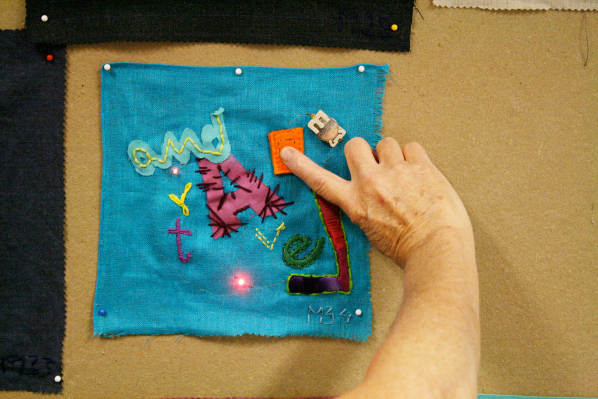
MEME
“Meme: The life form of ideas. A bad idea is a dead meme. The transience as well as the spread of ideas can be attributed to the fact that they replicate, reproduce and proliferate at high speed. Ideas, in their infectious state, are memes. Memes may be likened to those images, thoughts and ways of doing or understanding things that attach themselves, like viruses, to events, memories and experiences, often without their host or vehicle being fully aware of the fact that they are providing a location and transport to a meme. The ideas that can survive and be fertile on the harshest terrain tend to do so, because they are ready to allow for replicas of themselves, or permit frequent and far-reaching borrowals of their elements in combination with material taken from other memes. If sufficient new memes enter a system of signs, they can radically alter what is being signified. Cities are both breeding grounds and terminal wards for memes. To be a meme is a condition that every work with images and sounds could aspire towards, if it wanted to be infectious, and travel. Dispersal and infection are the key to the survival of any idea. A work with images, sounds and texts, needs to be portable and vulnerable, not static and immune, in order to be alive. It must be easy to take apart and assemble, it must be easy to translate, but difficult to paraphrase, and easy to gift. A dead meme is a bad idea.”

Ele Carpenter
Ele Carpenter is a curator based in London. Her creative and curatorial practice investigates specific socio-political cultural contexts in collaboration with artists, makers, amateurs and experts. She is a lecturer in Curating at Goldsmiths College, University of London.
Since 2005 Ele has facilitated the Open Source Embroidery project using embroidery and code as a tool to investigate the language and ethics of participatory production and distribution. The Open Source Embroidery exhibition (Furtherfield, 2008; BildMuseet Umeå Sweden, 2009; Museum of Craft and Folk Art, San Francisco, 2010) presented work by over 30 artists, including the finished Html Patchwork now on display at the National Museum of Computing at Bletchley Park. Ele is currently facilitating the ‘Embroidered Digital Commons’ a distributed embroidery exploring collective work and ownership 2008 – 2013.
Emilie Giles
Emilie Giles is an alumnus of MA Interactive Media: Critical Theory and Practice at Goldsmiths College. Since graduating in 2010 her time has been spent co-organising MzTEK, a women’s technology and arts collective, as well as completing an internship with arts group Blast Theory and working for social video distributors Unruly. She is currently involved with TESTIMONIES, a project which explores oral history in relation to the 2012 Olympic and Paralympic Games largely through social media.
Emilie’s own practice revolves around notions of pervasive gaming, married with urban exploration and psychogeography. Her most recent focus lies in taking fundamental gaming principles from Geocaching and exploring the consequences of adding an emotional dimension.
Sign up: ale[at]furtherfield.org
To accompany Invisible Forces, Furtherfield invites all gallery visitors to take part in a programme of public play, games, making and discussion led by alert and energetic artists, techies, makers and thinkers: Class Wargames, The Hexists, Dave Miller, Olga P Massanet and Thomas Aston.
Saturday 23 June 2012 – 1-5pm
Summer Board Games and Picnic with Class Wargames and Kimathi Donkor
Saturday 30 June 2012 – 1-5pm
Summer Board Games and Picnic with Class Wargames
Wednesday 04 July 2012 – 9-11am
3 Keys – The River Oracle – The Hexists
as part of Moving Forest by AKA The Castle
Wednesday 11 July 2012 – 11-5pm
Technologies of Attunement – Olga P Massanet and Thomas Cade Aston
Saturday 21 July 2012 – 2-5pm
Dave Miller’s Finsbury Park Radiation Walk
Featured image: Artist Suguru Goto discusses his work.
London 2012: there is of course one event which springs to mind when we think about this city and the year we’re in, but there is also another significant event happening in London right now, one which is very important for the digital and media arts world. It is the year that Watermans Arts Centre is holding the International Festival of Digital Art 2012.
As well as showcasing an array of digital art by internationally renowned artists, the programme also offers the opportunity for members of the public to get involved in discussions around themes that the Festival touches on through the seminar series accompanying the shows. These are in collaboration with Goldsmiths, University of London. Nearly three months in, the Festival has launched two exciting shows,Cymatics by Suguru Goto and UNITY by One-Room Shack Collective.
The first show, Cymatics, is a kinetic sound and sculpture installation that expresses Goto’s vision of nature. To enter it, the audience step through a door into a boxed, dark room within which they are presented with a touch screen interface, a shallow metal tank holding water and a screen showing a video feed of the water in the tank. The piece invites the audience to move the water in the tank by manipulating sound waves via an interactive screen. The result of the interaction is a stunning variety of geometric shapes, demonstrating the distortion that sound waves can have on a substance. This occurrence reveals the bridge between technology and nature, which fits into Goto’s re-occurring theme within his work of the relationship between man and machine.
The seminar which coincided with the show, Interactivity and Audience Engagement, was chaired by Régine Debatty and featured on the panel Tine Bech, Graeme Crowley and Tom Keene, all who which explore audience engagement in different ways within their work. Tine Bech is a visual artist and researcher whose installations invite audiences to engage in playful interactions, from chasing a motion reactive spotlight in Catch Me Nowto sound triggering shoes in Mememe. Tom Keene is an artist technologist whose focus intersects participation, communication and technology. His work is multidisciplinary, investigating the way we communicate, mediated by technology. His practice is diverse, from exploring the potential relationships between networked everyday objects in Aristotles Office to inviting a community to comment on their local issues through signs in Sign X Here. Graeme Crowley is a designer and artist who has created installations for prominent public areas, including The Wall of Light, commissioned by Arrowcroft Plc for the centre of Coventry and Spiral/Bloom commissioned for a hospital in Rochford by the NHS.
I found the juxtaposition of these three practitioners very interesting as each of them explore the interaction between audience and technology in varying ways. Bech’s work is very tactile and sculptural, almost making people forget the technology behind it. She likes to look at technology as something we can mould and which can be used to explore the wider issues which art can bring up, rather than just focussing on the tech itself and how ‘shiny’ (to use her own term) it is. In contrast to this, within Keene’s practice technology feels very prominent, visually as well as conceptually. Crowley’s focus is different again as it mostly operates within the commercial sphere. It therefore is produced for greater public consumption and needs to withstand being a permanent exhibit, becoming part of the architecture it is planted on rather than something which is temporary. The talks given by each panel member and discussions which accompanied them were all diverse and brought up interesting points around the idea of audience engagement and interactivity. Members of the audience entered into these discussions with ease, creating an open dialogue which itself was participatory and engaging.
UNITY, by One Room Shack is the current exhibit as part of the International Festival of Digital Art 2012, bringing a piece of work to the gallery which aims to embody the Olympic spirit, visually as well as conceptually.
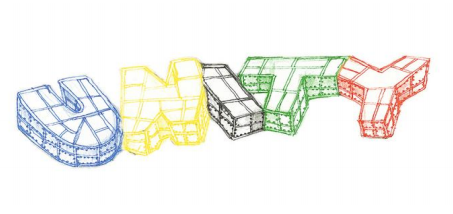
Design for Unity
The installation takes the form of a transparent maze, angular in its structure and illuminated with different coloured LED lights in each section. Each illuminated section of the structure forms a different letter, all together spelling the word ‘unity’. As the audience navigate their way through the installation, their movement is picked up by motion sensors, triggering the LEDs at each point to turn on. These each represent a particular colour of the Olympic rings.
The ideologies of the Olympic Games linked with an immersive space explores the value of ‘being together’, something which the African humanist philosophy Ubuntu also speaks about.
UNITY is effective in exploring the theoretical concepts embedded within it through a playful and simple interactive structure. As an individual you step from section to section with the different groups of LEDs individually illuminating you as you go through the work. When a group of people interact with the piece at the same time however, the piece lights up as a whole, echoing the values of being together that UNITY invites us to explore. It is through enabling this experience, that the work celebrates and explores human connections.
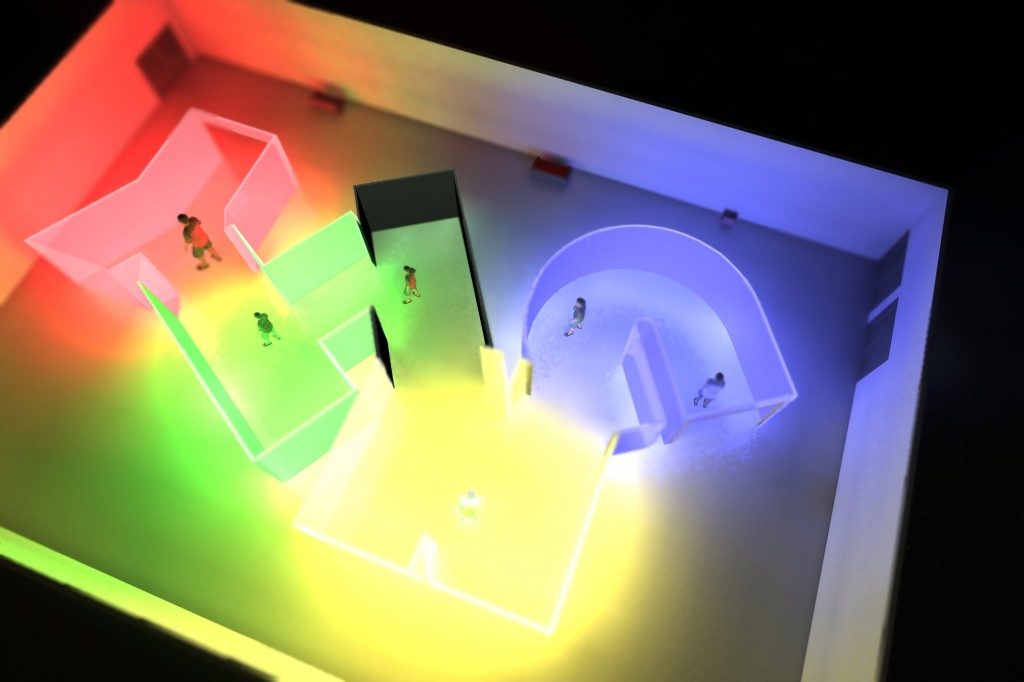
I do find it interesting how the piece has such a strong stance towards the more idealistic ideologies of the Olympics, especially when taking into account the anti Olympics sentiment present in London. The event does bring people together, but unfortunately as we’ve seen in East London and also at previous Olympic locations across the globe, they also have the ability to put local communities at risk through rising rents and eviction [1]. UNITY looks at ‘…understanding the implication of UNITY on humanism in a neo-liberal world where hyper-capitalism and love of excess trump compassion and selflessness.’ [2] but in reality, the Olympics have unfortunately become something which arguably embody these traits. This said, I do think that UNITY is an incredibly beautiful piece in its visual execution and that its interaction compliments the theoretical idea which it is looking to address.
I look forward to the remainder of the International Festival of Digital Art 2012 and the eclectic ideas within media and digital art which the programme explores. I interviewed Irini Papadimitriou, Head of New Media Arts Development at Watermans, about the Festival:
Emilie Giles: First of all, can you tell us what the premise is behind the International Festival of Digital Art 2012?
Irini Papadimitriou: The idea behind the Festival started from a decision to develop a series of shows that could form a discussion rather than being one-off exhibitions and help engage more people in the programme. In the last year we have been focusing more in participatory and/or interactive installations so I thought it’d be interesting to dedicate this project and discussions in exploring more ideas behind media artworks that invite audience engagement as a way of understanding our work in the past year.
Since this was going to take place in 2012 we felt it would be necessary to open this up to international artists so this is how the open call for submissions came up last year. We received so many great proposals it’s been very hard to reach the final selection, but at the same time the opportunity of having a year-long festival meant we could involve as many people as possible and hear many voices not only through the exhibitions (this is just one part of the Festival) but also with other parallel events such as the discussions, presentations of work in progress by younger artists and students, the publication, a Dorkboat (coming up in June with Alan Turing celebrations), as well as collaborations with other organisations or artists’ networks and online.
EG: Touching on your last answer, the Festival has a clear aim then to engage people in discussion rather than just being viewers of a show. Do you think that within media and digital art there is a particular need for this approach?
IP: I think that hearing people’s thoughts and responses and enabling discussion is important for all exhibitions and art events but specifically for the Festival (since the aim is to question & explore audience participation). It was very relevant to hear ideas and views from other artists, technologists, practitioners etc but also audiences, rather than just the participating artists.
Also, and this is my view, I think as media and digital art use technologies that many of us are not particularly familiar with or if we use technologies it will be most probably as consumers, it’s important to talk about and discuss the process (as well as impact of technologies) both for the artists as well as for audiences.
EG: The themes chosen for the programme are diverse and each relevant to media and digital art in their own way. What are the reasons for each focus and why?
IP: The themes explored in the Festival result mainly from the selected proposals and discussions with the artists. There were so many things to talk about so having these themes was a way to start from somewhere and help understand better the installations shown throughout the year. The seminars that we are organising are an opportunity for the artists to talk about their work and share their ideas with both audiences but also with other artists invited to take part in the panels. It is also a way of discussing these themes and presenting other work that raises similar issues. The seminars are shaped around the themes such as perception and magic in digital art, sound and gesture, geographies, virtual spaces as artistic mediums and of course participation and interaction. We are currently working on a publication with Leonardo Electronic Almanac which will be coming out in the next couple of months and will include essays from artists, academics and students as well as interviews with the artists behind the selected proposals. Again the catalogue has the Festival themes as a starting point but we tried to combine different content and ways of communicating these.
EG: How do the pieces featured in the exhibition question audience engagement, participation and accessibility ?
IP: The artists presenting work are exploring participation and audience engagement in different ways and I think we will have also interesting outcomes from the seminars and the publication which will allow us to explore these ideas further.
In the current installation, UNITY, One Room Shack collective are using the playful structure of a maze (in the form of the word UNITY with each letter lighting up in the colours of the Olympic rings) inviting people to walk inside to reflect and draw upon the complex nature of human reality and ‘difficult’ aspects of human existence.
Michele Barker and Anna Munster who will be showing HokusPokus later on are interested in exploring how we perceive actively in relation to our environment, how we see, what we see and how this makes us ‘interact’. HokusPokus inspired from neuroscience examines illusionistic and performative aspects of magic to explore human perception, movement and senses. The tricks shown in HokusPokus have not been digitally manipulated; they will unfold temporally and spatially, amplifying and intensifying aspects of close-up magic such as the flourish and sleight of hand.
The Festival will close with an installation by American artist Joseph Farbrook, Strata-Caster, which was created in Second Life mirroring the physical world, exploring positions of power, ownership, identity and drawing parallels between virtual and physical worlds. An interesting and important part of the installation is the use of a wheelchair by visitors to enter and navigate Strata-Caster.
EG: How have the 2012 Olympic and Paralympic Games inspired the Watermans International Festival of Digital Art?
IP: As we are trying to explore what participation is we thought it would be an interesting link (rather than inspiration) between the Festival and the Games/Cultural Olympiad since they are meant to symbolise, promote and inspire values like creativity, collaboration, participation, engagement etc. The Festival isn’t about the Olympics and participating artists didn’t have to propose work that linked to the Games, but we did receive many proposals that reflected on the Games, what they represent and the meaning of participation, so some of these proposals are being shown as part of the Festival, such as One Room Shack’s UNITY and Gail Pearce’s Going with the Flow.
How can designers and programmers work more harmoniously? How can the tools being created better meet the needs of users? There is a need for designers to have a greater role in the production of the tools that they use, aside from just reporting bugs, requesting features or designing logos for open source projects. This is where the Libre Graphics Research Unit comes in. The Libre Graphics Research Unit (LGRU) is a traveling lab where new ideas for creative tools are developed. The unit has grand aims, looking to bring aspects of open source software development to artistic practices. The programme, sponsored by many organisations in Europe, is split into four interconnected threads:
The first meeting, Networked Graphics, took place in Rotterdam from 7-10 December, 2011 and was Hosted by WORM. This second meeting, Co-Position, for which I was present, took place at venues across Brussels from 22-25 February 2012. Co-Position is described by LGRU as:
[…] an attempt to re-imagine lay-out from scratch. We will analyse the history of lay-out (from moveable type to compositing engines) in order to better understand how relations between workflow, material and media have been coded into our tools. We will look at emerging software for doing lay-out differently, but most importantly we want to sketch ideas for tools that combine elements of canvas editing, dynamic lay-out, networked lay-out, web-to-print and Print on Demand.
The meeting saw the coming together of many international artists, theorists and developers for four days of work around this subject. As some of the sessions of the meeting took place simultaneously I’m unable to give a full synopsis of the event. Instead, what is presented below are some of the key issues raised at the meeting.
The subject of copyright cannot be avoided when discussing digital art and collaborative practices. There is a definite need to foster a safe and welcoming environment for artists and designers to produce, share and remix their work. Licensing of artwork under Copyleft licences – such as Creative Commons – helps to create this environment.
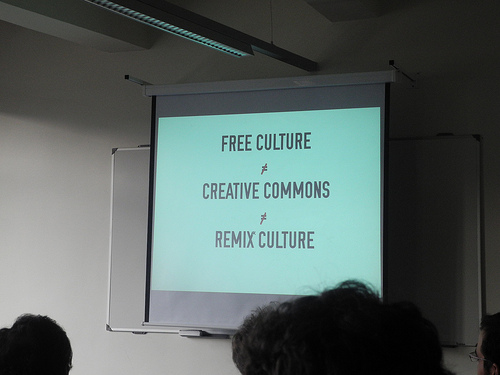
In his presentation, entitled “Libre Workflows – A Tragedy In 3 Acts”, Aymeric Mansoux was quick to point out that Creative Commons licences do not cover the source of the artwork. To put it into context, a JPG is covered by a Creative Commons licence but is the XCF/PSD file? Mansoux also considered what is actually a finished piece of artwork? In a remix culture is an artwork ever finished? Mansoux refers to this quote from Michael Szpakowski for further elaboration:
I’ve found it helpful to think of any artwork, be it literary, visual art or music as a kind of fuzzy four dimensional manifold. So the “complete” artwork is the sum of all its instances in time, and all epiphenomena. The entire artwork, seen this way, is a real and precisely enumerable sum, a concrete, not imaginary, set, which could be knowable in its entirety by something long lived and far seeing enough.
From their home town of Porto, Portugal, Ana Carvalho and Ricardo Lafuente produce Libre Graphics Magazine with ginger coons who is based in Toronto, Canada. For the production of the magazine they use Git, with their repository being hosted on Gitorious. As a tool for sharing files between collaborators Git is very useful. However, they explained that they feel they are not making effective use of all that Git has to offer. Part of this comes from the complexity of using Git. There are more than 140 commands in Git, each with their own unique function. These are usually entered via the command-line, but there are a number of programs with a Graphical User Interface (GUI) available. Programs with a GUI are usually favoured over command-line programs as they remove some of the complexity. Carvalho and Lafuente have found, however, that many of of these GUI programs simply replace commands with buttons, which doesn’t remove any of the complexity in using Git. What is needed is an easy to use specialised tool for the production of art.
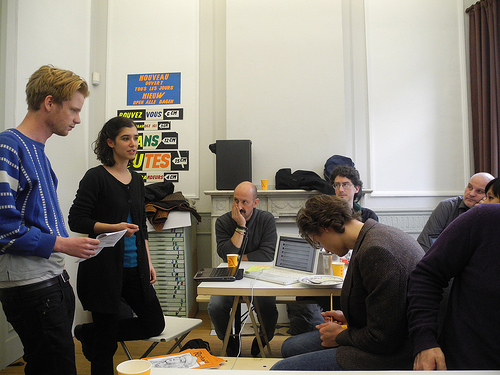
In this work session, presented by Ana Carvalho and Eric Schrijver, the work group imagined how to adapt existing version control tools to meet the needs of artists and designers. The session began by taking a look at how people currently implement version control. A common practice is to manually make backups, renaming files to differentiate between stages. This can be an effective way of making different versions, but it doesn’t address other issues such as making comparisons or merging changes. The ineffectiveness of these manual methods is soon very apparent. The work group was introduced to the Open Source Publishing (OSP) Visual Repository viewer, which begins to respond to some problems with current version control systems by providing thumbnails of files in a repository.
Using this as a basis we began to look at other functions that the OSP Visual Repository viewer should have, such as the ability to compare graphical files in different ways and to revert back to previous versions or merge versions. Although there was no time to produce working code we did seek to address the complex task of merging and comparing not only the ouput file but also the working files (svg/xcf/psd).
Every good work of software starts by scratching a developer’s personal itch.
This quote from The Cathedral and the Bazaar by Eric Steve Raymond could not be more accurate in describing the motivations behind the development of Laidout, developed by Tom Lechner, a comic artist from Portland, Oregon. Perhaps one of the most impressive software demonstrations of LGRU, Laidout is a program for laying out artwork on pages with any number of folds, which don’t even have to be rectangular.
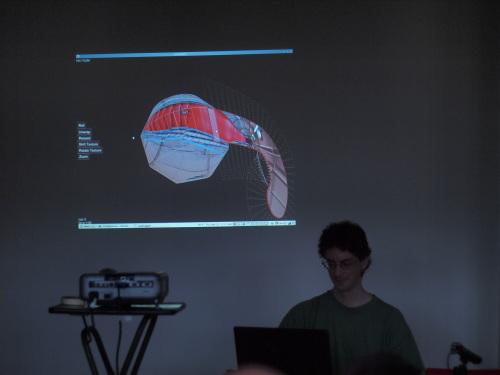
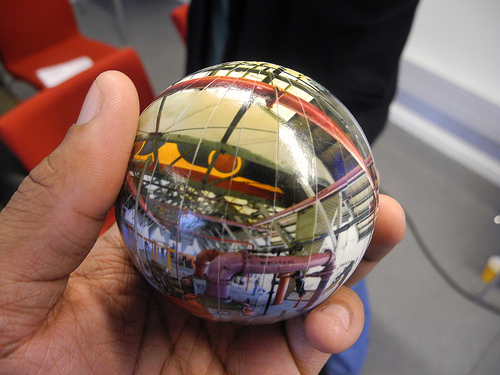
In an attempt to devise new tags that can be added to the SVG specification, Michael Murtaugh and Stephanie Villayphiou presented a work session that looked at the different ways language is interpreted by both humans and computers. To address this the work group took part in a task that saw them act as an interpreter of commands. With nothing more than a list of tags used in SVG files the work group would attempt to construct shapes.


The results varied from person to person and highlighted an important question: How can computers interpret ambiguity
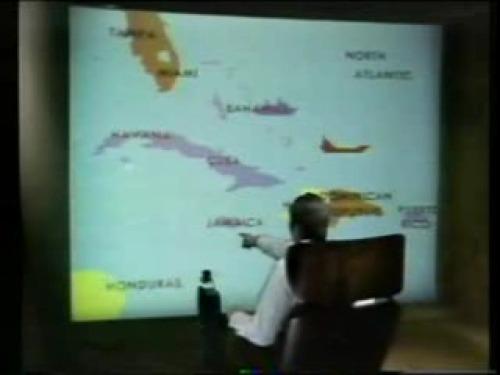
Using the Richard A Bolt “Put that there” demonstration, Murtaugh showed how human-computer interaction is still based around using very clear, unambiguous commands that can be easily interpreted by computers. In SVG only the most basic of shapes – rectangles, circles and lines – are represented. But, as the work group participants asked, could there be tags to represent more complex shapes, such as a horse?
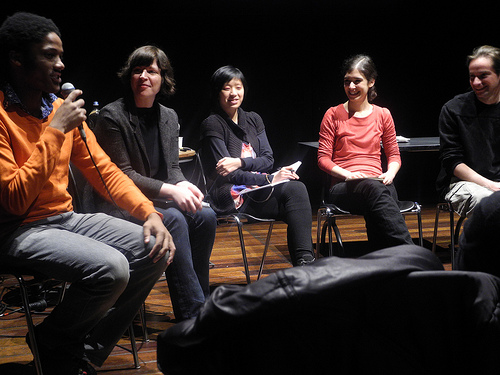
On the final day of the meeting I took part in a roundtable discussion, chaired by Angela Plohman and featuring myself, Stephanie Vilayphiou, Camille Bissuel and Ana Carvalho. The discussion first went over all that we had achieved over the four days at the meeting, and then the discussion focused on how and why we share our artwork. Expanding on the earlier quote from Szpakowski, how can we make sharing all of our artwork – including the early stages and inspirations behind it – an easier and integrated part of making artwork? In addition to sharing our final, “finished” artworks do we want to also share our processes and ideas behind the artwork? More importantly, can software easily aid this?
Other topics debated in the discussion revolved around opening up our artwork and processes to others. By opening up the development process of our artwork do we do so to invite collaborators and contributions or just observers? The Blender Open projects, for example, are highly regarded as an example of the work that can be made using open source software. The files used to make these projects are are released upon completion of the project, but the development process remains closed to the team of artists and developers. Would opening up this process to contributors add any value or could having too many ideas dilute the original vision of the project.
Although no conclusions around these topics were made, it was nonetheless important for everyone at the meeting to think critically about their practice
A concern of mine is that research is not always acted up on and exciting possibilities exist only as theory. However, I feel that the approach of Libre Graphics Research Unit, which combines research and practice, will ensure that the work undertaken at the meetings is implemented. It is actively working with developers and users to try and create solutions.
At the Co-Poistion meeting not one final product was made, but the initial vision for the future of layout was formed.
The next meeting, Piksels and Lines, takes place in Bergen, Norway and is organised by Piksel.
This show is curated jointly by Helen Sloan of SCAN and the John Hansard Gallery, Southampton. There is both curatorial interest in the technological aspects of the work as well as the subject matter of the war artist. Sloan was approached by the Arts Council in terms of initiating a project for the ‘Interact’ series of commissions, on which she worked with David Cotterrell. In 2007, Coterrell went to Afghanistan as artist-in-residence for a month in a field hospital. At his residency in 2008, at SEOS (now Rockwell Collins), a company that makes flight simulators. He explored the nature of representation itself, and particularly ‘the suspension of disbelief’. This relates to our relationship with digital data, and how often we regard it as more real, due to its nominal representation of reality and our use of this as information.
What appear to be ‘A-life critters’, are in fact scaled down human forms. Trawling across a dust-sculpted landscape, the real of the chalk dust intersects with the virtual projections of the A-life program which is mapping the movement of these forms to the reality of the sculpted landscape.
David Cotterrell doesn’t want to show pictures of the atrocities of war, but instead focuses on the complex experience of lived space in territorial combat and its mapping. He presents a kind of ‘topo-analysis’ of an imaginary space, with nominal figures located and moving in spatial relationship to one another. In Observer Effect the gallery viewer triggers the movement of the virtual entities who are attracted by a ‘sphere of influence’ to the viewers position in the gallery space. In this way, the phenomenon of space, location and relationship and the concomitant fear of combat, casualty, and mortality are implicit in the context of this exhibition.
Cotterrell has chosen to interrogate image making using technology, much as Vilém Flusser recommended, together with a lack of acceptance of the ‘normal’ indexical uses of photography and film about which he is ambivalent, although he used these media in Afghanistan.
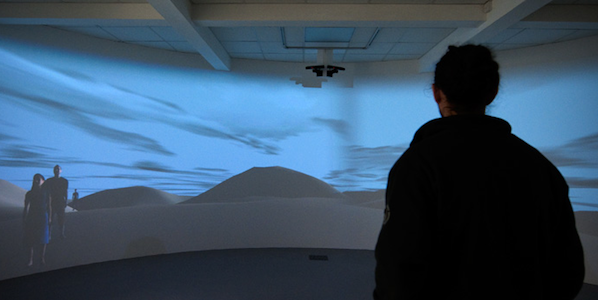
What these works achieve is the proposition of a ‘possible world’ where depersonalisation is understood as part of the virtual, nominal, mapped collective fantasy, which somehow then relates to the changing ‘world view’ of the Western citizen. It is also where the reference to science fiction comes from, ‘Monsters of the Id’ referring to the film Forbidden Planet. Science fiction is perhaps referred to in order to re-conceptualise our thinking as part of this Western view. In this sense it is about empowering us to think differently about the portrayal of conflict itself in the twenty-first century and to understand it as lived experience within specifically managed environments.
This is largely achieved through Cotterrell’s translation of his own experience as war artist in Afghanistan. He seems to want his experience to affect the viewer in a way which is different from that which he witnessed, to a reliance on the imagination instead, provoked by the portrayal of the landscape and militarised environment. Instead the exploration is one of attempting to convey the sense of isolation he felt in the military field hospital.
What becomes apparent on seeing this work, is that we are being presented with data objects, which we are then encouraged to relate to, as though they are the nominal representation of real subjects. It is significant that the work is realised with new technology. All three main works in the show explore a similar landscape but use three different projection systems. In Observer Effect the system relates to interaction with the gallery visitor who influences the installation in spatial relativity, through a device that senses and then calculates, through the algorithms and maths of a game engine, their relationship to the virtual space. Alternatively, in Searchlight 2, there is a synthesis between real and virtual as the figures traverse the landscape. He has said in relation to this piece that ‘from a great distance we lose empathy with the figures crossing the landscape’. In Apparent Horizon, the viewer encounters a semi-immersive relationship with video projected onto specially designed hemi-spheres, a view of the horizon, and a lengthy period of waiting for something to happen, which captures the tension between periods of violence. In this sense the artist has worked both as a war artist and as an artist using and developing the application of new technologies.
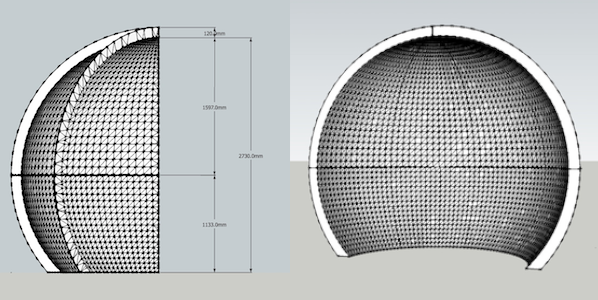
He talked about computer programming having a tendency towards ‘megalomaniac control’, and that the installation was addressed towards ‘how an audience inhabits a gallery’, with no ‘fetishizing of computers’. The residency at SEOS has obviously affected the nature of the technology employed in the work, with two ‘black boxes’ enabling aspects of the projections, as well as the hemi-spheres as immersive hardware. The system of Observer Effect is adaptive and therefore responds to the accumulated impact of viewers in the gallery. He talked about how a commercial games company would find it easy to make, but for him it had been a steep learning curve.
Cotterrell was able to return to Afghanistan in early 2008, due to support from the RSA, and was therefore able to look at the territory of the desert ‘outside the bubble of the military’, which had given him a limited understanding of the environment, a sense of dislocation, and the apprehension of casualties brought from the desert war zone. On this occasion he grew a beard and was able to disguise himself sufficiently so that he could interact with different groups of Afghani people and to gain a ‘pluralism of experience’, as on this occasion he was not part of the chain of command. In this second journey, he was ‘low value’ and therefore able to wander more freely.
Initially, he found it difficult to deliver art work in response to what he had experienced in Afghanistan. He was aware of the historical dilemma of the conflict between medicine and war. But for him, the trauma was ‘quieter’ and involved loss of identity. For example, the twenty-one year old soldier who after severe injury was ambiguous about what would happen for the rest of his life.
He found the operating theatre at the field hospital was ‘like a stage set’, and he took photographs of the surgeons, but found that the documentation ‘didn’t document’ sufficiently his lived experience. At one point he left a video camera running, documenting the arrival of casualties and then, when he was back at home, he edited the footage and left only the moments when attendant individuals ‘allowed their guard to drop’. He questioned though, whether ‘it was right to document trauma’. This left him with the ‘impossibility of conveying content’.
As war artist he has chosen to explore the military and political relationships with the technological portrayal of soldiers and civilians within a territorial combat zone. This is sufficient for Cotterrell in order to convey the sense of isolation and the particular landscape of Afghanistan. In this way, apprehending the virtual or nominal as a way of perceiving what could be real, and is real in a conflict situation, puts the viewer in a complex position, of both suspending disbelief and recognising the construct. The final work Monsters of the Id, includes in a small installation an army tent, desk and military communications equipment. This conjures up an image of Cotterrell’s experience as a war artist, although in fact it is his portrayal of how we might think of it – as naïve in other words.
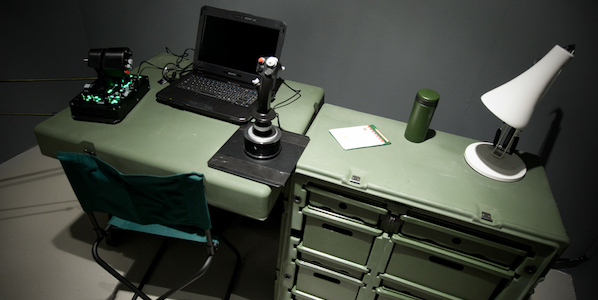
For the team of curators, gallery staff, and the artist, it has been curatorially important to work within the gallery space and Cotterrell claims that the ‘virtual can only really be understood in a gallery context.’ This is enabled through the works being not fully immersive so that you can stand back and reflect. As such the show is all about ‘the manipulation of imagery’ informed by the residencies in Afghanistan and at SEOS.
The exhibition continues till 31 March 2012 at the John Hansard Gallery, Southampton
Featured image: Martijn de Waal, co-founder of The Mobile City, introduces the conference (image courtesy Virtueel Platform)
On Feb. 17th Amsterdam hosted Social Cities of Tomorrow, a conference on new media and urbanism. Adapting its title from Ebenezer Howard’s Garden Cities of Tomorrow, but taking equal inspiration from the work of Archigram, the conference presented a snapshot of the direction cities are moving today: as conventional means of planning and designing are renegotiated through our engagement with new media technologies:
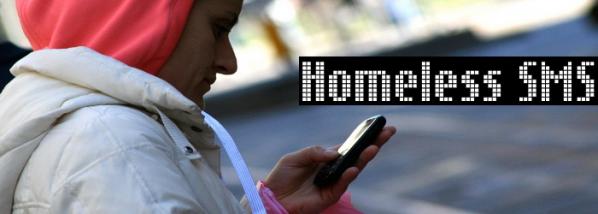
Organized by The Mobile City and Virtueel Platform, the event showcased best-practise examples of the use of media in urban analysis, design, art and activism. These ranged from “Homeless SMS”, a text-messaging system designed to provide information to the 70% of homeless Londoners who own cell phones; “Amsterdam Wastelands”, an on-line mapping of disused sites in Amsterdam and Zaanstad; “Koppelkiek”, a game project in which residents of a troubled area of Utrecht collected “couple snapshots” (in couples of friends, relatives or complete strangers), promoting social interaction through play; and “Urbanflow”, and New York-based project to rethink the contents of urban screens. In all, a dozen such projects were presented at the conference.
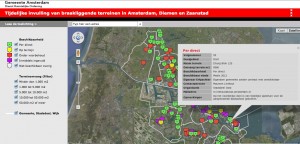

http://www.socialcitiesoftomorrow.nl/showcases
Immediately preceding the conference an intensive three-day workshop took place at ARCAM, the Amsterdam Centre for Architecture. This event brought together two dozen interdisciplinary creatives from around the world to tackle urban issues in four current case-studies: Haagse Havens, Den Haag; Zeeburgereiland; Strijp-S Eindhoven; and the Amsterdam Civic Innovator Network (a proposal to open up Amsterdam’s civic resources to distributed control by citizens). Working with local stakeholder organizations, the participants brainstormed how to leverage new media to solve intractable or new problems in these real-world sites.

http://www.socialcitiesoftomorrow.nl/workshop/the-four-cases
Also at ARCAM, a roundtable discussion on the alternative forms of trust emerging out of new media conditions was held, with panelists (below, left to right) Tim Vermeulen, Henry Mentink, Rietveld Landscape, Scott Burnham, Michiel de Lange (image courtesy Aurelie).

Keynote speakers Usman Haque, Natalie Jeremijenko, and Dan Hill concluded the conference with a panel discussion that placed the presentations in the context of distributed technology, contemporary art, social innovation, and architecture (image courtesy Virtueel Platform).

Featured image: ‘Promised Land’ design of transmediale 2k+12
Everything is not connected was the title of one of the talks organised as part of the in/compatible symposium at transmediale 2k+12 (2012), precisely the keynote speech of Graham Harman for the section titled systems. But this year’s programme of transmediale was all about connectedness, or I’d better say, about a curatorial structure of connectedness and subtle linkage.
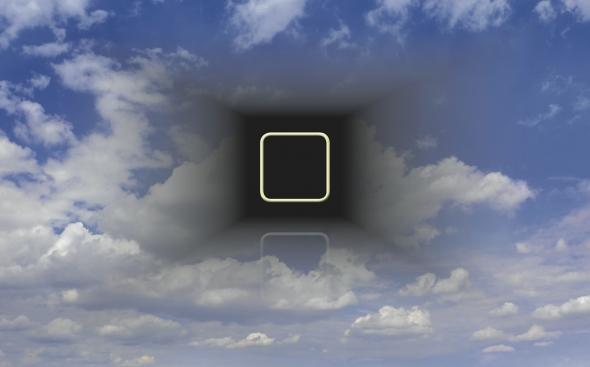
The festival’s format was one of visual and conceptual reminders, and this became evident at the very beginning and during the opening ceremony, in the auditorium of the the Haus der Kulturen on the 31st January.
At the moment of opening a power point presentation, the new artistic director Kristoffer Gansing seemed to experience a technical problem as his file would not open. A technical assistant was then called on stage to fix it, and while we all giggled and looked at each other thinking that this was somewhat like a paradox for a festival devoted to the exploration of art, technology and media culture, we soon realised that the dooming technical failure was a pretext for one of the Prepared Desktop performances by glitch-artist jon.satrom.
Thus, from the very start, we experienced what Gansing often defined as a festival which “is an incompatible being”, suggesting that the 25th edition of transmediale would be different, perhaps more oriented to a multidirectional engagement with its audience and, surely, aimed at making us aware of how much technology is intrinsically part of our everyday lives – physically, mentally and also politically. It seems that Gansing had worked towards making us feel like explorers in order to experience what he described in his curatorial statement as the “in/compatible moment”, the “moment of stasis” resulting from the clash between things that were supposed to flow and converge peacefully within a system. That unforeseeable clash generated by an incompatibility which, according to him, is to be seen (and perhaps also sensed) as a moment full of potentials, as a gap which allows a new rearrangement of the elements of a given system – be it artistic, social, economic or political.
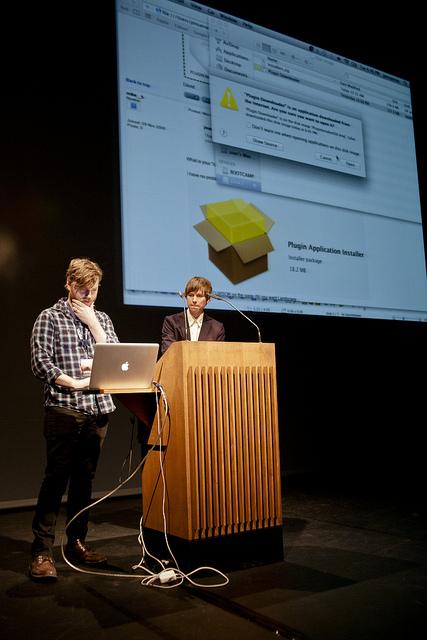
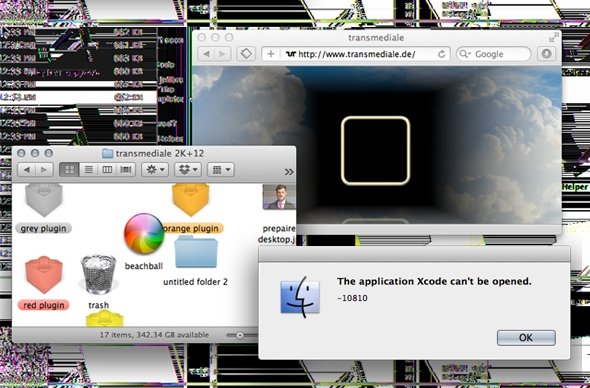
This ‘curatorial tactic’ marked the rich programme of transmediale 2012, which spanned from exhibitions to academic research networks, from online artistic interventions to talks and live performances – worth a mention is also the overall design of the festival’s contextual material, called the Promised Land design theme, which with its retro digital-pop aesthetic [1] seemed to have been devised to reinforce the idea of the clash, the tensions at work within the notion of technological convergence (“the myth” of contemporary society), starting from the very aesthetics of it.
The connectedness I mentioned above is very tangible when looking back at the main themes discussed at the in/compatible symposium – which was divided into three thematic segments:
systems, publics and aesthetics – in that they could be found as extensions across the whole programme, which in turn was developed across six sections:
1- the exhibition Dark Drives. Uneasy Energies in Technological Times curated by Jacob Lillemose
2- The Ghost in the Machine performance programme curated by Sandra Nauman
3- the video programme Satellite Stories curated by Marcel Schwierin
4- 25 Years, a series of events, amongst which talks and video screenings, about “areas of conflict between old and new” that were devised to mark the 25th anniversary of the festival
5- Featured Projects, a series of special parallel projects, such as web-based and site-specific
interventions
6- last but not least, the new addition of reSource for transmedial culture, an “interface between the cultural production of art festivals and collaborative networks of art and technology, hacktivism and politics” presented as a series of ongoing events (workshops, discussions, lectures and performative interventions) curated by Tatiana Bazzichelli.
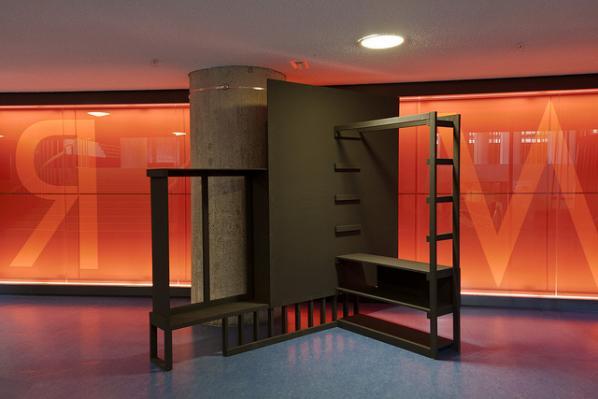
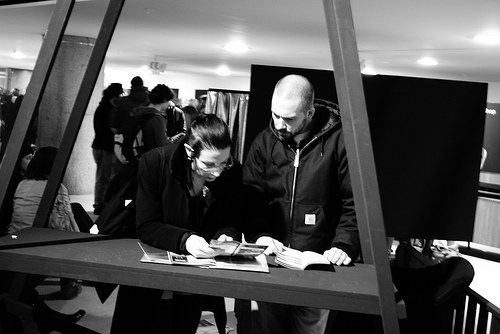
Taking a step back to look at the overall thematic framework of the festival before digging into the specifics of each programme, what should be emphasised is the effort that was made to strengthen the transdisciplinary nature of the festival as a whole. In fact, each section of the programme inserted itself into the wider discourse of cultural production; putting a stress on how deeply technology is intertwined with the every day while looking at the relationship between art and technology from a socio-economic and political perspective that was permeated by an historical orientation. And the latter is precisely what makes this 25th edition different from those I had experienced before.
Gainsing’s perspective – as it was often stated by his collaborators throughout the festival – is that of a media archeologist; and in this sense he occupies a specific place in the media theory-scape of the city of Berlin, which houses the Institute for Time Based Media (Berlin University of Arts) where Siegfried Zielinski is the Chair of Media Theory. As many might know, Zielinski is the theorist who coined the term (or better still, founded the field of) media archaeology with his book Deep Time of the Media (MIT Press, 2002). I would then say that the methodological approach of the artistic director, as well as that of the four festival’s curators, was the one which looks at a present “linked to a past pointing at a possible future”, adopting a perspective that is different and finds “something new in the old” rather than seeking “the old in the new” (quotes from Zielinski, 2002). This is probably the reason of the festival’s holistic character, of the existence of critical and aesthetic linkage between the various panel discussions and performances, research projects and art installations.
This year’s symposium, across three different but converging angles, looked at the tension between functionality and disruption in order to address how the gap existing between the two has been (and could be) “productively used” by artists, as well as by society at large, in relation to available technology – mostly digital and web-related.
The strong connection existing between all panels – grouped under systems, chaired by Christopher Salter; publics, chaired by Krystian Woznicki; aesthetics, chaired by Rosa Menkman– was given by the historical approach of their explorations into the present. Their positions were those according to which it is not technology that impacts society, but it is almost the reversal: it is society – and artists – who, with their behaviours and actions, transform it, generating a new language and new possibilities within established systems, or failing systems. One way to embrace this type of perspective was described by Graham Harman in his keynote speech: it is through differentiating “between background and foreground” and bringing the latter “into consideration”, through accepting obsolescence as something inherent to the state of the technological thing and through embracing the fact that mediums change, that new ways of thinking and understanding reality can be established.
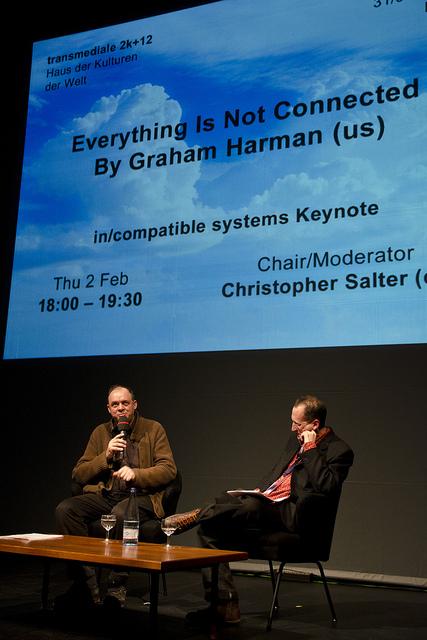
In this regard, the in/compatible aesthetics panels brought about interesting paradoxes in relation to media archeology and technological historicism, such as the necessity to move away from nostalgia for the past and avoid what could perhaps be termed as techno-romanticism. Through a series of panels, spanning from Uncorporated Subversion. Tactics, Glitches, Archeologies to Unstable and Vernacular. Vulgar and Trivial Articulations of Networked Communication, this section of the symposium presented a variegated array of artistic and research practices (from artist Olia Lialina to media theorist Jussi Parikka) that are concerned with establishing methods for challenging given systems, their codes and protocols, in order to establish new languages and modes of operation. All of them presented different artistic scenarios embedded in current socio-cultural frameworks, stressing the fact that “cultural history is shaped by users more than its inventors” (quote from artist and programmer Dragan Espenschied‘s presentation during the Unstable and Vernacular panel).
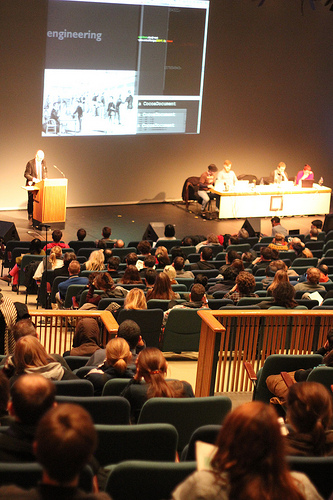
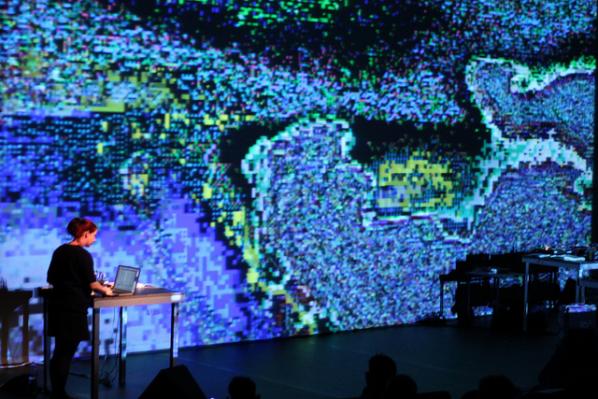
The publics section dealt with “forms of activism and social resistance” that emerge from incompatibility with the economic-political systems. In the instance of the Norifumi Ogawa in his talk Social Media in Disaster, during which he gave a very detailed insight into the “productive and effective” uses of social media during the recent Japanese earthquake and the consequent accidents at the Fukushima’s nuclear plant.
According to the exhibition curator Jacob Lillemose, Dark Drives “explores the idea that uneasy energies exist in technological times” and offers “a thematic reading and an historical mapping of the last fifty years, expressing a critical attitude to existing phenomena as well as exploring possibilities of reinvention”. And it does so with “no promise of overcoming” them (quotes from Lillemose’s curatorial statement).
In fact, the exhibition included works by 36 artists spanning different cultural fields as well as periods. The inclusions ranged from Ant Farm’s Media Burn, Chris Burden’s Doorway to Heaven and William S. Burroughs/Antony Balch’s The Cut-Ups (late 60s and 70s) to Art 404’s 5 Million Dollars 1 Terabyte, Constant Dullaart’s Re: Deep Water Horizon (HEALED) and jon.sotrom’s QTzrk (2010/2011), all while moving through the practices of artists attached to the net.art movement, such as Heath Bunting’s Skint – The Internet Beggar and JODI – the latter with a new light installation, LED PH16/1R1G1B, dated 2011–. Included were also works produced in the 80s by music bands like SPK with their Information Overload Unit. Not only, but the show also presented works which are usually not associated with the conventional art circuit, such as the TV programme Web Warriors produced by Christopher Zimmer (2008) and the music video Come to Daddy by Chris Cunningham/Aphex Twin (1997), along with, as a reversal, old(er) media-oriented work, such as the series of computer prints Leaves by Sture Johannesson, which can be read as early pieces of conceptual art.
This condensed list is to say that the amount of artistic and cultural material on display in the exhibition and the trajectories that it opened were broad to such an extent that Dark Drives functioned more as a general narrative survey than a show with a clear proposition. It was a survey of how uneasy energies might materialise as consequences of the modes and methods in which technology is used and understood, with no much distinction drawn between technology in electronic, computational or digital times.
Dark Drives did not aim to address further its initial statement, nor to narrow down the kind of relationships (and their reasons) between historical instances and contemporary ones; and from my perspective this was its flaw. However, this is the kind of exhibition that a festival like transmediale eventually needed, because to my knowledge this sort of display and curatorial approach had not been presented before: an exhibition which finally embraced the inclusion, with no hierarchies or differentiation in terms of choices of display, of works conventionally shown in gallery spaces along with those traditionally related to (ahem) the still-existing ‘niche of new-media experts’.
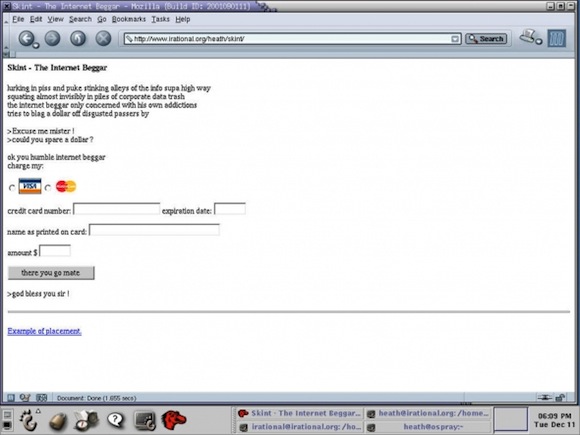
Dark Drives might not be a very daring exhibition if placed outside the context of a media art festival like transmediale, but it is certainly almost subversive in this context, and in comparison with its precedents. The exhibition installation was clever and atmospheric and, as it was for the festival’s format, it was dotted by visual and aesthetic reminders. I’ll give you an example amongst many and various ones that you could have spotted in the show: formulas by Peter Luining (2005), which is a video about manipulating a screen-grabbed image in Photoshop till it becomes a black screen, was shown just a work before jon.sotrom’s Qtzrk (2011), another video based on the process of image deformation – in this case through the use of QuickTime 7; the latter, was, in turn, shown just another work before Heath Bunting’s Skint – The Internet Beggar (1996), a website that operates as a service through exploiting the potentials offered by the network system. The three works all adopted the framework of computer desktop as a display platform for their artistic interventions, but also as a production space. And although each artist’s agenda and research area were different, their proximity made these distinguishing elements more evident, highlighting various ways of activating modes of production that diverge from those of the system within which these artists operate.
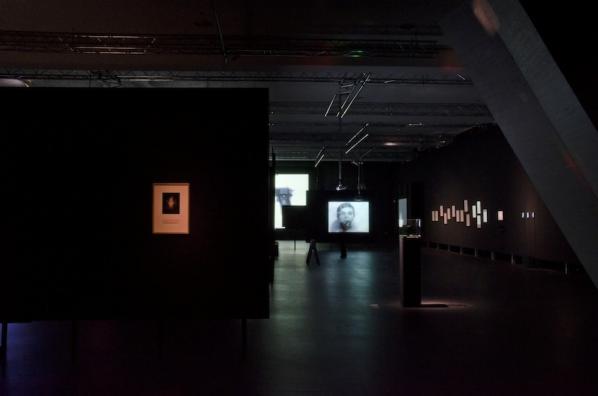
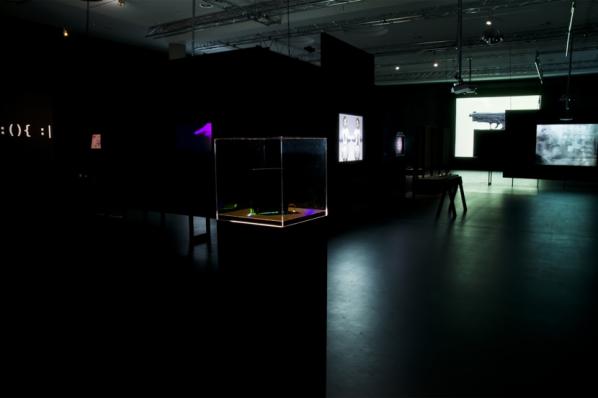
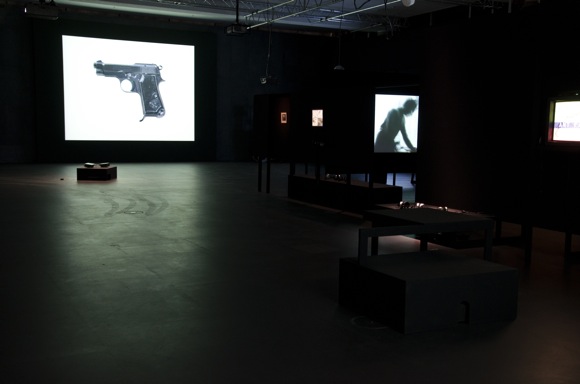
Similarly to what I have just described, it was Dark Drives as a whole that guided the visitor all the way through its display towards specific thematic directions, which were suggested by the installation in conjunction with the many visual and aesthetic links. But simultaneously, the visitor would also be free to follow the other and many trajectories arising from the content of each specific work, and this flexibility made the exhibition an attractive narrative territory ready to be employed for further explorations.
This section of the programme has been devised as an ongoing project by curator and researcher reSource is an initiative that started before transmediale festival with the gathering of an international network of PhD researchers for a conference and workshop held at the University of Arts in Berlin last November. The outcome of this collaborative network was launched on the second day of the festival, in the form of a research newspaper titled World of the News – Thank you & Goodbye . This newspaper operates as a platform in which an array of researcher, most of whom practising artists, presented a series of essays and interviews looking at the “unresolved questions and paradoxes of media technology” and how they might impact (and redefine) not only artistic production but also research processes and academic conventions, such as peer-review systems or the definition of what is currently accepted as ‘proper research’ within the academia.
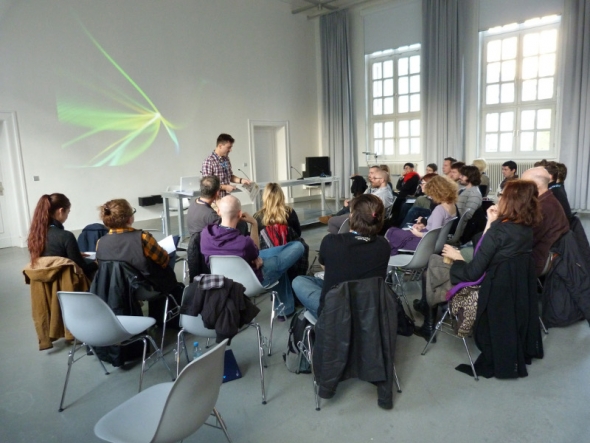
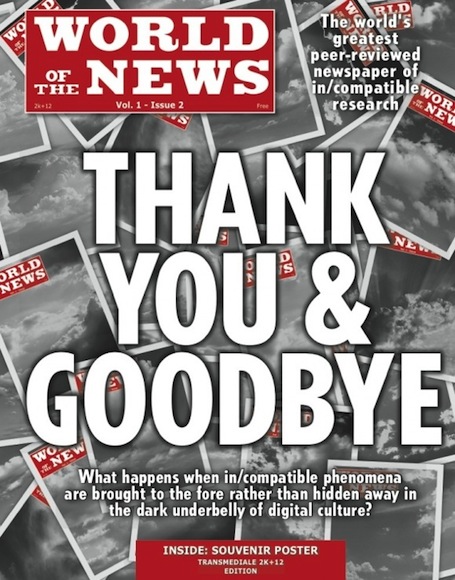
World of the News gathers a very well-thought through research material, and it does challenge academic formats, bringing forth the necessity (and preciousness) of collaboration and dialogues across disciplines, forms and formats.
The above is only one of the activities that were part of reSource; in fact, its programme was divided into five different sub-themes, Methods, Activism, Networks, Markets and Sex, each of which ranged from panels to presentations and workshops.
One of the proposed panel was titled Coded Cultures – Sub-Curatorship Beyond Media Arts and drew on a previous event organised by the group 5uper.net in Vienna, Coded Culture: The City as Interface (2011). Although aimed at addressing questions about curatorship and media art festivals, thus the public sphere, I wonder why curatorship as a practice within the field of new media and, supposedly within what was termed as “beyond new media art”, were not discussed more in depth, especially given the changes that transmediale exhibition itself proposed. If Joasia Krysa presented her specific approach to curating as a system that is informed by technology and thus embraces its inherent systems, like software codes and protocols of Internet and digital technology, in order to change the hierarchy of power; the other invited curators seemed to lack a depth in the discourse. The whole panel unfortunately stranded in general statements such as “technology changes the role of the curator” or “the curator does not want to define itself as a curator anymore, but as a coordinator and a producer”; a cliched conversation that – opportunely – ended with Krysa throwing on the table of discussion Christine Paul’s definition of “curator as filter feeder”.
Many other were the events presented at transmediale, such as the visually stunning, and purely analogue, performance of Joshua Light Show for the The Ghost in the Machine performance programme . At different times during the week of the festival Joshua Light Show performed with different musicians, such as the one man band Oneohtrix Point Never, bringing to light the beauty and magic that old(er) media can (still) give to a public of a “transmedial” festival.
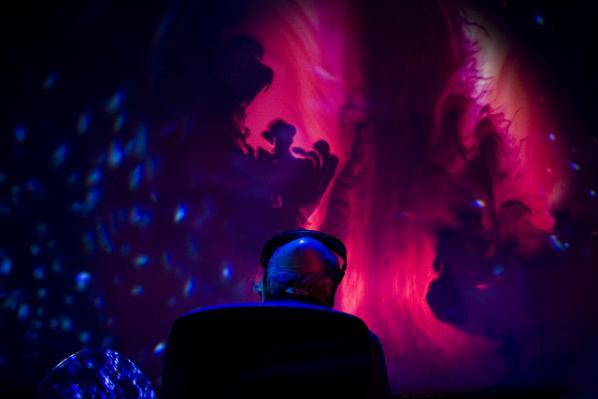
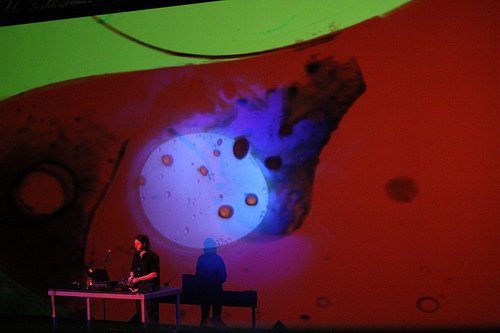
As a final round-up, it is also to be noticed that in/compatible embraced slightly more extensively the sphere of online production and distribution, specifically in conjunction with the 25 Years, Satellite Stories and Featured Projects programmes.
If when browsing the transmediale website you experience some strange episodes, such as pages merging into each other when scrolling up and down, that is because of a site-specific intervention by Danja Vasiliev and Gottfried Haider – the developers of a Content Manipulation System called HOTGLUE which allows to construct websites directly in a web-browser.
Also as part of 25 Years there was a video installation <collaborative documenting / archiving on netart.activities> initiated by artist Constant Dullart and art historian and artist Robert Sakrowski. The duo had devised an open database system which employes YouTube as a repository for net.art projects. This project tackles issues related to hardware and software obsolescence in relation to the (often impossible) access to early net.art projects, and proposes a way of archiving them by filming an ‘audience-in-action’ during the browsing; a strategy which is also useful for tracking users’ behaviours and thus highlight the changes brought about by technological development. Dullart and Sakrowski also led a workshop at the transmediale headquarter, as well as presenting their work during the panel discussion web.video the new net.art?.
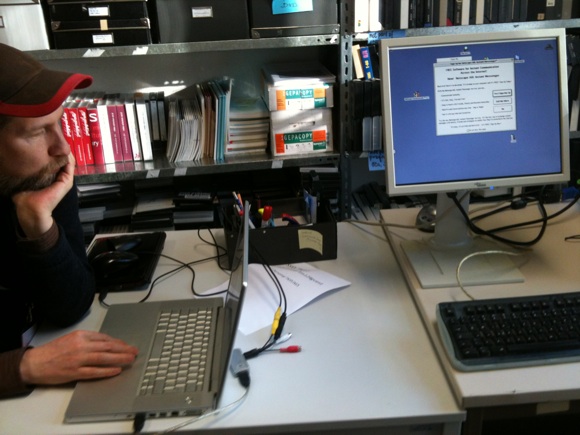

As a last mention, the video programme Satellite Stories was launched at the opening night with Screening Re-enactment Videospiegl, a looped video screening which connected the present of the festival with its history, its archive. In fact the festival first opened in 1988 as VideoFilmFest, and the Videospiegl selection of early videos is now accessible on transmediale website; hopefully marking the start of an archive which will be online and for all.
The online activity described here is certainly not enough for a festival like transmediale, which should investigate thoroughly the relationship between art festivals, artistic production and online distribution; but at least it seems a start for what is a much needed new exploration to be carried out by the organisers.
There is one more issue that I feel was only and often superficially addressed by this edition of transmediale. There were many mentions, in theory, of capitalism and its ramificated systems, such as the closeness of network systems which before were open and the consequent failure of techno-utopian ideals. However, there was little evidence of this in the artworks on display, nor in the site-specific installations presented. I don’t support the idea that artists should be literally political, or activists, but when I experienced jon.satrom’s performance at the opening, it came across as a sort of exercise in showing what can be done through bending technology to generate new languages and approaches to that which is established. In a way it reminded me again that we often operate within boxes, and rarely attempt to challenge the form and format of what is given to us. But then, most of us already know this. And although in/compatible as a festival did not want to give answers but generate a context for formulating questions, as Gainsing specified in his presentation, I felt the need of a next step, a step made of actions, which to me was only fully present in the reSource programme of Tatiana Bazzichelli. When I rethink of jon.sotrom’s performance, and I am very aware I am using him as an example to point to a larger scenario (my apologies to the artist!), I cannot refrain from thinking that the system he was challenging was that of an Apple Macintosh software, built on visual tricks like Spaces, Mission Control, etc; a system that perhaps needs to be challenged at a deeper level since, for instance, its reliance on the exploitation of developing countries workers?

This is just a final thought.
That said, I am really looking forward to seeing how transmediale will move forward, will it take the next step from this initial change?. It will be interesting to see how this merging of historical perspectives, academic research and artistic innovation will stir up more conversations and, as I said, more actions for another exploration of the relationship between contemporary cultural production, media and technology.
Please note: since the richness of the programme, I have highlighted my personal experience of the festival, so that this review highly reflects the choices I made about what to attend and what I (unfortunately) left out from my jammed daily schedule.
Darko Aleksovski interviews OPA (Slobodanka Stevceska and Denis Saraginovski). OPA (Obsessive Possessive Aggression) is an artistic collaboration, based in Macedonia, whose focus is researching the social, cultural and everyday issues, as well as the ways of looking, thinking and behaving of a certain community in the shifting social and political conditions.
Their project entitled “Bollocks” is a complex and yet very simple interactive installation, made out of a video/image projection in a room in which only one viewer at a time is allowed to see it. The project was first shown at the Authorial Through The Appearance 3 exhibition in Veles, Macedonia (2009). Then it was modified in a second version entitled as “Bollocks for Everybody” for the Small Gallery in Skopje, Macedonia. After that the project was shown at the fifth edition of the AKTO- Festival for Contemporary Arts (2010) where it was awarded with the annual Dragisa Nanevski Award for interdisciplinary achievments. The project was also shown in Studio Golo Brdo, Rovinjsko Selo, Croatia (2011).
Darko Aleksovski: “Bollocks” is a project which was shown on several occasions in art festivals and group exhibitions. Once it was exhibited as “Bollocks for Everybody!”. Can you tell us what was first: its idea, or its title?
OPA: Our initial idea was to relate one specific phenomenon of the Macedonian cultural life: much stronger “gravitation” than in the other parts of the world. It means everything is much harder here, for every single “motion” connected to arts and culture, you need several times more energy compared to other places. It could be because of our institutions, or the specific mentality, or the geographical, political and economic situation of the country – it is a matter of larger analyses. However we didn’t have intention to speak about those reasons into this work, but simply to remind of the existence of the issue. That’s why the work (visually) is about seating and waiting. In the video-image we sit and endlessly wait for something to happen. And when the spectator enters, (s)he triggers the sensor and we both leave the image. So the spectator gets nothing and sees an image of two empty chairs. In the Macedonian colloquial speech you would say the spectator gets “tashak” or “tashaci” (Macedonian: ташак, ташаци). So that is the original title of the work – “Tashaci”, given when the work was completely shaped. “Bollocks” is the best English translation that we could find, but it still doesn’t represent the expression best.
And “Bollocks for Everybody” is the title of the second version of the work, created for the windows of Mala Galerija (The Small Gallery) located in a shopping mall in Skopje.
For our solo presentation in Mala Galerija, we made two different settings of the same work: (1) On the windows of the gallery there was a projected video-image of two empty chairs. When the casual passers by trigger the sensor, our figures were entering the video-image facing the spectator. (2) But inside the gallery we installed the original version of the work, which was intended for the regular visitors of the cultural events, this time invited for the official finissage of the exhibition.
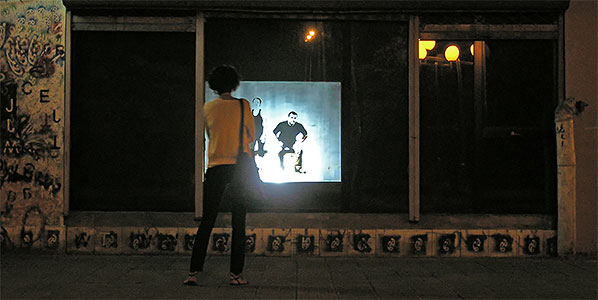
DA: Is the project primarily concerned with the general Macedonian cultural context, or it is dealing with more universal issues?
OPA: We could say that this work is emanated from these local issues, thus it is concerned with the Macedonian cultural context. Translated into the general context it speaks more about the art system, the expectations of the audience, the immateriality of the artwork, about the things that we always miss out, the absurdity, the nothingness…
DA: On one occasion, you say that the inspirational thought about the project is: ‘Art is always in another place’. Does the project speak of ignorant art or ignorant audience?
OPA: It is more about the expectations. About the expectations of where the “real” art should be, what should it look like, what is the art like in other places (always better than our), while we miss the things that are happening (or could happen) here, in front of us. One other interesting interpretation of this thought is that the art is happening during the process of creation. The artist touches it for a moment, and everything that we see as an exhibited object is only a document, a trace of the existence of the art, a way for the artist to share with the rest of the world what (s)he had experienced.
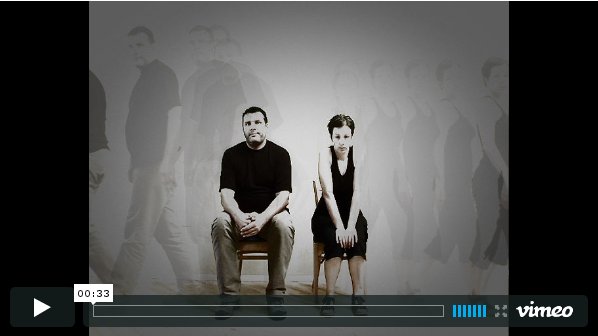
DA: Do you think interactive art is one of the easiest ways to communicate with the audience today?
OPA: It is one of the ways, but it doesn’t have to be the only or the easiest way. Anyway the art today should be in the things that surround us, or incorporated into our everyday life. It should reach us other ways than just through the galleries. It should try to surprise us, confuse us, shake our solid image of the world and make us think and reconsider our attitudes.
DA: How do you feel about joking with/ in art? Do you think a joke in an artwork should be considered a serious statement?
OPA: Humor is one very helpful tool to address the social and the political issues, or the things that bother you and the things that hurt you. It doesn’t mean that if the work involves humor it doesn’t have a serious statement. Thus it is often present in our work. One other tool that we often use in our work is entertainment. Often it is the first thing that catches the audience, it “steals” their time and attention, and than through it we try to convey our message.
DA: Absence is something one finds in many of your works. The absence of connection with reality, absence of objects, even absence of a final artwork, or project. What kind of presence do you think this absence refers to?
OPA: It is really exciting if you succeed, while acting with the art language, to make an artwork that would be communicated but not perceived as an artwork at first. In that case, the work has a direct communication with the audience, not burdened with the fact that art has “special place” in our society. It becomes a kind of subversion of the everyday life – you can experience art without knowing what’s in front of you, yet the situation you have experienced, is an artwork. What we do in our work is about creating “situations”, or often creating the artwork together with our audience. Whether this artwork is either immaterial or difficult to possess.
Featured image: ‘Angry Women’ by Annie Abrahams, 2011. (From photograph by Michael Szpakowski)
Opening Event: Saturday 25 February 2012, 1-4pm
Open Thu – Sat 12 noon – 3pm
contact: info@furtherfield.org
See images from the exhibition here
Read reviews of Being Social on Wired magazine and Enfield Independent
Being Social is the opening exhibition at Furtherfield Gallery in Finsbury Park in North London. Furtherfield has established an international reputation as London’s first gallery for networked media art since 2004. With this exciting move to a more public space Furtherfield invites artists and techies – amateurs, professionals, celebrated stars and private enthusiasts – to engage with local and global, everyday and epic themes in a process of imaginative exchange.

This exhibition brings together artworks by emerging and internationally acclaimed artists: Annie Abrahams, Karen Blissett, Ele Carpenter, Emilie Giles, moddr_ , Liz Sterry and Thomson and Craighead.
Since the mid-90s computers have changed our way of being together. First the Internet then mobile networks have grown as cultural spaces for interaction – wild and banal, bureaucratic and controlling – producing new ways of ‘being social’. Visitors are invited to view art installations, software art, networked performances and to get involved with creative activities to explore how our lives – personal and political – are being shaped by digital technologies.
Free activities for all ages (booking advisable) Saturday 10-1pm
Embroidered Digital Commons with Ele Carpenter and Emilie Giles
Furtherfield invites all gallery visitors to take part in one or more of our Saturday morning embroidery sessions and come together to stitch a term from the Raqs Media Collective’s text ‘A Concise Lexicon of/for the Digital Commons’ (2003), chosen in relation to the specific theme of the Being Social exhibition at Furtherfield Gallery. Throughout March and April 2012.
To book a place please contact Alessandra Scapin ale@furtherfield.org +44 (0) 2088022827

Annie Abrahams
Annie Abrahams has a doctorate in biology from the University of Utrecht and a degree from the Academy of Fine Arts of Arnhem. In her work, using video, performance as well as the internet, she questions the possibilities and the limits of communication in general and more specifically investigates its modes under networked conditions. She is an internationally regarded pioneer of networked performance art. She has performed and shown work extensively in France, including at the Pompidou Centre, Paris, and in many international galleries including, among others, Espai d’Art Contemporani de Castelló, Spain; the Museum of Contemporary Art, Tokyo; and the Armenian Center for Contemporary Experimental Art, Yerevan; festivals such as the Moscow Film Festival and the International Film Festival of Rotterdam, and on online platforms such as Rhizome.org and Turbulence.
Karen Blissett
Karen Blissett was born on the 3rd of May 1991, on the same day that the first successful double head-heart transplant was being carried out in a hospital in London. Her parents are the neoist artists Karen Eliot and Luther Blissett. They are only interested in art and politics, not in how Karen spends her days on the Internet.
Ele Carpenter
Ele Carpenter is a curator based in London. Her creative and curatorial practice investigates specific socio-political cultural contexts in collaboration with artists, makers, amateurs and experts. She is a lecturer in Curating at Goldsmiths College, University of London.
Since 2005 Ele has facilitated the Open Source Embroidery project using embroidery and code as a tool to investigate the language and ethics of participatory production and distribution. The Open Source Embroidery exhibition (Furtherfield, 2008; BildMuseet Umeå Sweden, 2009; Museum of Craft and Folk Art, San Francisco, 2010) presented work by over 30 artists, including the finished Html Patchwork now on display at the National Museum of Computing at Bletchley Park. Ele is currently facilitating the ‘Embroidered Digital Commons’ a distributed embroidery exploring collective work and ownership 2008 – 2013.
Emilie Giles
Emilie Giles is an alumnus of MA Interactive Media: Critical Theory and Practice at Goldsmiths College. Since graduating in 2010 her time has been spent co-organising MzTEK, a women’s technology and arts collective, as well as completing an internship with arts group Blast Theory and working for social video distributors Unruly. She is currently involved with TESTIMONIES, a project which explores oral history in relation to the 2012 Olympic and Paralympic Games largely through social media.
Emilie’s own practice revolves around notions of pervasive gaming, married with urban exploration and psychogeography. Her most recent focus lies in taking fundamental gaming principles from Geocaching and exploring the consequences of adding an emotional dimension.
moddr_
moddr_ is a Rotterdam-based media/hacker/co-working space and DIY/FOSS/OSHW fablab for artgeeks, part of the venue WORM: Institute for Avantgardistic Recreation. Since being founded in 2007 by alumni of the Piet Zwart Institute (department of “Networked Media“) they host and promote young local and international talent with a focus on the artistic modification (’modding‘) of contemporary and emerging technology. moddr_ represents a critical attitude in our ‘new’-medialandscape through spawning and development of artistic projects, workshop series, lectures, exhibitions and of course good parties.
Liz Sterry
Liz Sterry is an Essex based artist currently completing a Digital Art and Design degree at Writtle College. Liz works using different mediums including performance photography, video and installations. Communication has now become a key theme in her work. She aspires to make art that invites people to question what they think they already know.
Thomson and Craighead
Jon Thomson and Alison Craighead are artists living and working in London. They make artworks and installations which are shown in galleries, online and sometimes outdoors. Much of their recent work looks at live networks like the web and how they are changing the way we all understand the world around us. Their work has been shown in major international exhibitions and is part of public collections at Harris Museum and British Council Collection. They are shortlisted artists for the Samsung Art Prize 2012. Recent awards include Current (2011) and Vital Spark (2005). Having both studied at Duncan of Jordanstone College of Art in Dundee, Jon now lectures part time at The Slade School of Fine Art, University College London, while Alison is a senior researcher at University of Westminster and lectures in Fine Art at Goldsmiths University.
Four spaces – the Park, the Gallery, the Common Room, the www
Furtherfield’s new gallery at McKenzie Pavilion is located in a highly animated area of Finsbury Park next to a boating pond and adventure playground, near to the café and athletics track. The richly connected diversity of people, creatures, plants, activities, enthusiasms alive in the park provides the context and the inspiration for Furtherfield. The pavilion has two rooms.
The Gallery, which will display evocative and provocative exhibitions of selected contemporary artwork that address technology and social change drawing on Furtherfield’s international network of artists.
The Common Room, which will display work contributed by open call in response to exhibition themes, curated with local people. It will also act as the base for a series of free activities for local schools and visitors to the park.
Finally the www connects local users to an international network of enthusiasts, experts and audiences. It provides a place for people to share their artworks, proposals, ideas and commentaries. It will also provide access to further information about exhibitions, including downloadable catalogues and essays, information about programmes of free events and activities, and a living archive of all past work.
Furtherfield will exhibit the best of contemporary work in art, technology and social change in a truly ‘public’ space, developed with and for local residents and users of the park, and wider participants and audiences. Ultimately, we are looking for ways for local people and visitors to the park and from further afield to use this art space imaginatively together, and to connect with our international community of artists, designers, thinkers and technologists.
Furtherfield Gallery
McKenzie Pavilion, Finsbury Park
London N4 2NQ
T: +44 (0)20 8802 2827
E: info@furtherfield.org
Furtherfield Gallery is supported by Haringey Council and Arts Council England
Dragana Zarevska and Jasna Dimitrovska are visual and performing artists, cultural workers and activists from Macedonia, who also, often work together under the artistic pseudonym Ephemerki. While at the same time loving and teasing the rigidity of academism, they like decoding magic, making it transparent, go behind Wizard of Oz’s curtain and put his pants down. The name of the duo is a funny derivate of Bapchorki (band of few grannies who used to sing Macedonian traditional songs in a rustic nasal style). It suggests that Ephemerki are their ephemeral version, or at least, the ones doing the ephemeral part of tradition. Their work is driven from and inspired by Donna Haraway, Judith Butler, Deleuze and Guattari, Agamben, and other contemporary thinkers and practitioners within arts, technology, society.
The Lele method is their latest performance (a performative event for a bunch of people, as they like to call it) and so far was performed at AKTO 6, Festival for Contemporary art in Bitola and Kondenz & Locomotion, Performing arts festivals organized in Skopje and Belgrade. Here is the story behind the project.
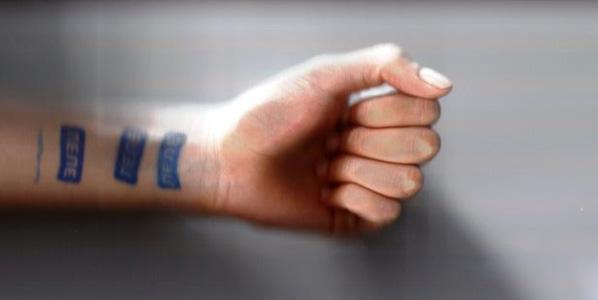
Darko Aleksovski: ‘Lele’ (Мac: леле) is a word that has profound significance in the Macedonian language. It is a universal word that can be used in different contexts and can imply several different emotional states. Can you describe what was the inspiration for this project dedicated to the word ‘lele’? What is the subjective meaning of this word for you?
Dragana Zarevska/ Jasna Dimitrovska: The particular situations this word implies and the problems it addresses might sound quite confusing for the non-Macedonian readers, but, if any of them have visited, or will visit our country, it’ll be deadly surprising how many “leles” per minute one hears around. The word “lele” is totally devoid of meaning, but it is being used to emphasize certain emotions, wondering, shock, great happiness and similar. It is just a shout out, like…the French “oh-la-la” for instance, the Bulgarian “ma-leeeh” or like the Serbian “yoooooy”. The project is being titled “The Lele Method”, directly and totally driven from the local obsession with lele and its possible application.
For us, this word sometimes depicts the shortly shaken numbness and the apathy of our current socio-political constellations, but only with a shout, and then again – everything goes on as usual.
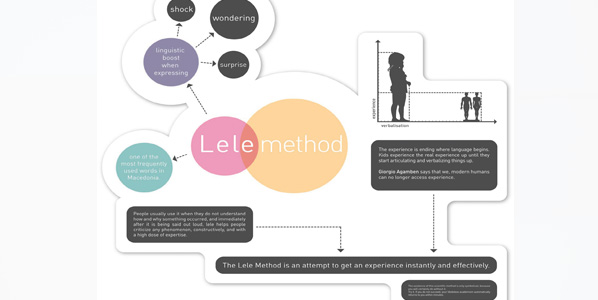
Darko Aleksovski: What is the ‘lele method’? Considering the performative act of the ‘lele’ word, and its everyday use in Macedonian speech, do you think that a method like this can still function as relevant? Can the ‘lele method’ be appropriated by anyone, or it is just a method that you as an artist use?
Dragana Zarevska/ Jasna Dimitrovska: Sure. It can be appropriated by anyone, but it is still a joke. You will certainly do without it as a method. Using it will not bring anything to your life what you’ve not had before. This is how we define it: Lele is one of the most frequently used words in Macedonia… people usually use it when they do not understand how and why something occurred, and immediately after it is being said out loud, Lele helps people criticize any phenomenon, constructively, and with a high dose of expertise. Try it. If you do not succeed, your libidoless academism automatically returns to you within minutes.
These instructions can help a lot in experiencing this useless experience through this useless method. But, stating the obvious with The Lele Method is what we enjoy the most. We give people what they already have, like selling snow to Eskimos.
Recently, in an interview we gave for the Canadian .dpi Magazine we discussed some particular effects we achieved by performing Lele. Nobody is aware of performing it daily here in Macedonia, and while we were preparing the performance out of it/about it, we realized the power of defamiliarization. You perform something which is being performed daily in a constant automatization. By naming a method Lele and putting it on a stamp, we gave the word a particular relevance and a different form. We made it “unfamiliar” and “difficult”, and by that, we prolonged the process of perception of that word. By trying to remove the automatism of perception, we got a new perspective of a word, of a problem. This technique has been used in the literary criticism of Russian formalism to differentiate prose from poetry, but we use it to differentiate and to delay perception. As Russian formalist critic Viktor Borisovich Shklovski has said in his well-known essay “Art as Device,” – the purpose of art is to impart the sensation of things as they are perceived and not as they are known.
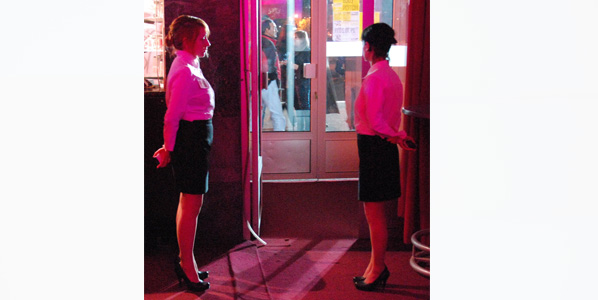
Darko Aleksovski: You have presented this project two times so far – as a performance accompanied by the printed version of the scheme of the ‘lele method’. How much performance is a necessary medium for this project?
Dragana Zarevska/ Jasna Dimitrovska: We’ve shown the performance at this year’s Akto Festival for Contemporary Art during August (Bitola/Macedonia), and at the Kondenz & Locomotion curatorially joint festivals for performing arts organized in Skopje and Belgrade during October. We must admit we entertain ourselves a lot during the performance because people enter the room and they perceive it as some irrelevant and boring employees who put a stamp on everyone’s hand at the venue’s door. Then, they look at the stamped hand/arm and shout “Leeeeeh-leeeeeh!” because that’s being engraved on our stamps.
During the performance we are dressed in our Lele uniforms which are extremely office-like and conservative, our faces are shit-serious, and inside the room there are printed materials (scattered leaflets on the tables, or printed panels on the wall) with diagrams on them explaining the empirical part of the Lele Method. The concept behind the Lele Method is being driven by our love and respect towards Giorgio Agamben’s work and his ideas on experience shown in his work Infancy and History. The experience is ending where language begins. Kids have the real experience until they start articulating and verbalizing things up. Giorgio Agamben says that we, modern humans can no longer access experience. The Lele Method is an attempt to get an experience instantly and effectively. The existence of this scientific method is only symbolic, because it is just mocking the academia and the naive ones simultaneously, as – all of the work we did/do by far.
Much of this performance auto-perpetuated, it is happening by itself. Performance is always a necessity. It is better for us to be aware of it, because we all perform all the time. This performance is all about being aware that we perform something of which we usually forget, but is actually performable – something automatized like the word Lele.
Darko Aleksovski: The project was very well received by the audience, other artists and critics. Does it have another aspect of it, that is directed as a critique towards the whole Macedonian art system?
Dragana Zarevska/ Jasna Dimitrovska: Thank you for this notion. Actually it was fantastic how great it was received. Our work can often be seen as an overlap between theory, movement, process and production. The contextualization of these things shapes the performative events we present that test and deconstruct different versions of reality and its geography, directly related to awareness of the possibilities of language. We criticize language/es through language.
Darko Aleksovski: Do you see ‘lele’ differently, now that you have made a project out of it?
Dragana Zarevska/ Jasna Dimitrovska: Yes we do. We got de-familiarized with it (by getting hiper-familiarized), while, at the same time we started to think of it as of our own word, which is pretty selfish. We totally “adopted” it. Other people who came to our performances also tell us they experience it a bit differently than before, one friend said “Whenever I say Lele I think of you!”. We know this might sound weird and vain, but it seems we assimilated it as our own piece of art, and the truth is – it is so not ours, it is everyone’s. We surely assimilated the illusion of having it as ours though.
more about the artists: zarevska [at] gmail.com, yasna.dimitrovska [at] gmail.com
The Transborder Immigrant Tool (TBT) is a project created by the University of California at San Diego’s Electronic Disturbance Theater (EDT) 2.0/b.a.n.g. lab, and still evolving today. Here Ricardo Dominguez, co-founder of EDT (with Brett Stalbaum), Principal Investigator of b.a.n.g. lab, and Associate Professor in the Visual Arts Department at UCSD, discusses the project with Lawrence Bird. The interview includes input from other members of the collective: Brett Stalbaum, Micha Cardenas, Amy Sara Carroll and Elle Mehrmand.
Lawrence Bird: Simply put, the Transborder Immigrant Tool is a hand-held device to aid crossers of the Mexico-US border. As far as the cultural and political implications of this device, it’s loaded. But as a starting point, could you tell us a little bit about the technical side of the device?
Ricardo Dominguez: We began with the basic question: what ubiquitous technology would allow us to create an inexpensive tool to support the finding of water caches left in the Southern California desert by NGO’s? Our answer was that the sub-$20 iMotorola phone series could be made useful for emergency navigation. The early generation of the platform we targeted can be made reasonably useful in a better-than-nothing scenario. Meanwhile, later phone generations (that don’t yet cross our price barrier but are getting closer everyday) are already fully useful as practical aids without even a SIM card installed or an available network service. With proper use, the GPS performance of newer phones equals any GPS designed for desert navigation, and their used prices are falling. Moreover, GPS itself does not require service and has free global coverage, courtesy of the United States government. In an emergency scenario, we trust these later mobiles to direct a lost person to a nearby safety site. The TBT’s code is also available on-line to download at walkingtools.net, sans water cache locations, for any individual or community to use for their GPS investigations.
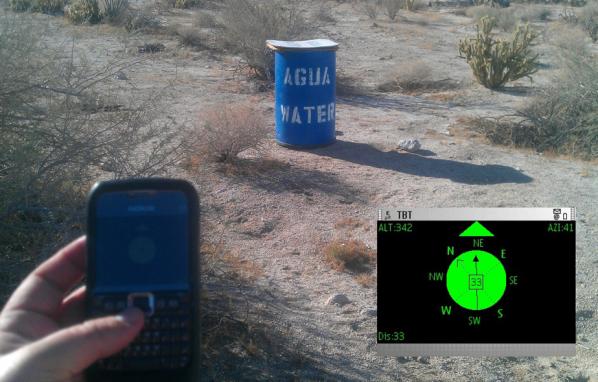
Lawrence Bird: It’s an interesting instance of technology intersecting with geography. You have referred to Donna Haraway’s work in your own comments on the intersection between “border crossing” and other forms of “trans”-being. Would it be accurate to see the TBT as a cyborg component; and if so, what does this mean for the relationship between technology, politics and poetics?
Ricardo Dominguez: Part of the TBT project is to call into question the northern cone’s imaginary about who has priority and control of who can become a cyborg or “trans” human – and immigrants are always presented as less-than-human and certainly not part of a community which is establishing and inventing new forms of life. When in fact these flowing in-between immigrant communities are a deep part of the current condition that Haraway’s research has been pointing towards – for us it is a queer turn in its emergence, both as unexpected and as desire. The investigation of queer technology and what this queering effect has been or might be is an important part of our conversations – especially via Micha Cardenas’ research. This gesture dislocates the techno-political effect with aesthetic affects that become something other than code: a performative matrix that fractalizes and reverses the disorder of things with excessive transbodies acting from the inside-out of those enforced borderless borders. These affects assemble new empirico-tran(s)cendental forms of multi-presence(s) incommensurable with the capitalist socius of the so called “immaterial” Empire. As the Zapatistas say, “we do not move at the speed of technology, but at the speed of dreams” – the heart of the trans-border-borg.
Lawrence Bird: As you say, that –borg is spatial. Do you do any work with professionals of space design – for example, you have mentioned elsewhere the architect Teddy Cruz, who’s done design projects and spatial analyses focused on the Mexico-US border, especially urban borders?
Ricardo Dominguez: We have not worked directly with any urban space designers, such as Teddy Cruz, who teaches here at the Visual Arts Department at UCSD as well – but we have learned a great deal about the nature of the border-as-design and auto-assemblage – especially from the Political Equator gatherings that he has been at the forefront in creating. But recently we were invited to create a gesture for Political Equator 3 that we really enjoyed and offered a poetic materialization of bringing TBT into Mexico: at 12:30 p.m on June 4th, 2011 the Transborder Immigrant Tool was walked into Tijuana, Mexico via an aquaduct from the U.S. side of the border by artist Marlène Ramírez-Cancio (a video of this event is embedded above).
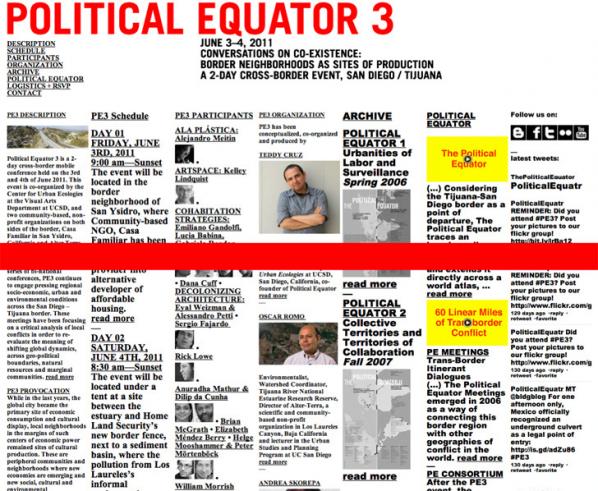
Lawrence Bird: Does any of this work intersect with American fear over border permeability to terrorism? The criticisms of TBT seem to focus on economic migration but the reaction bleeds into fears over security.
Ricardo Dominguez: TBT does crisscross a number of these types of affective conditions that have been floating around the border since 9/11; or one might push it back to early formations of the Mexico/U.S. border. And yes, it intersects with the growing state of fear in the U.S. (and around the world) about immigrants dismantling the U.S. economy – which has always struck me as extremely ironic – since as we have encountered in these past couple of decades, neo-liberal economics on a global scale have done much more to dissolve the romance of the nation via a series of self-made economic bombs than any immigrant “invasion.”
Lawrence Bird: In fact your development of this tool has come at a significant personal cost. You’ve been accused of supporting illegal activity and misuse of public funds. You’ve been called a traitor. Your position at UCSD was threatened. Could you talk about that and where this situation stands today?
Ricardo Dominguez: The entire group of artists who are part of Electronic Disturbance Theater 2.0/b.a.n.g. lab working on the Transborder Immigrant Tool (TBT) was being investigated by UCSD and 3 Republican Congressmen starting on January 11, 2010. Then I came under investigation for the virtual sit-in performance (which joined communities statewide against the rising students fees in the UC system and the dismantling of educational support for K–12 across California) against the UC Office of the President (UCOP) on March 4, 2010. This was then followed by an investigation by the FBI Office of Cybercrimes. So, it was three investigations in total— and they were all seeking to find a way to stop TBT and threaten to de-tenure me for doing the very work I was hired to do and then tenured for. In the end all the investigations were dropped. I did agree not to do another virtual sit-in performance on the UCOP for four years, but the day I signed the agreement, a number of supporters across the nation did a virtual sit-in on UCOP again. One strange element about the agreement that they wanted me to sign without even giving me or my legal team time to look it over was that I would never speak or write about what had happened, create any artwork that might disturb anyone and refrain from an artivist performances. Of course I agreed to none of it.
Lawrence Bird: The vitriol in the attacks on you is remarkable, and disturbing: you received a great deal of hate mail and a number of death threats because of this project. You mention in your play Sustenance (published in Artists & Activists 12) that these messages “constellate into remarkable patterns”, form a chart as it were of the agitated contemporary discourse over immigration, security, and national purity vs. liberty. It’s significant that you’ve built a play around this. Do you see the political and popular response to your project (you refer to it as “viral reportage”) as part of the TBT’s performative aspect?
Ricardo Dominguez: Part of the history of the Electronic Disturbance Theater 1.0/2.0 and b.a.n.g. lab (stands for bits, atoms, neurons and genes) at CALIT2/UCSD has been to develop works that can create a performative matrix that activate and take a measure of the current conditions and intensities of power/s, communities and their anxieties or resistances. So, for us the U.S. Department of Defense launching “info-weapons” at us for a virtual sit-in on September 9th, 1998 or the current confluence of “viral reportage” and the affective contagion of hate about the project that followed are all part of the performance – of course we would much rather the hate-mail never occurred – dominant media is bad enough to deal with. The aesthetics of working in the zones of post-contemporary artivist gestures cannot really escape these types of encounters; it is part and parcel of the patina of our work. But, we also feel that the hate mail or the general fear of losing national purity is co-equal in importance with the poetry that they were attacking. In fact Glenn Beck, an extreme right wing pundit on the Fox News Channel, attacked not only TBT’s use of poetry, but that the poetry itself had the power to “dissolve” the nation. The performative matrix of TBT allows viral reportage, hate-mail, GPS, poetry, the Mexico/U.S. border, immigrants, to encounter one another in a state of frisson – a frisson that seeks to ask what is sustenance under the sign of globalization-is-borderization.

Lawrence Bird: Can you tell us a little more about the poetry that accompanies the guidance system? How was this chosen, what does it concern? How do you envision the poetry developing as the project continues?
Ricardo Dominguez: Electronic Disturbance Theater 1.0/2.0 has always been invested in experimental poetry as part of its gestures – from the found poetry of the “404 file not found” of our ECD performances in 90’s to the border hack actions with the Zapatista Tribal Port Scan in 2000 on U.S. Border Patrol servers, where we would scan and upload Zapatista poems that we had written into their servers. When we started to develop TBT it became important once again to have a core impulse of the gesture. In 2008 I asked my partner, Amy Sara Carroll, who is an experimental poet and scholar, at University of Michigan, Ann Arbor – one of the areas of her research is on art and Mexican/U.S. border. She thought that TBT becoming a geo-poetic-system (gps) could expand the frame of experimental poetry and artivism. She then began to work with us and established two geo-poetic tracks – one conceptual and the other an echoing of desert survival manuals in multiple languages, which speaks to the multiple borders that are crisscrossing the planet and the multiple languages that are crossing Mexican/U.S. border via immigrants. Here is Amy speaking about TBT:
“…my collaboration with Electronic Disturbance Theatre (EDT) on the Transborder Immigrant Tool…(is) imagined as a global project under development, my own involvement in that ongoing process is linked to the question of what constitutes sustenance in the quotidian of the conceptual, on the varied musical scales of the micro- and macro-. For, often—rightly enough—conversations about crossing the Mexico-U.S. border refer to disorientation, sun exposure, lack of water. The Transborder Immigrant Tool attempts to address those vicissitudes, but also to remember that the aesthetic—freighted with the unbearable weight of ‘love’—too, sustains. A poetic gesture from its inception, the Transborder Immigrant Tool functions, via the aspirations of such a dislocative medium, as dislocative media, seeking to realize the possibilities of G.P.S. as both a ‘global positioning system’ and, what, in another context, Laura Borràs Castanyer and Juan B. Gutiérrez have termed, a ‘global poetic system.’ The Transborder Immigrant Tool includes poems for psychic consultation, spoken words of encouragement and welcome, which I am writing and co-designing in the mindset of Audre Lorde’s pronouncement that ‘poetry is not a luxury.’ … speaks to the Transborder Immigrant Tool’s overarching commitment to global citizenship. For, the excerpt, itself infused with the ‘transversal logic’ of the poetic, acts as one of the Transborder Immigrant Tool’s internal compasses, clarifying the ways and means by which I and my collaborators approach this project as ethically inflected, as transcending the local of (bi-)national politics, of borders and their policing.” http://bang.calit2.net/xborderblog/?tag=poetry
Here is a poem that made Glenn Beck extremely angry:
TRANSITION
(song of my cells)
Gloria Anzaldúa writes, “We have a tradition of migration, a tradition of long walks. Today we are witnessing la migración de los pueblos mexicanos, the return odyssey to the historical/mythological Aztlán” (1999 [1987]: 33). The historical? The mythological? Aztlán? It’s difficult to follow the soundings of that song. Today’s borders and circuits speak at “lower frequencies,” are “shot through with chips of Messianic time.” Might (O chondria!): imagine the chips’ transliteralization and you have “arrived” at the engines of a global positioning system—the transitivity of the Transborder Immigrant Tool. Too: when you outgrow that definition, look for the “trans-” of transcendental -isms, imperfect as overwound pocketwatches, “off”-beat as subliminalities (alternate forms of energy which exceed Reason’s predetermined star maps). Pointedly past Walden-pondering, el otro lado de flâneur-floundering—draw a circle, now “irse por la tangente”—neither gray nor grey (nor black-and-white). Arco-iris: flight, a fight. Of fancy. This Bridge Called my Back, my heart, my head, my cock, my cunt, my tunnel. Vision: You. Are. Crossing. Into. Me.
Here is a beautiful video version that Micha Cardenas and Elle Mehrmand did of the poem: http://bang.calit2.net/xborderblog/?p=49
In the strongest possible sense poetic practice has emerged in TBT that is co-equal with Brett Stalbaum’s idea of a “last mile” tool and his development of the code necessary to have it work. In fact we also think of the code-as-poetry as well – an expansion of codeswitching – literally.
Here is one of the desert survival poems:
En última instancia, muchos dirán que
la naturaleza establece el estándar de
la neutralidad. A diferencia de los seres
humanos, la naturaleza no hace lazos
de lealtad con la nación, la familia, los
negocios o la religión. Usted sabe bien
que el mayor peligro que enfrentará en el
desierto puede no ser el clima o el terreno.
Habrá quienes no tengan en consideración
su bienestar. Los rescatistas tienen el
compromiso de ayudar a quien lo necesite;
exíjales cumplir esa promesa. No confíe su
vida a nadie más, a ningún extraño.
All them are available in multiple languages to the user on TBT.
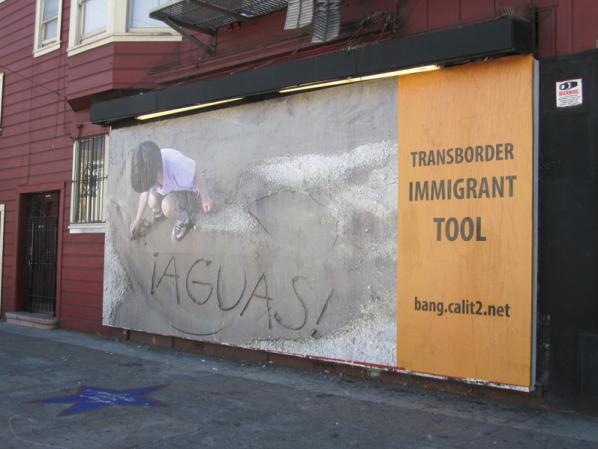
Lawrence Bird: How do you navigate the legal issues? Did you have a strategy in place ahead of time for dealing with these, or have you had to deal with them ad-hoc? Does your strategy/defense link up at any level with that of apprehended border-crossers?
Ricardo Dominguez: We are not attempting to navigate “legal” (national or international) issues – but we are trying to establish a reconfiguration of the border and immigration in terms of what we are calling transborder justice – the question of a “higher law” doctrine that David Henry Thoreau established in On Civil Disobedience. Also, in a more speculative manner as artists we see TBT as still in the process of becoming – it is still shape shifting and performing itself into potential spaces of use and poetics. TBT is border disturbance art that constitutes a visible geo-aesthetic/geo-ethics gesture against the boundaries and borderless borders that are crisscrossing every single body on the planet – we call for a geo-aesthetics that starts at the nanoscale and reaches to the GPS (Global Position System) grid system that floats around the planet, we call for a geo-aesthetics that connects both the human and the inhuman, geography and ethics, we call for a geo-aesthetics that crosses into and dislocates the smooth space of geo-spatial mobility with ethical objects for multiple forms of sustenance. We live in a world where only goods and services have rights to cross borders – a world that is a chaosmosis of markets that demand global exchange and aggressive state social filters. We need a geo-aesthetics that can construct ethical and performative complexities for the new earths to come, that can touch new geographies for new bodies – transbodies with transborder rights – artwork that can function as a geo-philosophy for bodies that are flowing as transborder bodies across all the borders the world – a flowing-trans-nation the planet cannot survive without.
Lawrence Bird: Have you considered applications of the TBT more globally, in Europe for example, or the Canada/US border, which has its own tensions relating to indigenous sovereignty? Or would this take it out of the specific politics you want to focus on?
Ricardo Dominguez: We imagine TBT’s code and gesture as open to use on multiple borders and that it is not bound to just the Mexico/U.S. border. One way that we have attempted to promote this possibility is by making the code available to anyone or any group at walkingtools.net.
Lawrence Bird: How extensively has your system been used on the Mexico/U.S. border? Or is it primarily rhetorical so far (it’s certainly been successful that way). How is it coordinated with others’ humanitarian efforts for border-crossers?
Ricardo Dominguez: On a very practical level our work with NGO’s has been focused on working with groups in Southern California who have established networks of water caches for immigrants crossing that area of the border – specifically Water Stations Inc. and Border Angels. Water Stations Inc., the longest running NGO working on this issue, has been very open to helping us test TBT and has also offered us extremely important insights into what the real conditions on the ground and what problems immigrants are facing. We recommend that if folks have funds to donate to these groups – please do. They were very wary of us at first – but they have now become much more supportive – especially because of the work that Brett Stalbaum and his partner, artist Paula Poole, have done in with them beyond TBT.
On the rhetorical end of the gesture much of the work that we do at b.a.n.g. lab is to start our research as a politics of rehearsal, a rehearsal of politics, as part of our art practice – to create an aesthetic of minor-signals and lower-frequencies…”like physics, aesthetics is a science whose primary object is signals, the physical materiality of signs….”– to quote from a recent tweet by Jussi Parikka. To manifest a type of science of the oppressed or engineering of the oppressed that imagines creating speculations that automatically, conceptually, begin to disturb not only the lines of thinking that criss-cross not only our bodies, but the ecologies of the Americas, and certainly the globe. And, so it becomes necessary to create these speculative disturbances that can allow one to think about another possibility, another impossibility, that these systems both manifest and, at the same time, call for an “anti-anti-utopian” potentiality, so that the engineering of the oppressed, the science of the oppressed, is about rehearsing the fictions that will then become realities. Our work in one sense is simply a gesture of “plagiarism”—a cutting and pasting of what is already an assemblage or a system that exists because immigrants are crossing multiple spaces around the world and GPS is everywhere in our cloudy global Empire. And so TBT itself is an attempt to create the multiple layers that manifest the social frictions, the speculative fictions, the rehearsal of politics, and of a counter-machine aesthetics—a machine of difference that can only really be performed by more than the multitude, if you will, to interrupt what Mary Pat Brady calls the U.S/Mexico border, “a state-sponsored aesthetic project.” We can see how these speculative gestures do create social responses on a global scale.
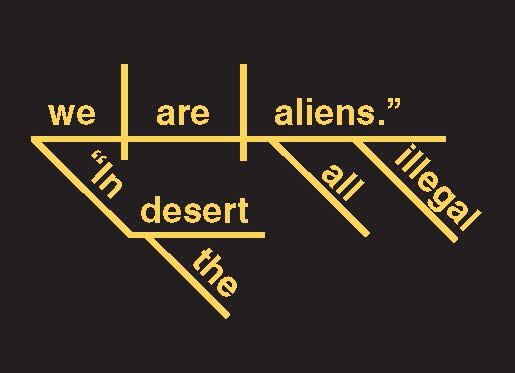
Lawrence Bird: TBT doesn’t just provide a map and way of locating oneself, it offers directions to various support services – where to find water, medical help. How are such safe sites managed and their position made public without making them vulnerable to border patrols? Are there any ethical issues involved here?
Ricardo Dominguez: The water cache sites are already well known by the U.S. Border Patrol, Homeland Security and anyone else who cares to take a trip along the Anza-Borrego desert in Southern California – in fact they have large flags signaling their locations. So TBT at this point is only doing one thing – offering the location of these known and established water caches – as a last-mile safety tool and nothing more. The cell phones we are using are not robust enough for anything else – now as more cheap high-end phones come on the market TBT will be able to offer more on multiple levels. So the ethical questions about TBT on the U.S. side of the border are not as complicated as those on the Mexico side of the border: these are questions about how TBT would interact with the coyote networks, would it be just one more material burden to those crossing, how does the extreme violence of the narco-war shut down the abilities of NGO’s etc., to work on distributing TBT with us – these questions seem much more important in terms of the ethics of the project – would it do more harm than good? Or is it a gesture that would offer a way out for some immigrants from the violence of these dangerous networks that they have to deal with in order to cross? At this point due to all last year’s issues we have not been able to formally present TBT to the immigrant communities preparing to cross to have a dialogue about these questions – but we are hoping to move forward with these encounters – sans any further investigations.
Lawrence Bird: And how has TBT been taken on the Mexican side – what is it’s perception on the part of Mexican citizens, politicians, media? I’m curious how their reaction compares to the response on the American side, which approached violence.
Ricardo Dominguez: It is difficult for us to access Mexico’s response to TBT in relation to coyote economies or the narco-war on the border – these are zones that we have not attempted to have conversations with or have correspondences with. But EDT 2.0 is concerned about how TBT might function within or alongside these violent enclosures that immigrants have to deal with on multiple levels. We do not want TBT to become an attractor for immigrants who are already targets for these groups. But what we can say is that Mexico’s dominant media and alter-media networks, from Tijuana to Chiapas, have been very responsive and supportive of TBT. One of the first awards TBT received was in 2007 from the new media arts festival Transito_MX, who awarded TBT the “trans-communities award,” and the award was handed to us by a representative of the U.S. Embassy in Mexico. So at this time the response to TBT is both unknown and known. Another concern that we have and that we hope to be able to have a better sense of by the end of the year is how the design works for immigrants, and to what degree do they consider it useful as an art work and “last mile” safety tool – this will be done via workshops with potential immigrants in Tijuana, Mexico. Also one of the core questions we will have, based on all the materials that immigrants leave in the desert while crossing – the heat and difficulty of crossing call for dropping as much away from the body as possible, from money, to telephone numbers, to pictures of loved ones, etc. – is one more thing to weigh one down really necessary? These are EDT 2.0’s concerns at this time in relation to the border on the Mexican side.
Lawrence Bird: You mention that what drives border crossers is a hope that amounts to a “hope for the unknown”? Could you elaborate on this? At any level do you see a contradiction between this and the technologies of transparency, like GPS?
Ricardo Dominguez: The radical gesture of transparency was extremely important to EDT 1.0 in relation to Electronic Civil Disobedience as theory and practice and it still is in relation to the general distribution of TBT – who were are, where we are, and why we are doing it. But we are also very interested in the notion of translucency as an aesthetic possibility for TBT that functions to dislocate the readability of GPS (Global Positioning System) and gps (a geo-poetic system) – a minor form of the technology that is no longer bound to the total vision of GPS that is now embedded in almost everything. This translucency functions as a single-bounce GPS that initiates the database of TBT and then shuts off – thus making triangulation impossible – unless the user decided to turn the function on during the crossing. TBT’s gps creates an aesthetic disturbance that dislocates GPS as a transparent device and instead offers a navigational translucency of the “last mile” with hope-as-sustenance as its guiding wave-point.
Lawrence Bird: In Sustenance you refer in passing to Baudrillard’s “desert of the Real”. It’s a compelling way of looking at the border desert where migrants are abandoned in their pursuit of the American fantasy. But adopting a perhaps more humanist attitude, would it be remiss to recall Saint-Exupéry’s words that “Ce qui embellit le desert…c’est qu’il cache un puits quelque part.” / “What makes a desert beautiful is that, somewhere, it hides a well.” Perhaps based on that juxtaposition, how would you place your project in relation to the tension between poetry, activist politics, and humanitarianism?
Ricardo Dominguez: TBT is still in a (gps) process of becoming – it is still shape-shifting and performing itself into potential spaces of use for activists and expanding the frame of dislocative poetics. TBT is border disturbance art that constitutes a waterwitching tool that indeed crosses the desert of the Real, the hard simulations of the border which seek to target and kill. It offers another possibility – with the anti-anti-utopian offer of the desert’s “beauty” that you are keying into the conversation. We imagine that this gesture echoes practices that fractalize the desert’s geo-aesthetics as: artivism, tactical poetries, hacktivism(s), new media theater, border disturbance art/technologies, augmented realities, speculative cartographies, queer technologies, transnational feminisms and code, digital Zapatismo, dislocative gps, intergalactic performances, [add your own______].

This is a collection of artworks, texts and resources about freedom and openness in the arts, in the age of the Internet. Freedom to collaborate – to use, modify and redistribute ideas, artworks, experiences, media and tools. Openness to the ideas and contributions of others, and new ways of organising and making decisions together. This collection is intended to inspire, inform and enable people to apply peer-to-peer principles for making things and getting organised together. We hope that all art lovers, makers, thinkers, organisers and strategists will find something for them from this set of imaginative, communitarian and dynamic contemporary practices.
Commissioned and hosted by Arts Council England 2011
Featured image: Installation Speed. Public Space Exhibition Plattform Bohnenstrasse in Bremen September 2006. Aram Bartholl.
Pole Position, Outrun, F1 Racer and Need for Speed are some of the countless racing games that have attracted artists to explore a world of speed and burning rubber. In 2004 Cory Arcangel hacked the old Japanese Famicom driving game F1 Racer and removed, in the same way as he did in Super Mario Clouds, cars and other objects so that the only thing that remained of the game was the road and the landscape rushing toward the viewer.
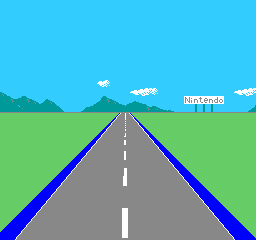
Hacking and modifying videogames is one artistic approach, another approach in Game Art is to transfer virtual objects into real objects. The Swedish artists Simon Goldin and Jakob Senneby in an exhibition called Objects of virtual desire (2005), introduced virtual objects from players in Second Life. The object was then reproduced as physical art as limited edition in an exhibition, exploring immaterial production in a virtual world and how this can be transferred into an economy of material production. “Objects of Virtual Desire exploits the augmented value of immaterial objects to create and market tangible products, thereby reversing the process and highlighting the materiality of the immaterial.” Goldin & Senneby.
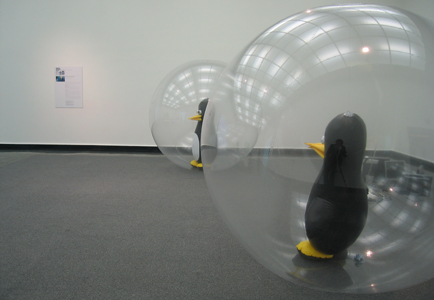
In a similar way both Aram Bartholl and Brody Condon have used virtual objects from Speed racing games. In Speed (2006) Bartholl made a 1:1 scale sign with red flashing arrows and placed the sign at a street in Bohnenstrasse in Bremen. The model to the arrows had he found in the game Need for Speed Underground NFSU where the red blinking signs leads the player on the right track. Condon on the other hand made an exact replica of a Lamborghini Countach from 1985, a model that he found in the game Need for Speed. The big different was that the car was made of plastic branches and there was only the outline of a car, in a 3D program you would say it was the wireframe of a car. What Bartholl and Condons does is that they investigates and problematizes the borderline between the virtual world and the reality by moving virtual and real objects between these two worlds. Worlds that today are more and more integrated and harder to distinguish.
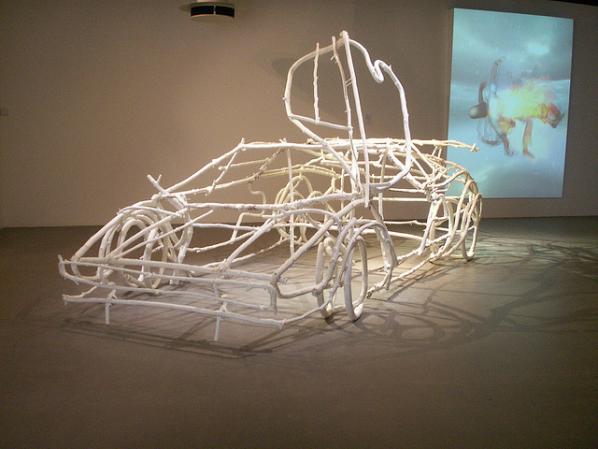
The Dutch artists Marieke Verbiesen is also mixing elements from the virtual and real world in her work Pole Positon. Pole position was a racing game released in 1982 by Namco and was one of the first games to use the rear-view racer format, where the player’s view is behind and above the vehicle. In her installation the background in the game created by a realtime recording of a miniature landscape in perspective. Visitors can interfere in the landscape and be a part of the game by passing by the camera filming the landscape.
The ultimate combination of real and virtual game play is found in Garnet Hertzs work OutRun. Outrun was a game that was created by Sega 1986. Some arcade versions of the game were presented in a red sit down cabinet that looked like a car. Garnet Hertz has used this cabinet version as a model for his work and made a red real car where the front window is replaced with an aracde cabinet. With help of augmented reality the road ahead of you is an 8-bit video game, so at the same time you are playing the game you are driving down the road.
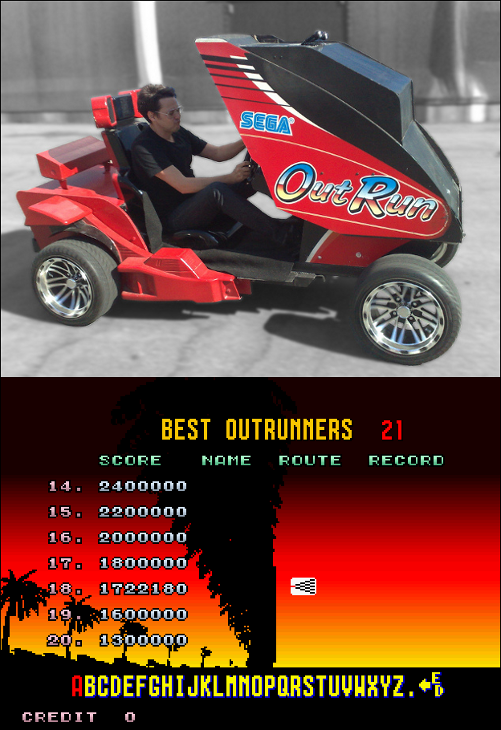
OutRun – Garnet Hertz. Images/video: http://www.conceptlab.com/outrun
“where game simulations strive to be increasingly realistic (usually focused on graphics), this system pursues “real” driving through the game. Additionally, playing off the game-like experience one can have driving with an automobile navigation system, OutRun explores the consequences of using only a computer model of the world as a navigation tool for driving.” Hertz
One thing that you could not blame racing games for is air pollution. In the installation “Colorless, odorless and tasteless” from 2011 this is exactly what you can blame Eva and Franco Mattes for.
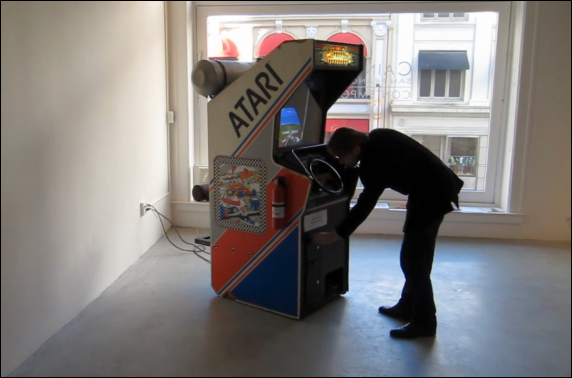
They modified an old Pole Position game and installed a real engine in the arcade cabinet. When the player is driving the virtual car on the screen the room is filled with carbon monoxide from the real engine. So the risk is not only that you run out of coins but you are also gassed.
More of Mathias’s reviews on Furtherfield & bio : http://www.furtherfield.org/user/mathias-jansson
Featured image: Remixthebook Cover
“For us, art is not an end in itself … but it is an
opportunity for the true perception and criticism
of the times we live in.” Hugo Ball.
The challenge in trying to review a book like Mark Amerika’s Remixthebook, is the feeling you can only do justice to the text by doing the same with your review. The apparent simplicity coupled with the multifarious outcomes are intoxicating. You could be mistaken for believing that every possible remix would produce fresh and exciting outcomes. The key of course, is to have good source material in the first place. Also, to have developed a keen eye for what blends and meshes together and what doesn’t. Even the most disparate work requires judgment and prior awareness. Remixthebook asks us to consider the idea of remixology as part of the work of modern artists. The tone and style of the book is a blend of ideas, voices and thoughts with a myriad of concepts, which attempts be the very embodiment of the ideas it espouses.
Amerika explores various precedents for the remixological concept and draws on some known practitioners from the past: amongst them, Allen Ginsberg, William S. Burroughs and Brion Gysin. He explores existing ideas and welds them into his own armoury. Their ideas considered as part of his own creative practice, brought back to the now with new life, in our contemporary networked culture.
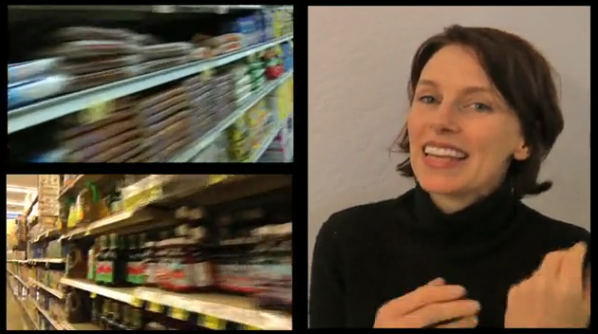
Other than just being a systematic breakdown of the different types of remixing and their potential outputs (or artifacts, as they might be better known in an art critical framework?) Amerika considers the pathways and theoretical underpinnings of remix culture. Having taken this beyond his own practice of the written word and web-based projects, he considers his recent and ongoing VJ work. Blending and collage-making with images during live music performances suggests some of the instinctive, instantaneous ideas that come out of a lifetime’s collecting, collating and absorbing of diverse imagery, words and cultural concepts. It’s within this process that he believes more novel outcomes can arise, against the constant flux of media creation and dissemination. It is the ‘becoming’ of the media artist that is revealed in the live remixing performance.
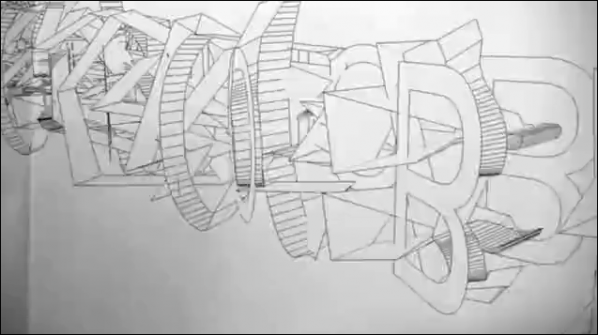
Reflecting on this process of cultural assimilation Mark Amerika, situates remixology within a wider creative output and theoretical framework. This involves a cross hybrid of everyday, mainstream references with high art and ‘high’ theory, all written in his at once complex and convoluted, yet easily read and enjoyable writing style. But like remixology, what looks simple is the result of deep reading and heavy conceptual thinking. This isn’t to say that you won’t have trouble decoding the writing and getting to the heart of his thinking, but it helps if you spend time with the text and allow the rhythms and structures to become second nature to you. Close reading allows the text to fall into place. For example, consider the following extract from the section eros intensification:
Here is where we enter the realm of
what I have been calling intersubjective jamming
which is different than the idea of a Networked Author
or Collaborative Groupthink Mentality that preys
on the lifestyles of the Source Material Rich
and seemingly forever Almost Famous.
It is worth remembering that Mark Amerika is a creative writer first and foremost. He uses theory as a palette from which to draw out ideas and situations for further reflection and to help give some context to the point he is trying to make. The text of remixthebook is an example of his creative practice in action, as much as it is a personal reflection on his attempts to develop a thought process for it. Theory becomes entwined in critical reflection and creative output. You don’t necessarily come to remixthebook for philosophical answers and hard academic points of view, instead you ride the maelstrom of thoughts and conceptualizing to gain a better handle on a way of considering artistic practice.
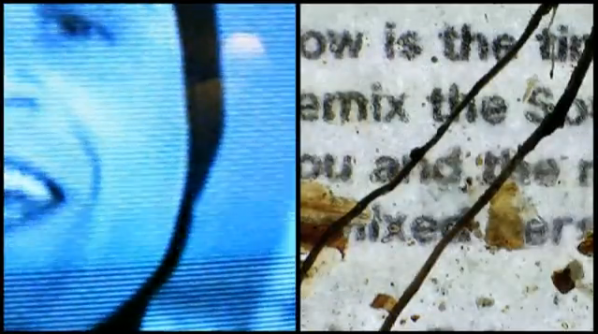
The website of the book (probably a ubiquitous extra for any media art-related publication these days) follows a natural path of inclusion and invites artists to take sections of the book and remix them according to their own aesthetic and remixological preferences. While some of the work brings in extra visuals and places itself in a flowing context of media streams, allowing different work to become part of the project, Rick Silva’s The Isarithm sources Amerika’s Sentences on Remixology 1.0 and explodes them out of the screen and into a layered and playful vortex of shapes and lines.
Will Leurs uses some captured footage taken directly off the tv screen for A Pixel and Glitch Hotel Room and combines it with some source material supplied by Amerika from several ‘lectures’ he has supplied. These lectures appear within several other contributors work as well. The point of some of these remixes and the varied forms they take (the collection includes some purely audio work) is that, as well as being interesting works themselves, they are exemplars and guides to even further potentials of the remixological principle.
Mark Amerika’s Remixthebook at times may leave you looking beyond it to the appendix or for any footnotes that would fill out spaces or help make conceptual leaps for you. That isn’t the point of the book. The idea is to take the book as a starting point and expand on your own creative process. Possibly the best approach is to literally cut-up the book and try some experimentation of your own, Brion Gysin style. Flex the covers back and pull out the pages. Through destruction and reconfiguration, the book might be bent to your will and become something that you can use. Perhaps the sight of a ripped and destroyed book would strike horror into some authors. I can’t help thinking that Mark Amerika would take great joy in the image and say that he’d planned it all along.
The remixthebook.com website
http://www.remixthebook.com
The remixthebook Blog
http://www.remixthebook.com/theblog
Remixology by OpenMedia.ca – a national, non-partisan, non-profit organization working to advance and support an open and innovative communications system in Canada.
http://openmedia.ca/remixology
Society of the Spectale (A Digital Remix)
By Mark Amerika On August 16, 2011.
http://www.remixthebook.com/society-of-the-spectale-a-digital-remix
REMIXTAPE 2.0 //
Remixology is a music blog based in Paris (France) devoted to remixes friendly music.
http://remixology.tumblr.com/
REFF- Remix the world! Reinvent reality! exhibition at Furtherfield Gallery between 25 February and 26 March 2011. http://www.furtherfield.org/exhibitions/reff-remix-world-reinvent-reality
Visitorsstudio – an online place for real-time, multi-user mixing, remixing, collaborative creation, many to many dialogue and networked performance and play.
http://www.visitorsstudio.org/x.html
Brion Gysin. Essays & Stories, Interviews, Excerpts & Publications
http://briongysin.com
“Festival of Ideas For A New City” organized by the New Museum, The Architectural League, The Bowery Poetry Club, C-Lab, Columbia University Center for Architecture, Cooper Union, The Drawing Center, NYU Wagner, PARC Foundation, Storefront for Art and Architecture, and the Swiss Institute blossomed like spring in New York City from May 4 – 8th, setting out to “harness the power of the creative community to imagine the future city and explore the ideas destined to shape it.”
Keynotes addressing the issues were architect Rem Koolhaas, virtual reality inventor Jaron Lanier, and former President of the National University of Columbia, and former Mayor of Bogota, Antanas Mockus. A StreetFest set up along the Bowery with over 100 local grassroots organizations and small businesses “presenting model practices and products in a unique environment.” Over 100 projects, events, performances and walking tours expanded on the Festival’s themes.
Rem Koolhaas with OMA and The New Museum showcased CRONOCAOS, an exhibit examining the growing “empire” of preservation and destruction and the consequences of how we build, rebuild and remember. What is the role of preservation on the art world? As larger and larger spaces are repurposed for art from industrial spaces they focus on the “apocalyptic sublime,” mimicking Hollywood and B movies. Oddly enough Koolhaas noted, this increase in preservation closely parallels the rise of Wall Street and tourism.

There were panels on “The Heterogeneous City,” “The Networked City,” “The Reconfigured City,” and “The Sustainable City.” At night curator Anna Muessig’s Flash:Light Nuit Blanche event included murals along the Bowery, art projections on Nolita and Lower East Side buildings, and music and performances including projects on the facade of the New Museum and St. Patrick’s Old Cathedral in Little Italy. There was also a 3D video installation Civilization reinterpreting Dante’s Diving comedy.
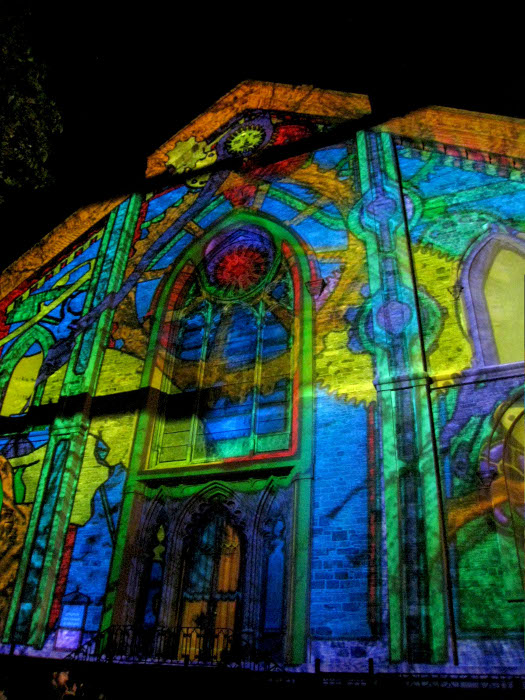

Jaron Lanier’s Keynote address on “The Networked City” at the Great Hall at Cooper Union reiterated many of the themes in his new book, “You Are Not A Gadget.” Not one to follow any set path, Lanier began his talk by playing a Laoitian “Ban Lao” (Ban Bang Sai Kai) bamboo wood pipe. He declared the simple reed flute was one of the first holders of digital information, even older than the abacus, because each reed object and note is turned on and off just like a series of digital 0’s and 1’s. The Ban Lao, traded across the Silk Route was noticed by the Greeks and Romans, and influenced the development of the pipe organ. The pipe organ was automated and turned into a player piano, a programmable loom, and finally became the origins of Charles Babbage’s computer.
Computers have gotten better Lanier explained, processing more and more bits, but humans still have more precise acuity at the level of quantum physics. They can respond to just one photon. He then veered off topic discussing the first computer scientist Alan Turing who used computers to crack codes during World War II. Persecuted for being gay, he was injected by authorities with female hormones which gave him breasts and made him suicidal. Just like Snow White, he killed himself by eating a poisoned apple.
He then veered back on track saying using computers as metaphors to the human condition is an irrelevant, outdated metaphor. The brain is not a CPU, and eyes and ears are not USBs. A better metaphor is thinking of the head as a spy submarine performing spy missions. You are constantly moving your head seeking out data, not passively seeing it. Your visual system is sensitive to minute differences. A musical instrument is an additional instrument to the sensory motor loop that makes perception possible. Can we build digital tools that are as sensitive as we are? This, he noted, was one of the key questions now facing computer scientists.
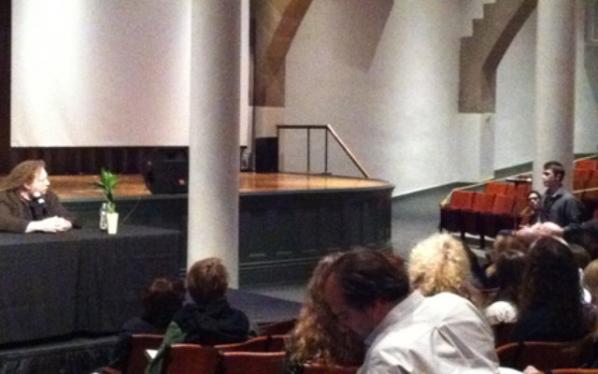
New technologies are usually developed to become weapons. But many important inventions were first developed for music. Musical bows existed before arrows, and guns developed from the casting of metal bells. Even Hewlett Packard’s first object was a musical synthesizer. Music is a driver with innovation taking place around making sounds.
In order to make his lecture relevant to the “Networked City” theme of the festival, Lanier discussed his favourite thing about New York City, that the same sense of acuity as applied to musical instruments also applies to personal interactions. More diversity means you have more chance of connecting with someone who will change your life. The fates of people in New York are guided by their activities. Its important that the fates concern an extra world of human to human contact.
In such a huge network context people are sensitive to subtle motions in each other, and can identify subconscious communication we don’t really know about. Contrast that to sound networking, where digital music does not give you the subtle minute accuracy of acoustic sound. People who only communicate virtually are spinning their wheels in place. When we connect to each other through digital representations we lose some form of expression.
Lanier proselytized for the necessity of the “head and the heart”, insisted technology needs to bring better jobs to society than the ones they are destroying. The basic social contract he said was turned back 11 years ago when advertising became the new way to get information. Sergey Brin, the co-founder of Google was the one who started it. Because digital technology is cheaper, cheaper just gives this stuff away for advertising. But, when you take the products of people’s hearts and minds, such as their music and literature, and give them away for free this becomes a problem. When you put effort into a promotion on line you get the illusion of benefits, but you actually lose relative advantage. This is because the true customers of a social networking site like Facebook is not you, you are actually the product of Facebook. You are sold and the customer pays to influence events. This is the difference between overt and covert information with Lanier stating, “The official business of computation is advertising.” At some point though, there is nothing to advertise. If cars can drive themselves, what happens to truck drivers? Or if 3D machines make fabrications they make manufacturing obsolete.
The Japanese are creating elder care robots. We are making ourselves unemployed. The fashion of making everything free leads us down a path from a city of dreams to a cry of despair. We have to figure out a way to change our relationship to information technology, instead of chasing after users and followers and making more money. Ending his lecture he declared, “We must humanize digital architecture – We must see beyond fads.” And then he played a little ditty on dual Gypsy flutes.
Featured image: Nightingale’s Playground Chapter Selection
Andy Campbell is a UK writer who has been experimenting with new media fiction since the 1990s, when he started creating stories on floppy disc for the Commodore Amiga. By 2000, when I first came across him, he was working mainly in Flash and self-publishing the results on a website called “Digital Fiction”. He has continued to produce one or two pieces of work per year ever since, latterly on a site called “Dreaming Methods”. His output is invariably enigmatic, complex, densely-textured, dark in tone and technically highly-accomplished; and he has gradually established himself, certainly amongst his peers, as one of the leading exponents of the digital fiction form.
His most recent work is also his biggest and most ambitious to date. Entitled Nightingale’s Playground, it consists of four interlinked parts: a click-and-read interactive story; a 3D “game”, which involves exploring a dark flat; a virtual exercise-book, the pages of which can be turned by dragging them across the screen with your mouse; and an ebook text narrative, written in short fragments.
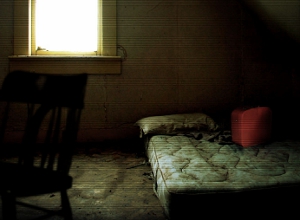
The story, put simply, goes like this. In “Consensus Trance” (the click-and-read interactive section), the adult Carl has just broken up with his girlfriend. The one item he carries away from the breakup is an old red vanity case belonging to his Gran, with whom he used to live when he was a boy. The case contains bits of talismanic bric-a-brac dating back to Carl’s schooldays. Partly because the contents of the case have jogged his memories, Carl attends a school reunion in the hope of catching up with his best schoolfriend, Alex Nightingale. But Alex isn’t there – and furthermore nobody else can remember him. Carl remembers that Alex disappeared unaccountably while he was still at school. He begins to wonder whether Alex actually existed at all, or whether he imagined him; but at the same time he starts to feel as if “ordinary life” might be the illusion, and Alex might have disappeared because he somehow managed to get through to a further reality. He goes back to revisit the flat where Alex used to live.
“Consensus Trance II” picks up from inside the flat’s front door. It takes the form of a 3D “game”, in which we must walk through the passages and rooms of a half-dark flat, discovering fragments of white text as we go, and unlocking extra sections of the flat once a certain number of texts have been discovered. The text-fragments reprise parts of the story which can be found elsewhere, but they also develop the theme that Alex may have disappeared because he managed to get beyond the illusion of everyday life, along with a suggestion that Carl and Alex may be figments of one another’s imagination (many of the text-fragments have Alex’s name in them at one moment and Carl’s at the next), and a third idea that Carl may not be able to remember what happened to Alex because it was something so terrible that he blocked it out of his mind. In the last room of the flat, which has to be unlocked by discovering and “walking through” all the text-fragments elsewhere, this suggestion becomes more concrete: Alex may have tested out his own theories about reality by drinking something poisonous, and therefore he may have disappeared because he killed himself. The process of exploring the half-dark flat thus becomes a metaphor for Carl’s exploration of his own repressed memories, and the fragmentary revelation which awaits us in the last room represents the moment in which he rediscovers his personal nightmare.
The third part of the story, “The Fieldwork Book”, is an old exercise book of Alex’s – or rather a virtual exercise book, apparently recently dug-up, complete with soil-stains, scribbly handwriting, comments in blue from the teacher, doodles, bits of leaf stuck to the pages with sellotape, and woodlice running around on the front cover. It contains the beginnings of a school project about nature – “A dead tree may look lifeless, but actually it’s teeming with activity…” – along with notes from Alex to Carl – “Worthington has paired me up with this mad girl called Joanne. She smokes and stinks but I quite like her.” – and a lot of press cuttings and comments about a computer-game called The Sentinel. All of this makes more sense once the other parts of “Nightingale’s Playground” have been visited, particularly the ebook, which gives a lot of background information about both the Fieldwork Book itself and the Sentinel.
One thing we learn from the ebook section of the story is that The Fieldwork Book is a kind of changeling. Carl buried his science exercise book in the back garden behind his gran’s flat, at Alex’s suggestion, as a way of making it look more grubby and out-of-doors, and thus suggesting to the science teacher that it had been used intensively in the development of the nature project. However, when he dug it up again after Alex’s disappearance, what he discovered was not his own exercise-book but one belonging to Alex.
Another thing we learn is that The Sentinel, to which the Fieldwork Book makes numerous references, is an old Commodore computer-game with which Alex was obsessed. It had 10,000 levels, all based on the same principle: that players had to approach an object called The Sentinel across mountainous terrain without being observed. If they were detected the game would be over. Carl never managed to get very far but Alex managed to get to level 9,999 – and in fact one possible explanation for his disappearance is that it may have had something to do with him reaching level 10,000. He and Carl also played their own outdoor version of The Sentinel, in which Carl would have to stand still while Alex attempted to creep up on him undetected. A copy of The Sentinel is one of the items of bric-a-brac which Carl the adult discovers in his Gran’s old red vanity case.
The ebook also gives some more information about the vanity case itself. When Carl retrieves the Fieldwork Book and finds it to be Alex’s version rather than his own, he hides it in his Gran’s sideboard, and whilst hiding it he discovers something else in there – the red vanity case. The story doesn’t actually tell us in so many words that he looks inside the case, but we gather he must have done, because later on he has a conversation with his Gran, who is telling him that the contents of the case are private and he mustn’t look in there again:
“But what’s that red case? What are those papers?”
“They’re nothing,” she said insistently. “They’re from a long time ago, they don’t make any sense and they’re private love, they’re just private.”
The papers may have something to do with Alex’s death. On the other hand, they may be connected with Carl’s mother, since this is one of the few times in the story when she gets a mention:
…[Gran said] there were things in the world, happenings, that she didn’t understand, and neither would I, and neither would anyone else, and sometimes it was best to just leave them alone.
“Like we leave Mum alone,” I murmured. She didn’t answer that, and looked a little hurt, so I whispered “sorry” and she started talking to me again…
These hints are never developed further.
Nightingale’s Playground is not without its shortcomings. Its most obvious structural weakness is that its four different sections are in four different formats, each with its own distinctive “look” in terms of graphic design, and each needing to be viewed and interacted with in a different way. This is asking a lot of any readers and viewers who are unfamiliar with new media, although it’s actually less of a problem than might be supposed. Once the initial leap of faith has been made the cross-references between the four sections soon start to pull the story together into a surprisingly cohesive single structure. All the same, the fact that two parts are designed to be viewed online, whereas the other two parts are designed to be downloaded onto your own computer (or ereader) does make it a little bit inconvenient to shuttle backwards and forwards between one section and another if you want to examine the story in detail.
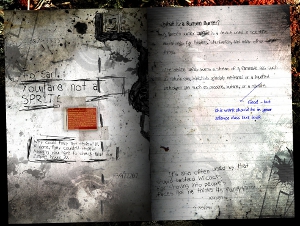
A more serious flaw is the fact that the Fieldwork Book doesn’t actually add very much to our sense of what’s going on. Pretty much all the information it contains (about the Sentinel, and Alex’s view of reality) can be garnered from the other sections, and although reading the Fieldwork Book gives us a slightly stronger sense of Alex’s personality and voice, the material in it begins to seem rather like padding on repeated viewing. There is a similar problem with the red vanity case, which is built up into something of great importance both in the point-and-click narrative section of the story and the ebook. When we actually get to see what’s inside the vanity case, halfway through the point-and-click section, the contents turn out to be rather disappointing.
Campbell does tend to talk up the importance of events and symbolic objects in his stories, rather than leave them to speak for themselves, which can sometimes backfire and lead to a sense of anticlimax. His prose-style can be overblown, a trait which is probably at its most noticeable in the “game” section of the story, where white texts either hang in the air or in some cases appear on the walls of the darkened flat. Some of these texts are particularly sonorous and doomy:
Where were we? Who were we? How much control did we have over the rain coming down, the hideous blank backdrop we were cut and pasted and glued against?
You were onto it, like you were onto something that meant all of this was wrong, some kind of mad illusion; that there was a staggering, amazing psychedelic hope going on that I desperately, weepingly wanted to understand.
I get the feeling everything changed then, like you said words to me that didn’t exist; a language that spoke the impossible; couldn’t be absorbed by the normal brain. Did you even invent some new words? Pierce a new crack in the fabric of what was going on in our limited, messed up world?
“The hideous blank backgrop”; “mad illusion”; “staggering, amazing psychedelic hope”; “desperately, weepingly wanted to understand”; “pierce a new crack in the fabric of what was going on” – the harder these phrases try to impress us, the less they succeed. The trouble is that there isn’t enough concrete observation or information here to convince us that the big emotive adjectives are justified. They seem to be flapping around in a vaccuum.
On the other hand, the ebook section of Nightingale’s Playground contains some of Campbell’s tightest and most effective writing:
Science was my best lesson because Alex was in it – science without Alex was a shitty prospect. I didn’t like any of the other kids in the class, I didn’t like the teacher, I didn’t like doing experiments or doing any work. Science for me was about swapping computer game cassettes under the table, scribbling rude shapes on Alex’s excercise book, whispering about whether the teachers were really aliens trying to brainwash us or whether the entire school was some kind of hologram that folded up and disappeared after the bell for hometime.
This is both convincing about the boredom of being a schoolkid in a dull lesson, and suggestive in terms of the story’s wider themes – the idea that “the entire school was some kind of hologram” clearly links to the alternative-reality theme. The ebook as a whole is written in short punchy sections jumbled into a non-linear sequence, shuttling us backwards and forwards through a term of so or Carl’s school memories, and unfolding (without ever fully explaining) the story of Alex’s disappearance. It works as a stand-alone, but it also works as the glue which holds the entire structure of Nightingale’s Playground together.
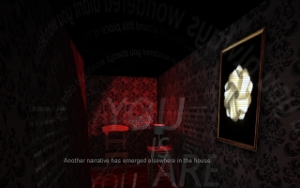
It should also be said that although the flat-exploring section of the story is sometimes overwritten, it is also the most thoroughly immersive of all four parts, and the one where Campbell’s characteristic approach to new media fiction comes into its own most strongly. He has always been at pains not to place his text in front of his images, or beneath them or to one side, like labels on tanks at the zoo or explanatory plaques next to pictures in a gallery; instead he puts his words inside his graphical environments, sometimes hidden or partially-hidden inside them, so that we have to explore to read. This avoids the danger of us regarding the texts as more important than the images. It pulls us in, and it makes his work inherently immersive and interactive.
This characteristic technique is taken a step further in the flat-exploring section of Nightingale’s Playground (which was built with gaming software called Coppercube 2.0), because here the three-dimensional space is deeper, more mazelike and more thoroughly-articulated than Campbell’s customary Flash environments. There is a sinister audio track which changes incrementally as we move from one part of the flat to another, enhancing our sense of three-dimensionality (the audio dimension of Campbell’s environments should not be overlooked in any of his work). The atmosphere is claustrophobic and scary. When you manage to find the right number of texts to unlock an extra section of the flat, there is a loud door-latch click which makes you jump even if you’re expecting it. When you get to the last room of the flat – the one where Carl is starting to get fragmentary recall of Alex’s possible suicide – the space is suddenly bigger, the predominant colour is red, there are items of furniture floating in the middle of the air, the far wall is decorated with a massive staring eye (an icon from the Sentinel game), the text-fragments tend to slide around in front of you as you approach them instead of staying still, and the whole effect is genuinely climactic and nightmarish. There can be no doubt that at moments like this Nightingale’s Playground is an extremely effective piece of new meda fiction.
It’s interesting to note how closely the climax of this flat-exploring sequence resembles Grandma’s house in Tale of Tales’ horror-game The Path. Campbell is an admirer of Tale of Tales’ work, but he hadn’t seen The Path prior to the completion of Nightingale’s Playground. All the same, the parallels are striking: the feeling of combined claustrophobia and disorientation, the sinister red-and-black colouring, the way the reader/viewer is barraged with suggestive fragments, and the way this technique is used to suggest flashbacks. There is a strong sexual theme in The Path which is not present in Nightingale’s Playground, but otherwise it’s difficult to escape the feeling that both Campbell and Tale of Tales have seized upon the exploration of a mazelike game-space as a metaphor for an inner journey, and have developed the metaphor in very similar ways.
Readers who are familiar with Campbell’s earlier work will recognise a number of the themes and motifs employed in Nightingale’s Playground. The Fieldwork Book, for example, is designed in very much the same way as an earlier virtual exercise book from a story called “The Scrapbook”; collections of fragmentary jottings, or old half-corrupted electronic files, can also be found in “Fractured”, “Floppy” and “The Incomplete”; the feverish boy being looked after by his Gran, with his mother either absent or not interested, is a familiar figure from “Dim O’Gauble”; the schoolfriend who introduces the first-person narrator to an apocalyptic secret is an echo of “Capped”; and a gloomy flat which must be explored for clues to the story’s central mystery can also be found in “The Flat”.
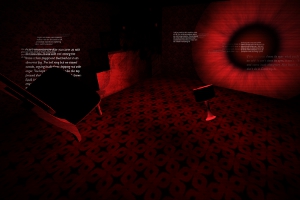
But these narrative strategies in turn suggest certain deeper patterns on which much of Campbell’s work seems to be built. His abiding interest in hints and fragments, for example, is admittedly suited to the nonlinear style of new media literature, but it also serves to suggest that Campbell’s central characters are often living in a reality with two layers: the “ordinary” everyday world which is mean, dull, shoddy and constricting, but relatively safe; and an inner or underlying reality which can only be glimpsed rather than viewed as a whole, possibly because it is so dangerous and frightening – a reality which emerges fitfully via dreams, games, imaginings and doodles.
It also frequently the case in Campbell’s work that the constricted dullness of the “ordinary” world is associated with adult life and adult sensibilities, whereas the “inner” reality is associated with childhood. Thus, in Nightingale’s Playground, the adult narrator starts to rediscover his “real” self when he breaks up with his girlfriend and rediscovers his memories of his best friend Alex. In a way, this could be seen as a Romantic or Wordsworthian view of the relationship between childhood and adulthood: as children we are much more in touch both with our imaginations and our inner selves, and therefore much more aware of the true nature of things, while as adults we become more absorbed in “getting and spending”, and therefore spiritually dull. Campbell is certainly no sentimentalist about childhood – in fact his stories are full of instances of kids being nasty to each other – and it should also be noted that the imaginative insights of the children in his stories may be shared or partially shared by more elderly figures such as the Gran in Nightingale’s Playground, another Gran in Dim O’Gauble, and the dying old man in Last Dream. It may be that these old people share the visionary capabilities of the young by virtue of their closeness to death – there are strong hints in the ebook section of Nightingale’s Playground that Carl’s Nan is about to die of lung cancer.
Perhaps a better literary antecedent for Cambell’s obsessive and visionary kids is the figure of Roland from Alan Garner’s Elidor – another hypersensitive and super-visionary outsider whose insight and talents serve to isolate him both from the mundane world of the Manchester suburb where he lives, and from the other members of his own family who would rather have safe, dull lives than dangerous, eccentric and magical ones. Of course Roland is an outsider-figure who can easily be identified with Alan Garner himself; and in the same way, Alex Nightingale can easily be identified with Campbell. The refusal of these visionary characters to settle for mere ordinary life can be interpreted as an oblique declaration of intent from the artists who created them. But there are other messages here too. The whole structure of Nightingale’s Playground is telling us something about the nature of the world we live in. Did Alex Nightingale actually disappear into an alternative reality, or did he commit suicide? Did Carl imagine Alex, did Alex imagine Carl, or did they both somehow imagine each other? Is the Sentinel just a computer-game or the key to something deeper? What was in the red vanity case when Carl first discovered it? What is the secret his Gran is so anxious to keep hidden? The fact that all of these issues are left hanging, and that the whole pattern of the story is therefore deliberately-unresolved, ambiguous, is a message in itself. Life isn’t clear-cut: it isn’t about answers: it’s about questions.
Nightingale’s Playground has its shortcomings, but it builds Campbell’s open-ended style of narrative into a more ambitious and absorbing structure – and explores some of his characteristic themes with greater maturity and depth – than anything he has produced before.
This review is co-published by The Hyperliterature Exchange and Furtherfield.org.
Between July 27th and August 29th, 2010, the eleventh edition of the FILE festival is taking place in Sao Paulo (Brazil), at several locations along the popular Paulista Avenue. After a decade of existence, this veteran festival, which spreads over several cities in Brazil (including Rio de Janeiro and Porto Alegre) as well as other international locations, has introduced for the first time its own award: the FILE PRIX LUX. With a total amount of approximately 120,000 euros, distributed in three categories, the prize is unprecedented in the continent and has received, on this first edition, 1,235 registrations from 44 countries.
Yet this award is not the only remarkable aspect of this year’s festival, which stands out for being particularly accessible to the general public. On the one hand, the exhibitions, performances and workshops as well as the symposium have no entrance fees, and therefore there have been many visitors, most of all young people who line up every day to experience the interactive installations at the FIESP-Ruth Cardoso Cultural Centre. On the other hand, the festival organizers, Ricardo Barreto and Paula Perissinotto, have developed this year a project that takes digital art to the Paulista Avenue by placing several interactive artworks at different locations in the public space. Finally, even the FILE PRIX LUX has been open to the interaction with the public by introducing a popular vote category and an online voting system which was accessible between May and June. This openness sets a good example of how media art festivals can engage the general public to approach this somewhat ignored form of art.
In general terms, the award categories at media art festivals have been subject to change as the creative uses of technology evolved during the last decades. The FILE PRIX LUX has the advantage of being created at a time in which it can be relatively safe to set up a few broad categories that cover most of the forms of combining art and technology. Only three categories have been established: Interactive Art (which usually refers to objects and installations that respond to inputs from the viewer/s), Digital Language (related to the festival’s title and which embraces any artwork that deals with language, narrative, code or text in a generative or interactive manner) and Electronic Sonority (the category assigned to any artwork in which the production or manipulation of sound is a key element). These three categories prove to be comprehensive, as shown by the diversity of the projects distinguished with a prize or an honorary mention: immersive interactive installations, musical performances, urban interventions, bioart pieces, a collectively created machinima movie and even an iPhone app are among this year’s FILE PRIX LUX awardees.
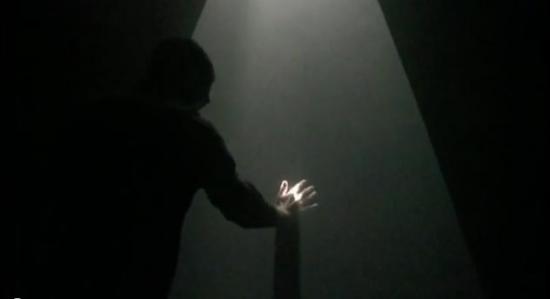
In the Interactive Art category, the winners are Ernesto Klar for Relational Lights (1st prize) and Kurt Henschläger for Zee (2nd prize). Both present immersive environments in which light and space are key elements, although the interaction is totally different. Klar’s work invites the viewer to interact with two projected geometric drawings inspired by the work of Lygia Clark. In a hazy dark room, the viewer sees two T-shaped projections of white light on the ground, which form a three-dimensional space which reacts to the visitor’s presence. The interaction is playful and really beautiful in its simplicity, whilst also limited in time: after a few minutes, the projections suddenly stop reacting to the user’s movements and reconfigure themselves in a new shape. This abrupt interruption is consciously introduced by the artist in order to remind the viewer that the artwork has a life of its own. In contrast, Henschläger’s Zee takes place mostly in the mind of an audience exposed to an overdose of audiovisual stimuli in a foggy room. Continuing the experience of his acclaimed performance FEED, this time the artist allows the viewer to walk around the space and have a more meditative sensory experience.
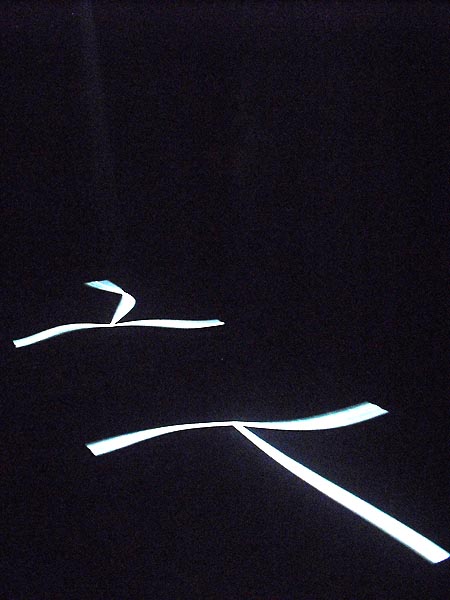
The Electronic Sonority category has brought together several outstanding works, among which Jaime E. Oliver’s Silent Percussion Project and TERMINALBEACH’s Heartchamber Orchestra have been distinguished with the 1st and 2nd prize, respectively. In both projects the human body is incorporated in a novel form in the creation of music, the sound being produced, moreover, not simply by direct inputs but by complex interactions in a constant flow of data. Oliver’s instruments convert the shapes created by the performer’s hands into streams of data that generate, in turn, different sounds. These sounds are not always the same, as could be the case in a traditional instrument, but are changed by the variables established in previous interactions. Thus, Oliver does not simply create a new form of interacting with an instrument but rather a new form of creating music. In a similar way, the [i]Heartchamber Orchestra[/i] project developed by TERMINALBEACH (Erich Berger and Peter Votava) explores a form of creating music based on a feedback loop in which the performers are writing and following the score at the same time. As the artists state, in their project “the music literally comes from the heart”: a network of 12 independent sensors record the heartbeats of the musicians in an orchestra and sends the data to a software that generates a musical score in real time. The musicians play the score as it is displayed on the laptops in front of them, while their heartbeats set the notes in a continuous cycle in which music and performer constantly influence each other.
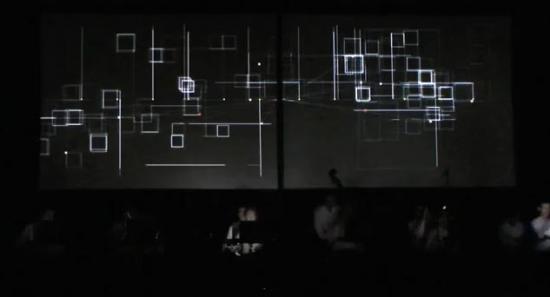
Digital Language is certainly the broadest category of this FILE PRIX LUX, its awardees being quite dissimilar in the formats they use and the objectives of their respective projects. The organizers define this category as including “all research and experiments in the ambit of the multiple disciplines that use digital media”, and the winners exemplify how diverse these disciplines can be. The 1st prize winner, Tardigotchi by the artists collective SWAMP (Douglas Easterly, Matt Kenyon and Tiago Rorke) is a bioart project that sets a critical comparison between artificial and real life. A nicely designed, steam punk-inspired device hosts, on the one hand, a tardigrade, a microorganism measuring half a millimeter in length, along with a robot arm that injects a substance that feeds the creature and a heating lamp that provides warmth. On the other hand, a digital display shows the virtual avatar of this tardigrade, with which the user can interact. Humorously referencing the popular Tamagotchi toy, the artists create a link between the avatar and the real creature: when the user presses the button to feed the avatar, the device inserts real food in the environment of the tardigrade; when an email is sent to the digital creature, a heating lamp gives warmth to the microorganism. Thus, interacting with the virtual pet has consequences in a real living being. This brings our attention into what we can consider alive and how we emotionally attach to artificial creatures while at the same time we undervalue the existence of other living beings. On a different approach, the 2nd prize winner, Hi! A Real Human Interface, by the collective Multitouch Barcelona (Dani Armengol, Roger Pujol, Xavier Vilar and Pol Pla), proposes a more human relationship with technology. A video presents the concept developed by this interaction design group of a different GUI in which a real person is displayed as impersonating the computer. Common interface elements are replaced by handmade physical objects which remind the aesthetics of a video by Michel Gondry. The result is a playful form of interaction in which simple operations such as checking email or upgrading the operating system are shown as actions carried on with real objects by a person inside a box. The proposal is engaging and certainly sets a departure from the old desktop concept, yet it remains unsure to what extend this type of interaction can be applied in a real operating system.
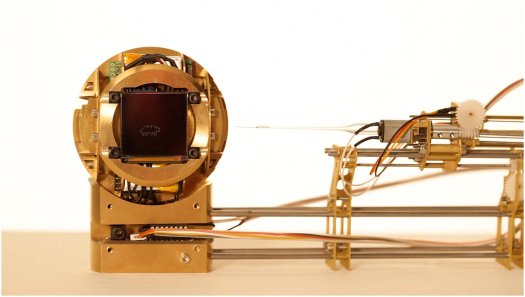
The works that obtained a Vesper statuette (symbol of the FILE PRIX LUX award) along with the also outstanding Honorary Mentions are exhibited at the FIESP-Ruth Cardoso Cultural Centre in a group show that also includes FILE Media Art, a selection of more than 70 works that can be accessed on several computers, as well as a selection of videogames and machinima films. The exhibition is thus richer in content than it would seem at first sight, as the space is divided in numerous sections that conceal several installations which demand (as usual) almost total obscurity. The artworks are well presented, although at times the sound from one installation invades the others, and there are no wall labels that inform the viewer about the concept of the piece or the way to interact with it. The latter, much-discussed issue is quite important, since the info-trainers cannot explain the artworks to every visitor, and quite often this entails that some people may not interact with the pieces or worse, start smashing buttons or interfering projections blindly in the hope of modifying them. Despite this fact, the exhibition has proven to be very successful during the first week of the festival, with a steady flow of visitors who showed a profound interest in the artworks.

A part of the exhibition is devoted to the FILE MACHINIMA section, curated by Fernanda Alburquerque, who selected over 40 works. Among these is the award winner in the Popular Vote category, War of Internet Addiction, by Corndog and the Oil Tiger Machinima Team from China, a 64-minute movie collectively created by players in the MMORPG War of Warcraft. More than mere entertainment, this film has been created as a form of protest against the Chinese authorities’ attempt to control the access and commercial benefits derived from the WoW game, which is extremely popular in the country. The film has had 10 million views since January 2010 and despite being available only in Chinese, it has been the favorite work of those who participated in the online voting system of the FILE PRIX LUX. Besides this feature film, other short films explore the possibilities of building narratives in virtual environments such as Second Life and videogames such as Half Life 2, Eve Online or Shadow of the Colossus.
In addition to the main exhibition, the FIESP Cultural Centre hosts a series of performances and screenings. Under the title Hypersonica, the festival presented a series of digital music performances, among which where the two winners of the FILE PRIX LUX in the Electronic Sonority category. FILE DOCUMENTA, curated by Eric Marke, offers in its 5th edition a selection of “rare and new” documentary films, among which Andreas Johnsen’s Good Copy Bad Copy, an interesting exploration of the conflicts between remix artists and copyright owners, or Robert Baca’s Welcome to Macintosh, which records the first years of the history of Apple Computers.
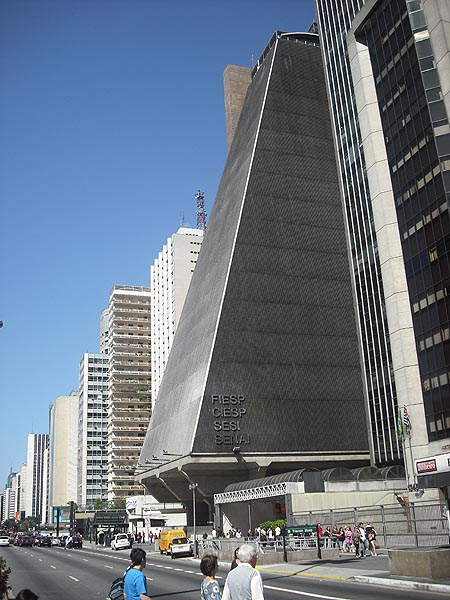
The symposium, hosted by the Instituto Cervantes in Sao Paulo, gathered several experts and artists who presented their explorations in the theory and practice of media art. Among the most interesting contributions were the presentation of Prof. Espen Aarseth on the aesthetics of ludo-narrative software, and the colloquy of South American digital art, in which Raquel Renno (Brazil), Jorge Hernandez, Ricardo Vega (Chile) and Vicky Messi (Argentina) discussed the current developments in the media art scene in the South Cone.
Alongside the FILE PRIX LUX, the most outstanding feature of the present edition of the festival is FILE PAI (Paulista Avenida Interactiva), which takes several interactive artworks to the public spaces in the Paulista Avenue. Interactive art offers the possibility of bringing art to the public space in a more efficient and dynamic form than what is usually known as “public art”. As Ricardo Barreto states: “the public environment is not something empty, aseptic and dead, as is the old white cube; on the contrary, it is an environment teeming with life, with multiple interests and multiple behaviors”. Interactive art integrates itself into this environment and is much more apt to relate to a public that is now willing to take an active role. The organizers of the FILE festival have distributed twelve interactive artworks along the Paulista Avenue, at subway stations, inside shopping malls, and even in a bus. The selected artworks include, among others, videogames such as Patrick Smith’s Windosill or the celebrated games of That Game Company, Flower and Flow; VR/Urban’s SMSlingshot, an urban intervention project that allows users to write a message in a custom-made slingshot that incorporates a screen and a keyboard and then send the message to a wall, where it is displayed as a virtual graffiti; Karolina Sobecka’s Sniff, an interactive projection in which a virtual dog reacts to the presence of passersby; the installations of Rejane Cantoni and Leonardo Crescenti Piso and Infinito ao Cubo, which attracted a large number of people, and the sound piece Omnibusonia Paulista by Vanderlei Lucentini, which is played in a bus as it moves along the avenue, interacting with several points in the itinerary and thus generating a new set of sounds in every trip. These works reveal the possibilities of integrating interactive art in the public space, to the point that, as Ricardo Barreto indicates, “the new paradigm of public art will be the interactive city”. The busy Paulista Avenue is certainly a good location for the creation of an emerging, interactive city.
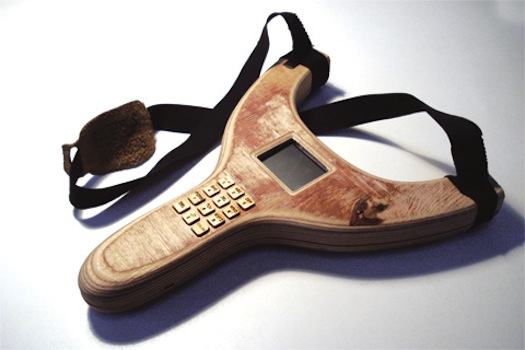
In this 11th edition, the FILE festival has achieved a state of maturity. The FILE PRIX LUX, FILE PAI and an estimated 25,000 visitors to date support its claim of being the largest festival of its kind in Latin America, and a steady event that places Brazil in the map of the international digital art scene. In a tightly interconnected world, each region is a node: there isn’t a center and a periphery anymore, there are no colonies. FILE exemplifies how a region can become a powerful node in this network by promoting the most recent developments in art and technology, avoiding obsolete distinctions between North and South and becoming a point of development for the future stages of our digital culture.
HTTP Gallery is pleased to host LAB4 by Hedva Eltanani, an exploration of communication between two places using streaming media and web applications. It is another step in a series of LABs that explore digital technology and audience interaction. It is part of Heltanani’s research on digital performance and the way it affects audience experience.
LAB4 is a game that challenges the audience to bend the boundaries of space, interaction and intimacy. The two locations, HTTP Gallery in London and The Poly Centre in Falmouth, are linked via live-feed technology, using webcams and web applications. Eltanani will lead a series of activities, such as ‘truth or dare’, which challenges elements of group dynamics and technology – the aim is to engage the two audiences and help participants bond within each group.
How intimate will it go? The participants are invited to deepen the connection by keeping their community active using web applications.
BE PART OF THE EVENT IN LONDON
Doors open at 8:30pm
More info and documentation :
http://arthubfalmouth.blogspot.com/
http://vs4rslab.wordpress.com/
Featured image: People watching and being watched across virtual space
Helen Varley Jamieson’s account of working collaboratively in Madrid at the Eclectic Tech Carnival. On a ‘sprint’, with five women coming together for a week to rebuild the group’s website, physically & remotely.
In the last week of June I went to Madrid for the Eclectic Tech Carnival (/ETC) website workweek – the collective effort of five women coming together for a week to rebuild the group’s website. This is sprint methodology, a concept that I first met in Agile software development, but one that is being increasingly applied as a successful creative collaboration methodology. During the workweek I blogged about the process and this article is an assemblage of the blog posts.
Thinking about the concept of the sprint, I realised that over the years, I’ve participated in a number of theatrical “sprints” although we didn’t call them that. In fact it could be argued that the normal development process for theatre productions in New Zealand is the sprint – a three or four week turnaround of devising/rehearsing/presenting. Except that it doesn’t usually continue the Agile process after the first sprint – evaluation, refinement then the next sprint and iteration – and as a result, the work is often undercooked. But theatre projects that better fit the sprint analogy are some of the workshop-performance processes that I’ve participated in at theatre festivals, where a small group comes together for a few days to create a performance, then some time later meets again in another situation, perhaps a slightly different configuration of people, for another sprint. Each sprint generates a stand-alone performance or work-in-process showing, as well as contributes to a larger evolving body of work that forms the whole collaborative project. Two such projects that I’ve been part of are Water[war]s and Women With Big Eyes (with the Magdalena Project).

Recently I participated remotely in a Floss Manuals sprint, developing a manual for CiviCRM (which is something that I use with the Magdalena Aoteroa site). In this sprint, a group of about 15 people met somewhere in the USA to create a manual for CiviCRM. A few more of us were online, doing things like copy-editing the content. Most of the time there were people active in the IRC channel, chatting about the project and other things going on around them, so I got a sense of their environment, time zone and the camaraderie generated by the intense process.
Sprinting seems like a very logical and effective way to work in many situations: in software development, where each sprint focuses on specific feature development, and allows for a lot of flexibility and adaptation as the project progresses; in theatre, where limited resources make it a practical way to work, and the time pressure forces us to be resourceful and imaginative and also with networks, such as the Eclectic Tech Carnival, whose organisers don’t get to meet physically very often. It also makes sense in the context of our hectic lives, to block out a week or a few days when we agree to put everything else on hold and commit to intense, focused work instead of trying to juggle and multitask, with deadlines pushing out and out.
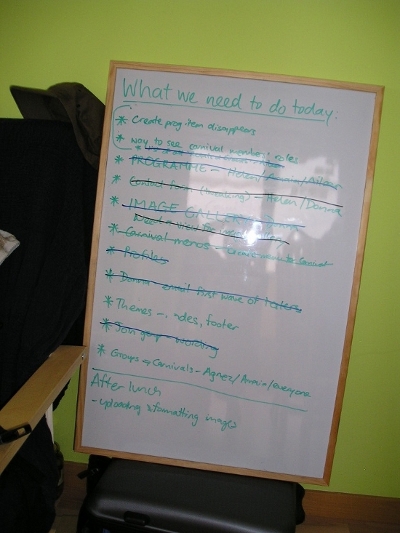
By halfway through the second day of the workweek, the wiki we used to plan and manage the project was filling up with tech specs, user requirements, design ideas, etc. We were getting encouraging emails from others in the network, and chatting to each other across the table and in the IRC. After lunch we did the new Drupal install and things seemed to be moving forward quickly in an organised and collaborative way.
Wednesday afternoon and the heat was oppressive; I put a little rack under my laptop because she was so hot, and my hands were too sweaty to use the trackpad. It wasn’t just Madrid’s weather that was making me sweat – we’d all been working hard on the new site since our late start in the morning (following on from a late night …). Agnes was busy developing the theme for the site, Aileen was working on profiles and user roles while Donna and Amaia were trying to configure mailing list integration and I was using the command line to drush download modules – much easier and quicker than the process of downloading, unpacking, ftp-ing and installing! And very exciting for me to use the command line, which I generally only get to do when hanging out with the /ETC crowd.

We were in that murky middle phase of the process: we’d done a lot of groundwork in terms of defining users, content types, general structure and the functionality required, but everything was still very bitsy and amorphous. But the installation of the test site had happened very easily yesterday, using drush, so that meant we now had something tangible to work with.
Working with Drupal can be pretty frustrating; it seems that every step of the way, another module is required to do what we want – then that module requires other modules, and then every little thing has to be finely configured to work just right with every other piece of the puzzle. From my previous experience with the Magdalena Aotearoa site, I knew we are doing a lot better this time in terms of defining what we need first, but some things we just can’t define until we know what’s possible, which we don’t really know for sure until we actually try it. We *think* we’re going to be able to do everything we want, but getting there isn’t simple. Also, the naming of different components and modules is sometimes ambiguous or confusing – the documentation ranges from really clear and detailed to non-existent. And some things just didn’t seem intuitive to me.
But, with five brains and our different complementary experiences and skills, I was still confident that we would have a new site by the end of Friday; maybe not a completely finished one, but a web site is never finished, is it?
On Friday morning the heat broke with a thunder storm and cooling welcome rain, but it didn’t last long. For some reason I woke up at 7.30am, ridiculously early as we hadn’t gone to bed until 2am. But I was wide awake so I enjoyed a couple of hours of quiet before everyone else awoke, drinking coffee and answering emails. The day before, Agnez and I had got up early to do yoga on the terrace, but the intense rain prevented that on Friday.
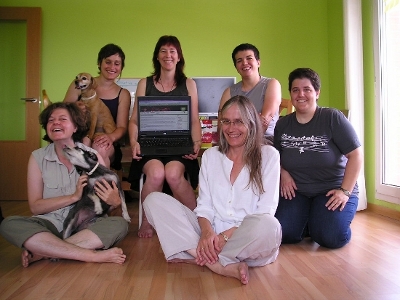
The test site was up and some of the others not present in Madrid were looking at it and trying things out. We’d solved a lot of problems but there were still a number of things not working. I had learned heaps about Drupal in the previous four days, particularly about organic groups, roles, permissions, and views. Altogether it is potentially incredibly flexible and powerful, however it takes time to work out how things need to be done and sometimes it is a confusing and circular process. Changing a setting in one place can stop something in a completely different place from working. However the combination of skills and experience between the five of us meant that usually one of us had at least an idea about how to do things and a couple of times we drew on external expertise via IRC or email.
On the last day, Agnez worked on finishing the theme while Aileen and I tried to work out why our groups are no longer displaying in the og_my view, and how to make the roles of group members visible. Donna had found that mailhandler and listhandler didn’t seem to be a practical way to integrate our mailman lists with Drupal after all – for the time being we’ll stick to the old system – and Amaia had been working on a way to create a programme for each event. The idea is that each /ETC event can be created as an organic group with the organisers having control over content and members within that group, but not being able to edit the rest of the site content. By Friday, we had this working pretty much how we wanted it.
We had planned a barbecue to celebrate the end of the workweek, but the rain prevented that. Instead, we ate inside then took turns to suffer humiliation and defeat with Wii Fitness (Amaia had clearly been practising!). In fact it wasn’t really the end of the sprint – rain again on Saturday morning meant that we decided to keep working longer and only went into the city in the afternoon, for a wander around and then the Gay Pride parade. On Sunday as we began to scatter back to our different parts of the globe, the site was still not live, as we were waiting for more feedback from testers and the finishing of the design themes. However, the site is essentially functional and should be live very soon.
The sprint process enabled us to achieve a considerable amount in a short space of time, sharing our knowledge and developing our skills. We also had great conversations over meals, explored Madrid and Colmenar Viejo, learned how to make Spanish tortilla, attempted a bit of Spanish, went swimming and did yoga. I even fitted in a performance on the first night, with Agnez, and dinner with friends another night. It’s amazing what you can do when you put the rest of your life on hold for a week; the only downside is the catching up afterwards.
Alejo Duque, Kathrin Guenter, Graham Harwood, Martin Howse, Petr Kazil, Jonathan Kemp, Martin Kuentz, Tom McCarthy, Christian Nold, Nick Papadimitriou (tbc), John Rogers (tbc), Karen Russo, Gordan Savicic, Suzanne Treister, Danja Vasiliev, Ryan Jordan
Playing Hard: Urban Art Games of Summer 2010.
Not long ago, urban games were a kind of novelty. Some grew out of the street performance tradition of live theater. Some came from gamers who were involved in tabletop RPG and wanted to experiment with live reenactment. Others were produced by media artists as a way of experimenting with new technologies like GPS and text messaging. But along with these approaches to play, and at times learning from their carefree attitude towards entertainment, there grew another tradition of the urban game, a tradition of using the city focusing on exploration, and as a specific kind of critique. At its worst, the artist produced street game replicates of hollow self-promotion, through corporate, sponsored seasonal festivals. But just as experimental art can involve an analysis of mainstream art, the urban game can embody a palatable critique of the routines of city systems, including the deadening routines of metropolitan life and some of the large scale mechanisms of corporate capitalism.
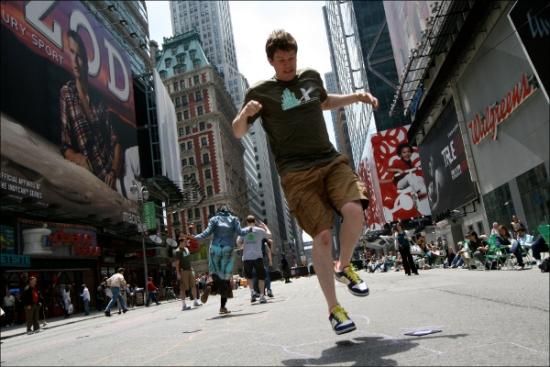
These kinds of games echo the spirit of the Situationist International, which called on artists to create alternate experiences through the construction of situations, psychogeography, and the use of play as a form of critical thinking. Urban games can also remind us of Hakim Bey and his idea of a Temporary Autonomous Zone by using goals, rules, and play with the creation of the ‘magic circle’, a world inside a world, as a method of directing public imagination towards an alternative presence, a way of acting and existing as an independent community within a larger, more repressive reality, even if only momentarily. Urban games also continue the Fluxus idea of the ‘happening’, a participatory media form in which audiences support artists, moving beyond the role of observers of performance to become collaborators in events. With the urban games season about to begin, this review takes a look at how several groups, either consciously or at times not so consciously, have interpreted these traditions for summer 2010.
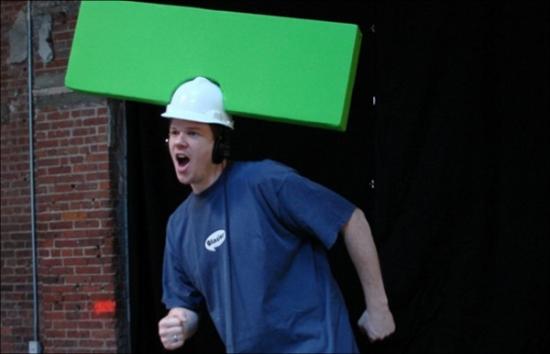
In New York, the much loved Come Out and Play Festival will run from June 4th through June 6th, with events scattered throughout the city borough of Brooklyn. Games include playground mods, GPS exploits, extreme sports, narrative quests, and massively multiplayer scavenger hunts. The festival hosts about forty game designers from around the world and about two thousand people will attend. Executive producer Greg Trefry says COaP strives to be entertaining and is not so much concerned with philosophy as it is with place: “Where the festival is located each year is actually really important to us. We look for interesting parts of the city to experiment on and use as the stage for the festival. So we’ve played everywhere from big anonymous urban areas like Times Square to now more family oriented locales like Park Slope.”
Still, the designers of COaP seem to have a way of engulfing serious issues with comedy and encouraging people reclaim neglected parts of the city by giving them a second look. Along these lines, Atmosphere Industries of Toronto will present Gentrification, a game that picks up on Brooklyn’s ongoing housing conflicts by asking players to assume the roles of real estate developers or neighborhood locals while collecting properties and gentrifying neighborhoods. Meanwhile, Gnarwhal Studios of Baltimore will sponsor ‘Humans vs. Zombies’, a modification of the playground game tag that introduces large groups of strangers to one another by sending players out into the city as the walking dead.. It’s hard to sit in a park, completely shut off from everyone around you, during a two hundred person simulation of a zombie attack. Also part of COaP, New York’s Crux Club will confront community fears of toxic contamination through their game ‘It Lurks in Gowanus’, a hide-and-seek mod that asks participants to track down a creature who has ominously escaped from legendary pollution of the neighborhood’s Gowanus Canal.
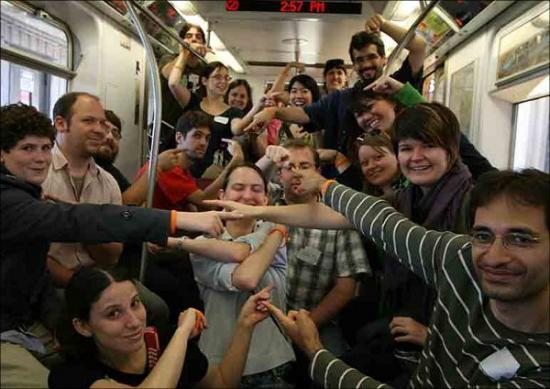
Although he agrees that all urban game events take some kind of cue from historical antecedents like the Situationist International or Fluxus, producer Trefry resists making a formal connection between these movements and COaP. Instead, he says, the main concern was and continues to be community building, getting people together in a surprising way and in an unexpected space: “At its heart, the festival is about running around outside and having fun with your friends. It sounds silly, but that’s such an amazing thing to experience.” This goal of community building has caused COaP to inspire other urban games festivals, including the Hide & Seek Festival in London and the igFest in Bristol, and the Steel City Games Fest in Pittsburgh. The organized versus the random, or the juxtaposition of the carefully designed structure of a game with the largely unstructured, seemingly arbitrary activity of ordinary public space continues to be a common interest among COaP design groups, which are likely to include engineers, academics, and urban planners alongside artists and actors.
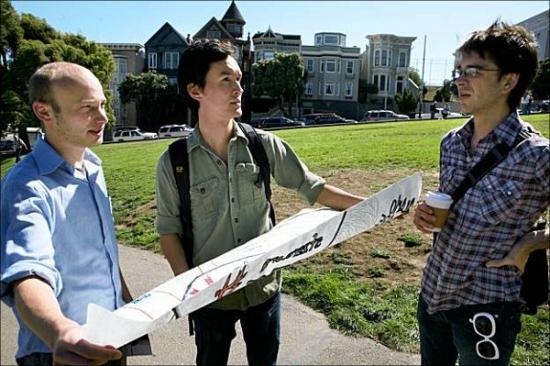
In San Francisco, the artists of SFZero cite Situationism and Fluxus as fundamental to their practice. The SFZero collective was founded by Ian Kizu-Blair, Sam Lavigne, and Sean Mahan in January 2006. Initially, the group used something like a Fluxus process of writing instructions for happening-like events that teams of other players acted out. Soon, these collaborations became the basis for both an online community and real world urban games network that now include over five thousand players. Through the SFZero website, participants initiate events by challenging other participants to ‘Eat a food that frightens you’, or ‘Go to a street corner of your choosing and wait for something fantastic to happen.’ SFZero seems to agree with classic Situationist objectives. A good game shifts awareness, Kizu-Blair says, changing the city for the people who play: ‘Oftentimes the players report that they have a completely different experience of the urban environment as a result of playing and go to places in their city where they have never been before. There is a cinematic quality whereby players live out experiences that normally exist only in spy movies – chases down dark alleys, chance meetings, etc.’ Typical SFZero tasks range from exploring overlooked locations in the city to taking a chance on meeting new people.
As fantastic as some of these instructions sound, and as important as the Internet is to SFZero’s success, Kizu-Blair says it is essential that some productions have a real world component: ‘As people become disenchanted with eight plus hours per day of screen time, they are increasingly gravitating towards hybrid activities that bridge the space between the virtual imaginary and the physical real world. These activities blend the safety and simple pleasure of screens with the risk, tension and excitement of physical interaction. More and more, members of our society will seek to escape from escapism towards an ethics of action, to escape from movies to real experiences. They will find that they have little idea how to have real experiences after their time in the imaginary. SFZero is the transition. ‘SFZero offers both real-world excitement and eternal return to the screen, to re-live, re-experience and re-imagine your engagement with reality.’
Recently, Kizu-Blair, Lavigne, and Mahan have begun staging riskier, more elaborate game events like ‘Journey To the End Of Night’, in which runners try to make it through six checkpoints on foot or by public transportation, while avoiding capture by chasers. An early version of Journey actually opened the 2006 season of Come Out and Play. This July, the veteran SFZero player Lincoln will stage a further production of Journey in Los Angeles.
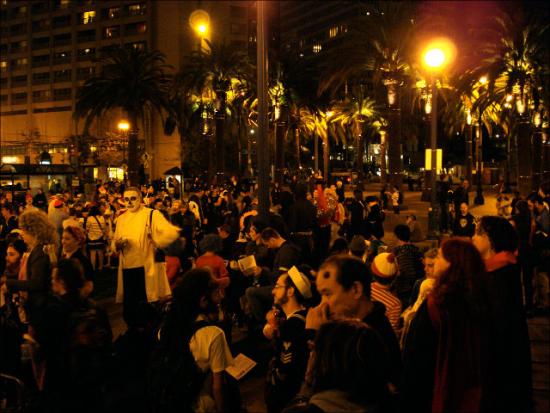
This summer, SFZero will present The Wanderers Union, a game that is loosely based on a French style of self-supported long-distance cycling called randonneuring. To perform Wanderers Union, players get a set amount of time to travel on foot and by public transportation through a series of zones. The idea is to create a single holistic experience of a urban area. The journey intends to juxtapose city spaces in ways that reveal meanings that might otherwise remain unobserved. Players who complete all of the events will progress from an initial four hour wandering to a final twenty-four hour wandering. By using play as a means of gaining understanding, participants will hopefully gain a small degree of mastery over urban space. Kizu-Blair says: ‘It’s like a video game – you level up and gain powers – but you have the added satisfaction of doing something real, and you can include anyone in the experience.’
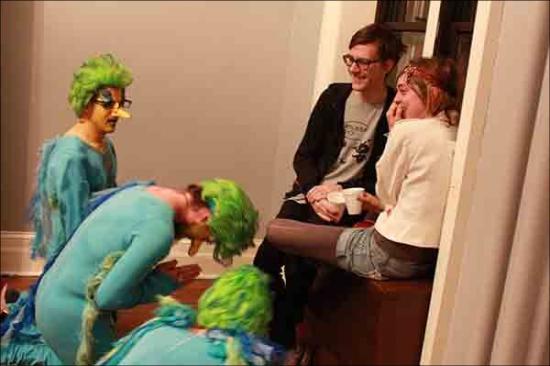
Back on the East coast, the New York based artist’s collective Opt-In found that what started as a thesis project for an experimental film class unexpectedly became a series of multimedia events that now includes filmmakers, fine artists, dancers, performers, and musicians. Titled ‘ZeroDay Exploits’, these evenings are the work of Bryn Jackson, Sarah Lerner, and Nathaniel Barker, who says the group has adapted the Fluxus concept of “happening” to the 21st century: ‘We create immersive environments in which strangers and friends can form new communities around a project, an idea, or a simple good time. We bring people from all walks of life together by promoting open dialogue and the creative expression of public discourse through a vast array of mediums and the use of public space.’
Past themes for the Opt-In exploits have included faith and technology. This July, the group plans to explore the idea of “home” by inviting guest artists and guests to contribute items and materials that evoke a sensation of home. The goal of this event is to create a sense of rootedness in New York, a city of perpetual resettlement. Another major goal for Opt-In is the deconstruction of the digital experience through live performance. According to Barker: ‘Our focus has always been on participation, so our events offer multiple means for encouraging visitors to get their hands dirty including music, secret actors to stimulate conversation, inclusive performances, and free art materials for spontaneous art creation.’
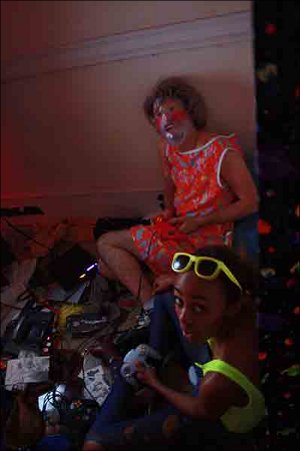
Also related to Fluxus, but in a gesture that seems more directed towards the Brazilian director Augusto Boal, a group calling themselves Invisible Playground Berlin, uses the urban game as a kind of political visualization. Founded by the artist known as Sebastian Quack Sebastian, this group’s interests lie at the intersection of theater and digital gaming. In ‘F Be I, See I A’, Invisible Playground re-enacted peer-to-peer communication as a giant game of urban capture the flag. Later, in Space Station Escape, the group simulated the release of an alien virus inside a phantom space station supposedly docked underground beneath Alexanderplatz.
Sebastian views missions and rule sets as ‘experience systems’, Games are a kind of participatory appropriation, an interrogative code that is placed over or enacted within an existing urban mechanism. In other words, if you want to get people to think more critically about the way immigration works in your city, you’d design a game that plays with the existing locations, activities, and mechanisms of immigration. In this way, Invisible Playground intends to put forward what otherwise goes unnoticed, tolerated, or is even passively accepted. Sebastian is careful to structure his rule sets in ways that highlight the power structures that arise between groups of players, between players and their environments, or between players and organizers. According to the Schwellenland site: ‘Players must work together and against each other. Over SMS and email you are guided to appointments and arrive at places where you were barred from entry until now. The game asks you to decipher who is legal, who is questionable, who can be trusted, who will trust you, who observes you, what should be ignored, what is critical. You are accompanied by a coach and by referees who left the usual national borders behind long ago and are now in Vienna as refugees without papers. These specialists can help you to master the challenges of being from a developing country. But they have also power to turn on you if you make too many errors.’

Finally, with a practice based in both New York and in Brazil, Adriana Varella is one of the artists behind the AnarkoArtLab, a collective of new-media, visual, dancers and genre benders in residence at the Living Theatre. Each month, Anarko creates a multimedia event that runs as part lab, part performance. This summer, the group plans to become mobile and to bring the Lab to different situations and neighborhoods. ‘We are searching,’ Varella says ‘for a last trace of that most ephemeral and elusive state where only a dusty dystopian haunting may yet remain. ‘Of course,’ Varella says, ‘all of them, Dada, the Situationists, Fluxus they are all our ancestors.’
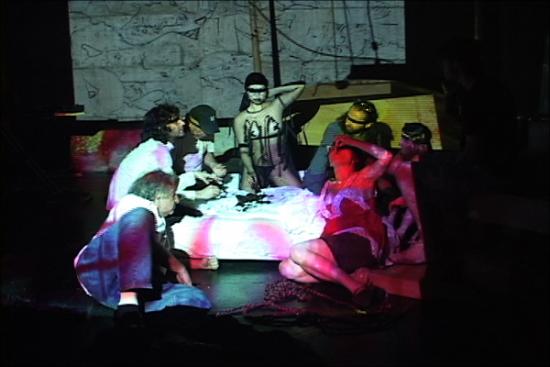
Image: SMartCAMP logo, all images courtesy of SMartCAMP
Part of New York’s Art Week, SMartCAMP, or social media art camp, took place on March 5th and 6th, at the Roger Smith Hotel in New York, a slightly unusual kind of place in that it’s a hotel with its own production company. That company’s artistic director, Matt Semler, who is also the director of The LAB Gallery, became interested in the ways Roger Smith marketers Adam Wallace and Brian Simpson were using platforms like Facebook and Twitter to build an online community. According to Semler, his curiosity “ultimately led to more questions than answers and we found ourselves wanting to bring the leaders in the social media (SM) art world together to talk about their process, goals and best practices. Once we came up with the name SMartCAMP we were pretty much off and running.” Conference organizer Julia Kaganskiy of New York’s Arts, Culture, and Technology Meet Up curated SMartCAMP’s program and a former actor, Danika Druttman, handled communications for the event.
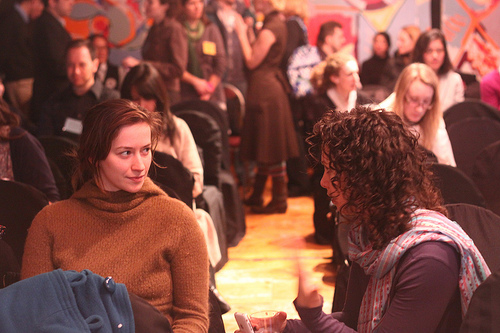
In other words, from the beginning SMartCAMP was about people, people who post, blog, tag, add, and tweet, but above all, people who meet and link up through quirky, often unpredictable, circumstances to pursue a shared idea. According to the speakers in SMartCAMP’s program, this is the kind of easy serendipity that gives social networks their authenticity and value. While these qualities can’t quite be summoned, they can be encouraged and directed. For artists and administrators, the question is how to sustain these connections to build audience and patron loyalty. Whether you like the idea of artists taking on their own distribution, or whether you find it somehow uncomfortable, social media is influential and growing. As more than one person pointed out, social networking has surpassed pornography as the number one activity on the web.
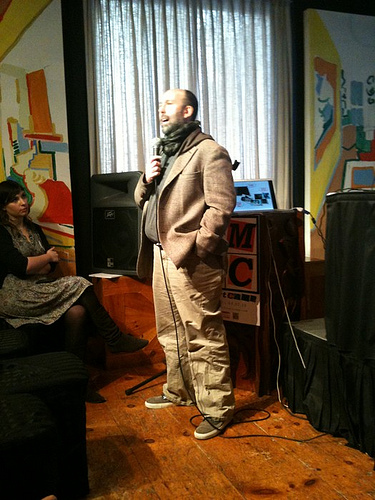
Mark Schiller’s keynote opened the Saturday session. Well-known in the New York arts community, Schiller is the founder of The Wooster Collective, a public arts site that documents street art from around the world. Like many successful online projects, Wooster Collective began accidentally. Out walking his dog in his downtown neighborhood, Schiller began photographing street art, which he then posted online, forwarding the link to friends, and asking for their reactions. Soon his web page was managing hundreds of photos, receiving thousands of hits per day, and turning artists into online celebrities. Two Wooster Collective discoveries that have gone viral are Josh Harris, famous for his subway grate inflatable dog, and Jan Vorman, an artist who uses Lego bricks to patch crumbling city walls. Today, after eight years of posts, The Wooster Collective is the online authority on street art. Schiller receives a self-sustaining five hundred emails a day from artists who have done work, or have seen work, and would like to contribute. Wooster Collective also has a YouTube channel and a Twitter feed.
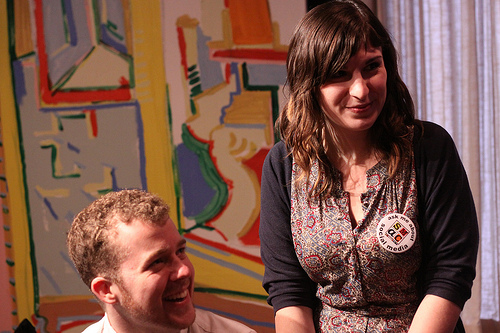
In many ways Wooster’s success seems unpredictable and non-reproducible, a fad, some kind of dumb luck. Yet, in retrospect, Schiller is able to point out specific qualities that made the site popular. First, there was page rank. Since no one was writing about street art in any other media, Wooster Collective’s art tags quickly went to the top of the search engine indexes. This kind of self-reinforcing rank allowed Schiller’s blog to get more traffic and, consequently, to pull more traffic from user searches. Second, ninety percent of the content on The Wooster Collective was original, making Schiller’s blog a feeder for other arts pages, increasing its incoming links and, again, boosting its reputation and its rank. Third, there are no ads at all on the Wooster site per se, mostly, Schiller says, because ads would be distracting both for him and his followers. Free from ads, Wooster Collective has no traffic stats to maintain, meaning Schiller is free to indulge himself in what his readers like best, Wooster’s own weird personality. On most days the site wavers slightly between media outlet and community bulletin board.
However, as important as his community may be, Schiller explained that Wooster readers are actually heavily restricted. The community is largely passive. Readers can email, but they can’t comment, upload, or see who else is online. Although some of site is user generated content, sites built on user content are notoriously second-hand and boring, so reader contributions are very heavily curated. The result is a blog that remains personal and interesting to all. Schiller also says audience building on the Wooster site has always been secondary to his main mission of sharing a passion for street art. According to Schiller, that passion is what works online and the effort to express it means a willingness to try anything. After all, Schiller reasons, “if you don’t like it, you can always stop. If a projects takes more than ten minutes to finish, stop. If it’s not fun, stop. If it’s not inspiring, stop.” Finding podcasts “not fun”, The Wooster Collective recently quit making them. They quit making mobile apps too. Schiller suspects that it is the resulting cheerfulness, lack of strain, exuberance, or even silliness, that connects an audience to a blog, a pursuit, or to an artist.
For Etsy, an online site where artists sell their work directly, community came first, web presence second. Anda Corrie, manager of Etsy’s Twitter feed, explains that Etsy was started at a time when the DIY arts culture was strong and growing, but artists still had few outlets for what they made. Etsy was one of the first sites to give them that outlet and, for a small commission, the site benefited greatly from its fortunate timing. Still, there is a balance between artist and audience that sustains Etsy and makes it work. In addition to responding to community needs, Corrie notes that the governance of sites like Etsy should be as transparent as possible. She reminds media managers rushing to reach out to remember to build a way for their readers and followers to reach in. Etsy uses a community council model. Councils change monthly, giving suggestions for improvements to the site and its forums. This is a time consuming model to attempt but, like Schiller, Corrie feels media planners who go through the motions without really getting involved are unlikely to succeed.
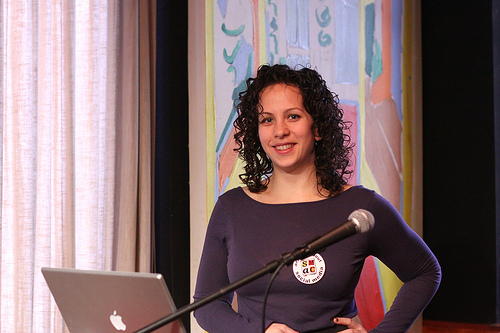
Michelle Shildkret, who represented Cake Group would say that you can’t fake what you are online, just as you can’t hire someone to “make you go viral”. She advises artists to slow down, figure out who to reach out to, where they are online, what they do when they’re online, and how someone might get their attention. When you can answer those questions, you’re ready to approach a social media plan. Shildkret also believes that a small, engaged community may be better than thousands and thousands of disinterested friends. Choose to introduce yourself and your work to places you like, make a difference there first, then advance slowly. John Birdsong of Panman Productions says artists often need to open up in exchange for popular attention. Birdsong endorses the strategy of a behind the scenes look at a studio or art process by posting “making of” videos to UStream or YouTube. These sentiments were echoed by others. Natasha Wescoat, a writer for EBSQ, the self-represented artist’s blog, became obsessed with eBay auctions as a community college student. Wescoat noticed that what honestly attracted her to an artist’s online profile was not necessarily the work. As an audience member, she also wanted personality, a connection, and some sense that there was a real person behind the presentation. Where Schiller describes a community that grows out of a shared passion, Wescoat sees community as a group centered on personality. Like Schiller, she encourages artists to try all ideas, continue with what feels right, and allow a web identity to evolve over time. For example, Wescoat describes her own online identity as an arc with three phases: experimentation, where she tried different approaches to making and selling work; narcissism, where she spent a good deal of time showing how the work was made; and establishment, where the size of her online audience is large enough to attract commissions from corporations and collectors.
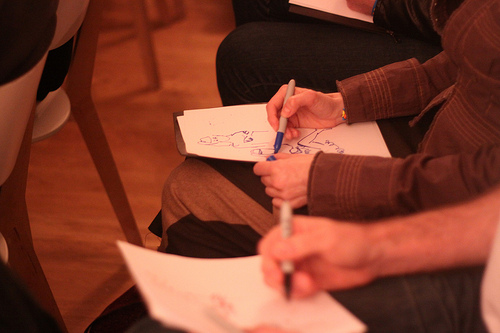
Sharpie sketch queen and self-described “art school drop out” Molly Crabapple credits her web personality as fundamental to a full-time practice that draws commissions from the New York Times and Marvel Comics. Founder of Dr. Sketchy’s Anti-Art School, Crabapple introduced her online persona by compulsively posting to LiveJournal. Today, her favorite platform is Twitter and her media tool of choice is the one hundred and forty character tweet. Crabapple likes Twitter’s immediacy and tweets to get illustration suggestions from her followers, to find emergency crash spaces, and to “manifest” anything. She advises underrepresented artists to do whatever it takes to build a following online: friend friends of friends, promise to perform humiliating stunts for your followers, tweet about everything you do, reward your one hundredth or one thousandth follower with some kind of gift, a sketch or drawing, for instance. When the earthquake struck Haiti, Crabapple tweeted for drawing suggestions, drew those suggestions live online, then auctioned those drawings off in a benefit for Doctors without Borders. Yancey Strickler who co-founded the microfunding platform Kickstarter goes a step further. Kickstarter allows artists to post projects online and request small funding pledges from their followers. These pledges remain virtual until the project pledges reach full funding. At that point, sponsors pay up, the project is funded, and Kickstarter receives five percent of the amount raised. But pledge money is not always a reflection of your project pitch, Strickler points out, saying that what succeeds online is a good narrative and a connection with the audience that feels authentic. According to Strickler, people on Kickstarter are only somewhat concerned with the quality or originality of the work in front of them. More often, their decision to contribute to an artist’s goal proceeds along the lines of questions like “Do I like this person?” or “Could I be friends with this person?”.
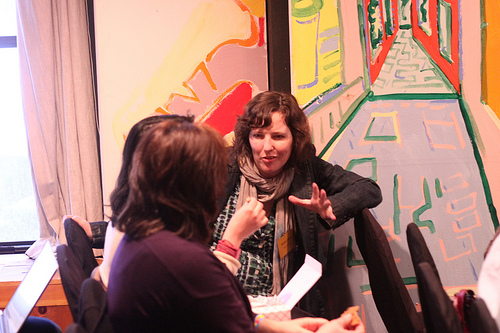
If all this sounds a bit disingenuous or self-serving, remember that social media connects artists and audiences directly and that this connection now has its own considerations. There are some dangers in its manipulation, but the benefits need to be recognized. Adam Smith of Dance Theater Workshop’s and the New York branch of the Neo-Futurists uses blogging and community choreography as forms of outreach. While there are no hard numbers for increases in audience through the blog, DTW’s paid audience has gone from sixty to eighty percent of the house. Working on getting the tools right isn’t necessarily a negative and will probably take some work. Dancer Lisa Niedermeyer says: “You can’t just be clever, you have to be smart, and that none of this has been around long enough for any of us to be wise (yet). That any one experiment can be clever, and with speed and easy access can go live, but it takes being smart for it to be sustainable.”
Niedermeyer works on Virtual Pillow, the tech initiative of Jacob’s Pillow Dance. In some ways Niedermeyer considers the company’s online presence a fourth stage: “A global, interactive space serving a virtual community that might not ever be able to physically visit us in the Berkshires of Massachusetts, but highly value our archives, performances, professional school, creative development residency programs, etc.”
A second part of Virtual Pillow’s mission is to bring the work of the company, including its history, to a wider audience via social media, streaming sites, or any other online platform. Niedermeyer attended SMartCAMP for the chance to hear other institutions and artists discuss what worked and what did not. She says the conference gave her more perspective on the strategies available to Virtual Pillow: “I felt that the conference speakers and participants were really talking about the big picture, big ideas. Gravity Rail, for example, with their passion to explode open and transform eCommerce models for artists.”
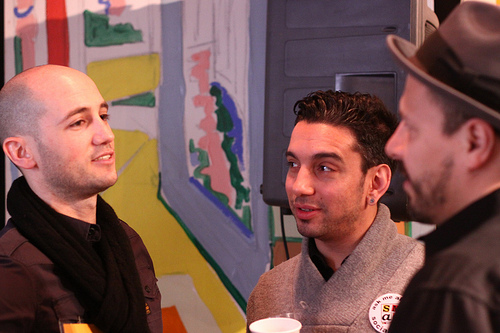
Performers are not alone in the need to link up. According to Nancy Proctor, the museum is a distributed network whether curators accept that idea or not, and agile use of social media is essential to responsive curation. Proctor heads New Media at the Smithsonian American Art Museum, a museum which now gets more visitors online than in person. Are those online visitors any less real? Should their visit be any less satisfying? Should their use of the museum be any less respected? Noting that desktop activities are increasingly moving to the mobile web, Proctor urges curators to meet visitors where they are through sms, tweets, and mobile applications.
Examples of another kind of user centered curation came from Titus Bicknell, founder of pinkink, who believes audiences and their questions now lie at the center of any program strategy. Bicknell’s examples of user centered curation included a podcast that asks visitors to enter a space, look at the art, and record any questions they might have. In this curation model, socially aware programmers ask audiences what they would like to know, rather than telling audiences what it is believed they should know. Allegra Burnette, Creative Director of Digital Media at MoMA, pointed out excellence in web presence like the Indianapolis Museum of Art’s fine arts blog ArtBabble, but added that MoMA uses Twitter feeds specifically to talk about current exhibitions at home and elsewhere. MOMA also offers podcasts on iTunesU where, Burnette says, downloads have increased about ten times this year. More and more, curation extends beyond the exhibit to the conversation about that exhibition, a conversation that defines your institution on the social web through bookmarking, favoriting, collecting, sharing, recommending, and searching. Like the Wooster Collective’s Schiller, Burnett advises media managers to avoid blatant marketing and to discuss events of interest to readers whether those events are part of a home exhibition or are occurring elsewhere.

Even in competition with Arts Week, SMartCAMP sold out. In addition to a long list of good speakers, there was a great deal of conversation and connection going on across the seats, in the halls, throughout the lobby and meeting rooms, and at the bar. Absolutely no one was asked to turn off a cell phone. Executive producer Matt Semler says: “We trended on Twitter both days and ended up with 120,000 individual views on UStream. The audience was very nicely mixed. While we don’t have any specific data on demographics my impression was that the room was evenly split between art executives and artists.”
In April, Semler and Roger Smith Arts will present a cello performance by Peter Gregson from within a Morgan O’Hara installation inside The LAB gallery space in New York. As Gregson plays, O’Hara will perform one of her “Live Transmissions” of Peter’s performance. The event will be streamed live over UStream and, as with all LAB performances, will be viewable from the street as well.
Arriving at the homepage of Ten Thousand Cents, an Internet artwork by Aaron Koblin and Takashi Kawashima, a mottled image of a one hundred dollar bill slowly fades into view. Ben Franklin looks out sedately. Mousing over the large image, the cursor is replaced with a small red rectangle. And here lays the beauty of the project; with the click of each rectangle, a zoomed in portion of the one hundred dollar bill is revealed. On the left side is a high-resolution photograph of that tiny portion of the bill. On the right side, a real-time moving image plays, revealing how the image was drawn by a human hand in a drawing program created by Koblin and Kawashima. There are, in fact, 10,000 such rectangles and each was created by a Turker through Amazon’s Mechanical Turk marketplace.
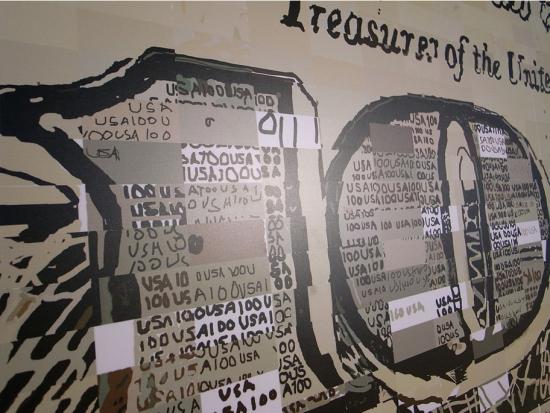
Over the course of five months (from November 2007 to March 2008) Koblin and Kawashima posted tasks, known as HITs, Human Intelligence Tasks, on Amazon’s Mechanical Turk site. Having broken down an image of a one hundred dollar bill into 10,000 sections, Turkers were tasked with redrawing their assigned section. Each Turker was paid $.01 for the task, making the total payment of drawing a one hundred dollar bill one hundred dollars. (Prints of the project can also be bought for one hundred dollars. All proceeds are donated to the One Laptop per Child (OLPC) project) Each Turker worked anonymously, unaware that what they were drawing was a section of a bill or that their work would eventually be combined with other Turkers’ work to create an art project. The variability is endless. Some Turkers methodically draw in the lines and painstakingly shade in boxes. Some quickly slash the paint tool across the page; one imagines they felt they had better things to do with their time. Some are cheeky, using the space for digital graffiti or messages like “I love U.” Most copy the image exactly. Yet, with the differing movements and tempos, every one suggests a different story and different person behind the tool. I suggest you take a few minutes and watch the unfolding scenes. They are oddly, satisfyingly banal and beautiful.
The project and its presentation on the website are undoubtedly elegant. Yet, the conceptual work behind the piece is a bit murkier. The project description states, “The project explores the circumstances we live in, a new and uncharted combination of digital labor markets, ‘crowdsourcing,’ ‘virtual economies,’ and digital reproduction.” Big and important themes. What are the implications of crowd-sourcing for creative work? For any kind of paid work? Where is the distinction between work and play? Creativity and re-presentation? In this deeply networked age, what are the evolving relations between individual and collective action?
The Mechanical Turk, made by Wolfgang de Kempelen in 1769, caused a sensation in 18th and 19th century Europe, first for its existence as a seemingly intelligent chess playing automaton – one who could beat Ben Franklin and even Napoleon in chess – and subsequently, for being an infamous hoax. Inside of the automaton was in fact a man, a skilled chess player. The Mechanical Turk was no thinking machine. It was an elaborate performance of concealment and human skill.

In 2005, in an ironic (and some might say distasteful) turn of events, Jeff Bezos of Amazon named a new business venture, Amazon Mechanical Turk. The idea was to make a digital marketplace that capitalized on the unique intelligence of human agents. Broken down into microtasks, known as HITs, Mechanical Turk provides a means to accomplish those tasks that humans can do quickly but which would take computers much longer to do, for instance, tagging images, taking surveys or transcribing audio recordings. This Mechanical Turk is also a performance of human skill, one that revels in its basis in human intelligence – Bezos calls it “artificial artificial intelligence” – but one that also operates within a mode of concealment and indeed, alienation.
As Katharine Mieszkowski of Salon wrote about Mechanical Turk in 2006, “There is something a little disturbing about a billionaire like Bezos dreaming up new ways to get ordinary folk to do work for him for pennies.” Critics of Mechanical Turk abound, and their objections point to the insidious labor relations that Mechanical Turk enforces, implying that Mechanical Turk approaches a virtual sweatshop. The system was designed for employers, not employees. The earnings of Turkers fall within a gray area of digital labor, officially being classified as contractor work, subject to high self-employment taxes and no option for benefits. Although a rating system protects employers, in so far as employers can choose to reject a work offer from a Turker or refuse to pay a Turker if the work is completed unsatisfactorily, no such system protects Turkers. As advocates of a Turker Bill of Rights have pointed out, there is no effective outlet within Mechanical Turk for Turkers to voice grievances against employers. What does exist is a vibrant community forum, Turker Nation, where Turkers advise each other on known scammers.
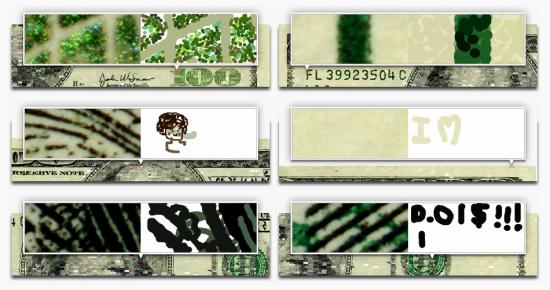
Moreover, although anecdotally Mechanical Turk is understood as more game or past-time than employment, a recent study out of University of California, Irvine’s Informatics Department points out that almost a third of Turkers rely on Mechanical Turk as a source of income. Another study found that nearly half of Turkers report their motivation for working as income related. For this population of Turkers, it is troubling to consider the possibilities of exploitation and unfair labor practices.
In this light, I find the artists’ neat appropriation of the mechanisms of Mechanical Turk unsettling. The implications and the stakes of Mechanical Turk as an economic system are left untouched. And considering that the artists chose to create a representation of money and employ Turkers, these dimensions of economy and labor are present but disappointingly unaddressed.
Yet, the moments in the project that remain in my mind’s eye like lovely specters as I glance at the dollar bill that I traded for coffee this morning, are the movements of the individuals who drew each section. On this level, the project is like a fantastic cabinet in which each drawer opens onto a new wonder. Perhaps what Ten Thousand Cents effectively offers is not a statement about labor politics or late capitalism’s continuing ability to provide structures for domination and exploitation. Perhaps Ten Thousand Cents asks us to take a different step toward understanding “the circumstances we live in,” revealing the endless variability of individual expression. In this networked age, we often act collectively, that is, together, parallel, most often without knowledge of the larger directions toward which our actions will lead. Collaboration, laboring together, is notion whose meaning is expanding and changing in the 21st century. What remains, even among protocols and code, is individuality. Though we are subsumed by larger structures, we do have spaces for self-expression and self-formulation. Leave an exploration of the limits of these spaces to others – and I surely believe we must consider the limitations. Yet we must also explore and value the spaces of possibility and the domains where we are active agents. We are called to remember that every artifact is irreducible to its mere instance in the world – it is a sum of processes and individual actions.
Of course, “the circumstances we live in” also requires us to keep in mind the bottom line. It’s all about the Benjamins, as the phrase goes. In response to a HIT, no less, requesting an answer to the question, “Why do you complete tasks in Mechanical Turk” one Turker wrote, “I do it for the money!”